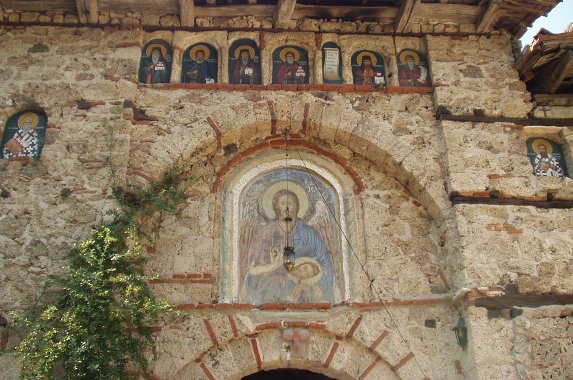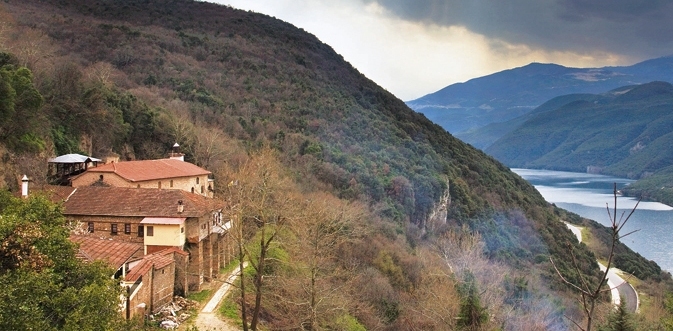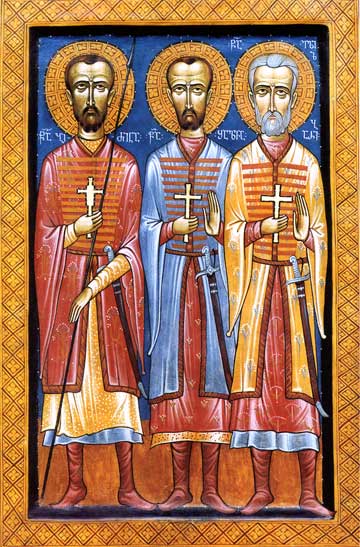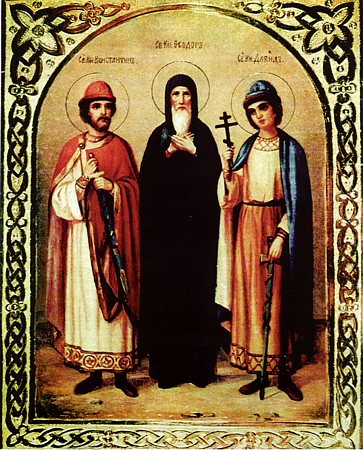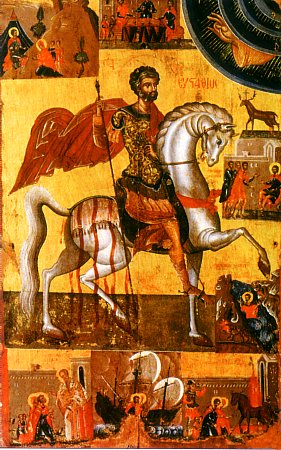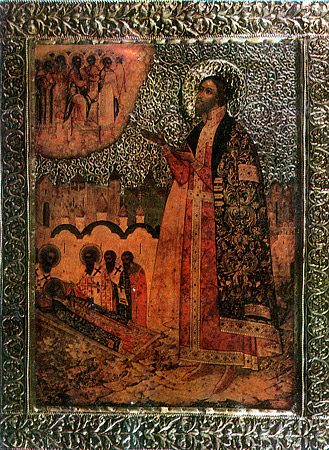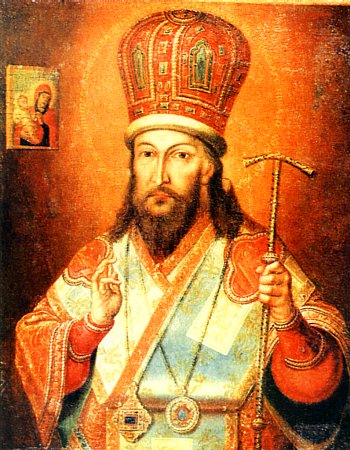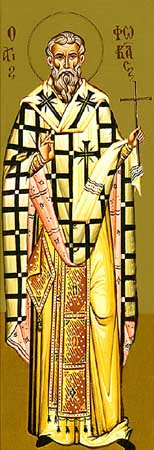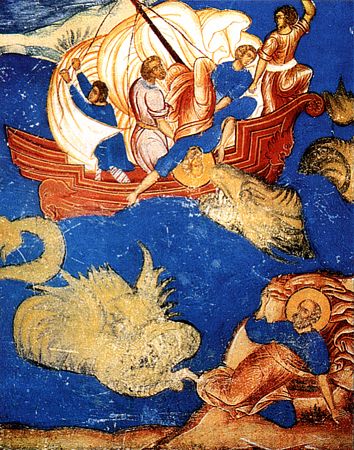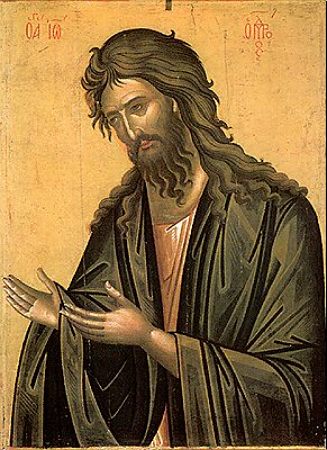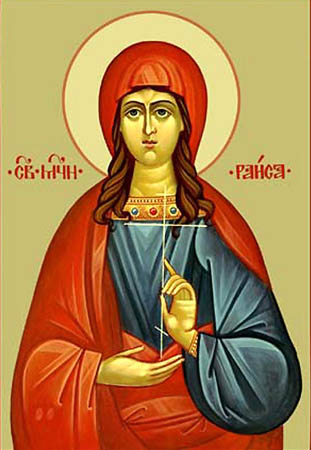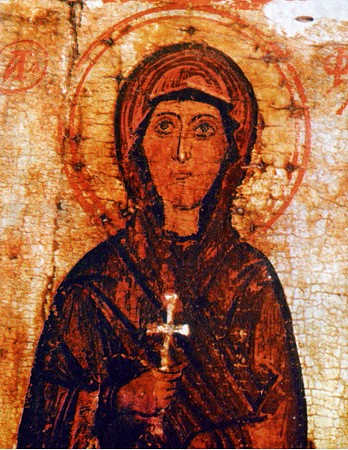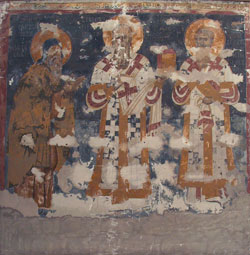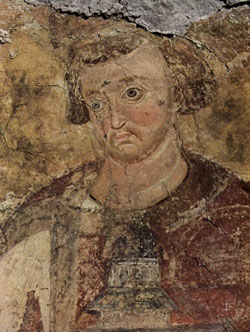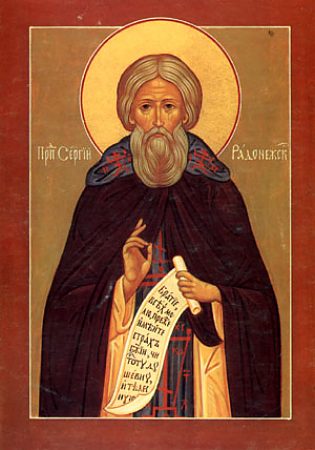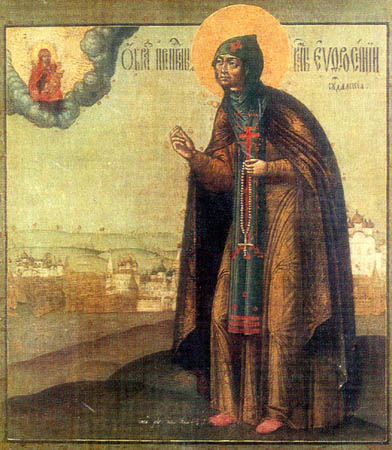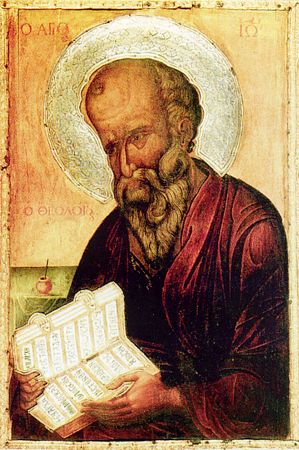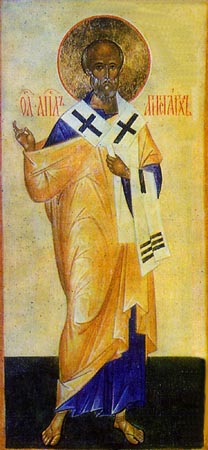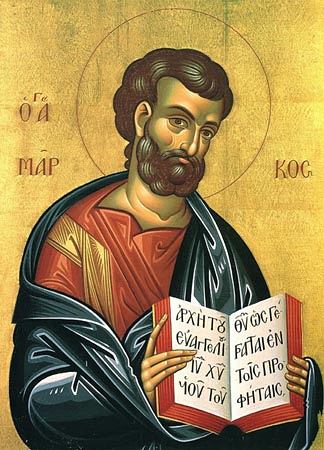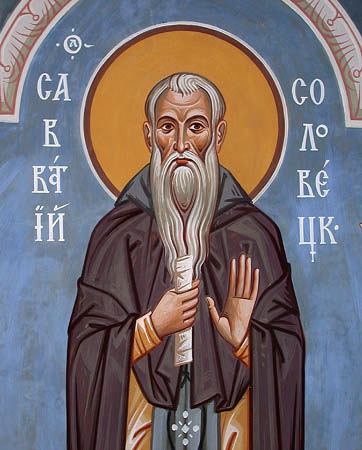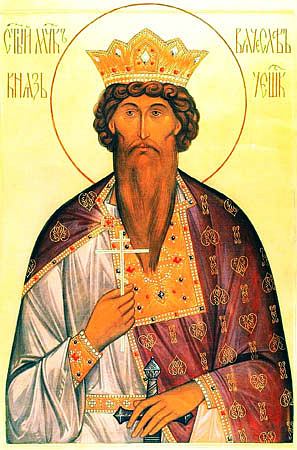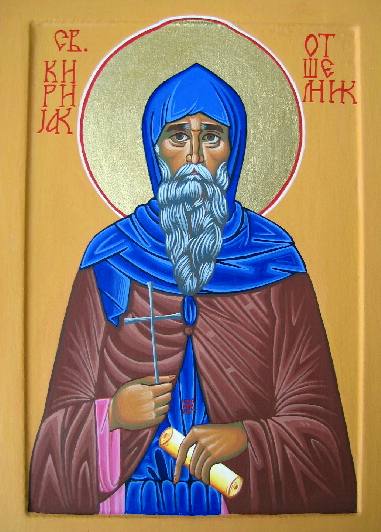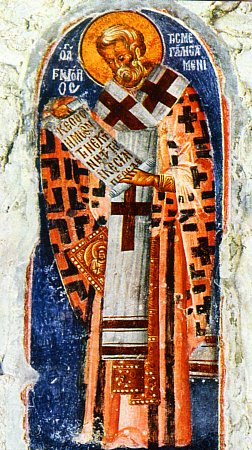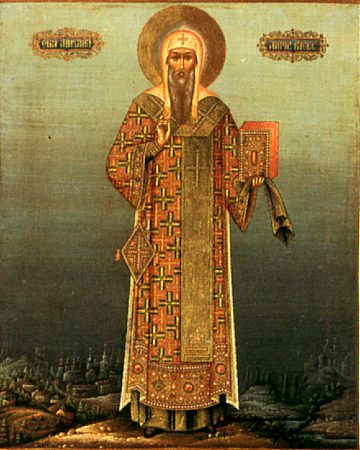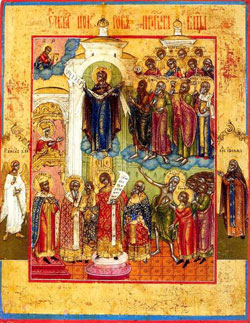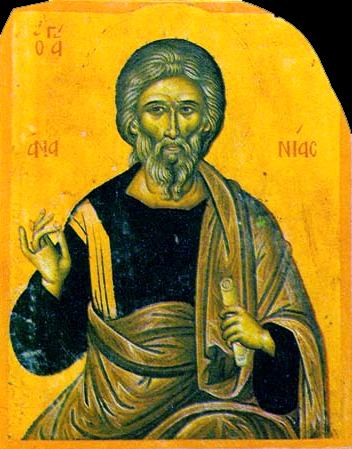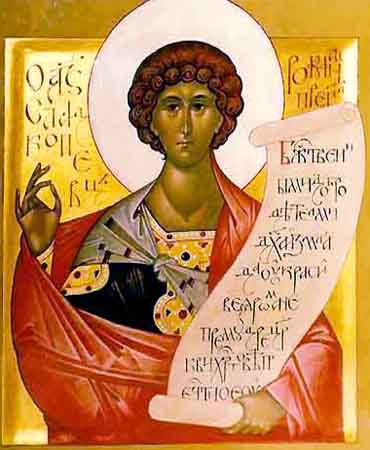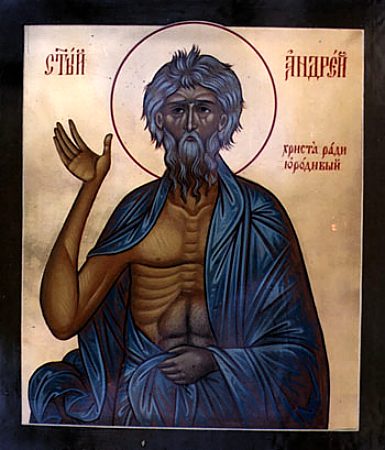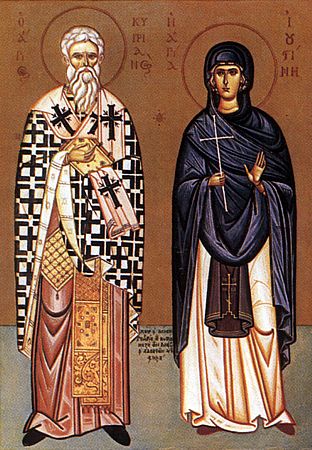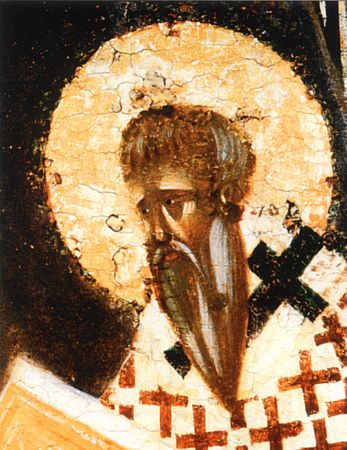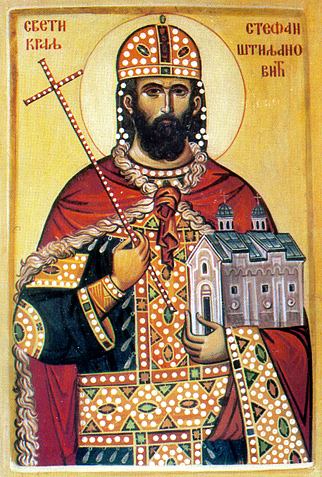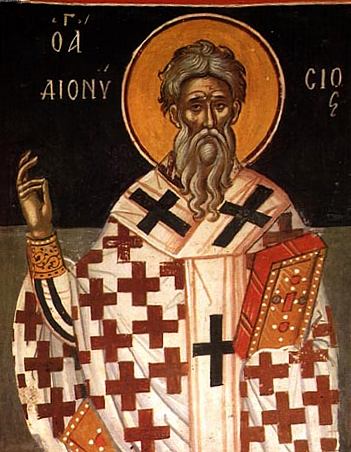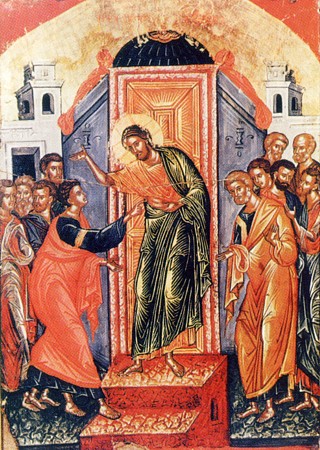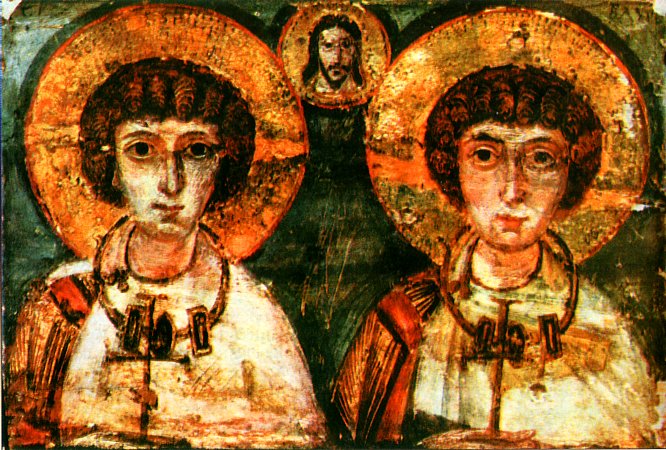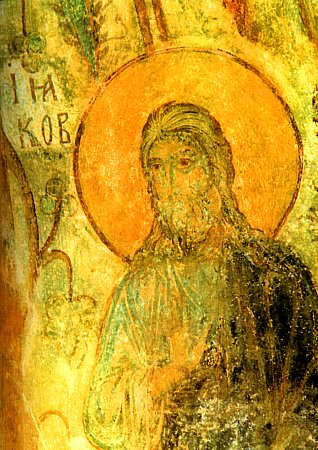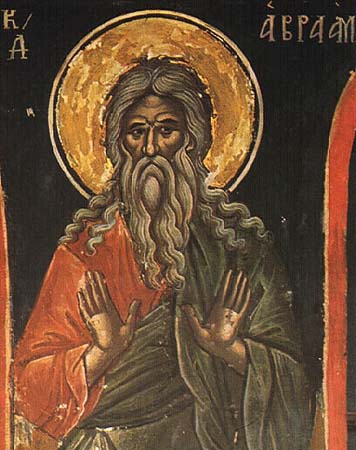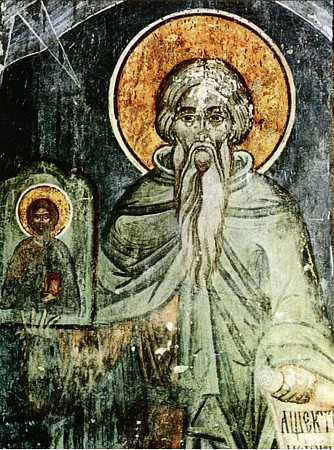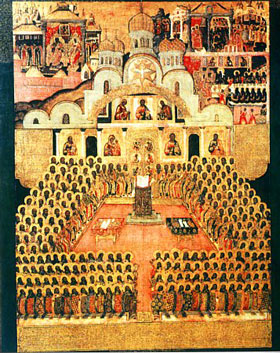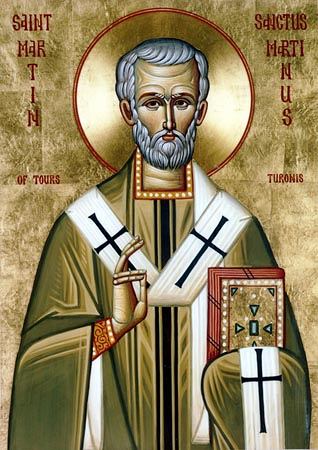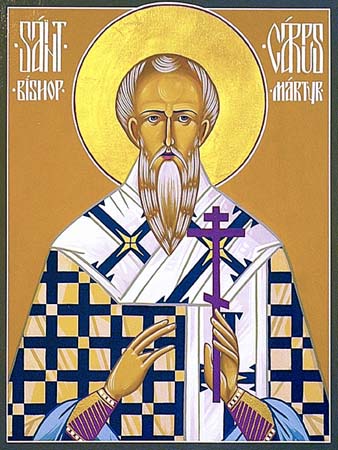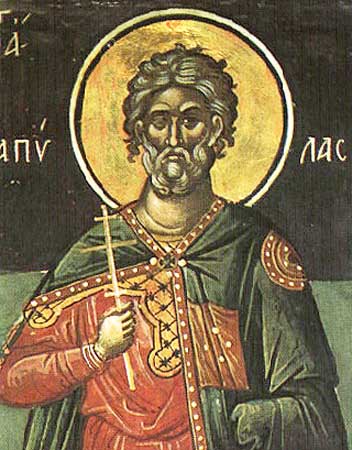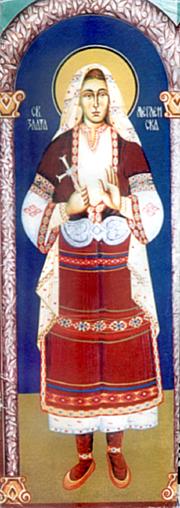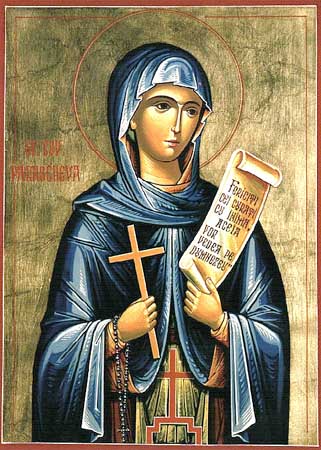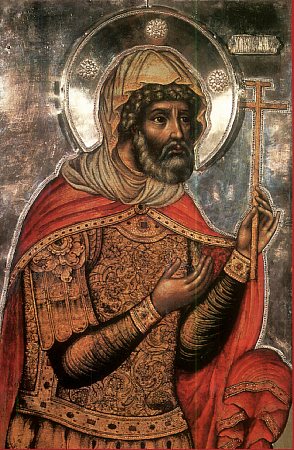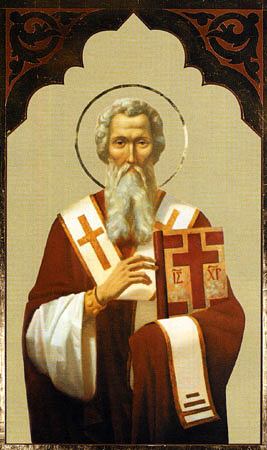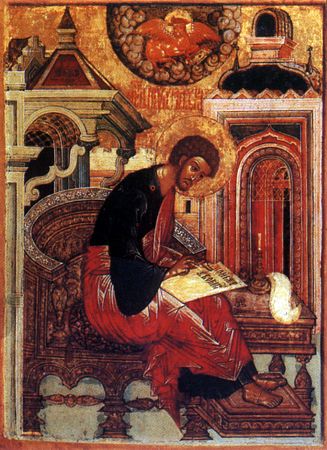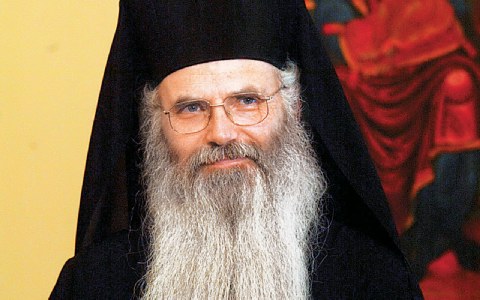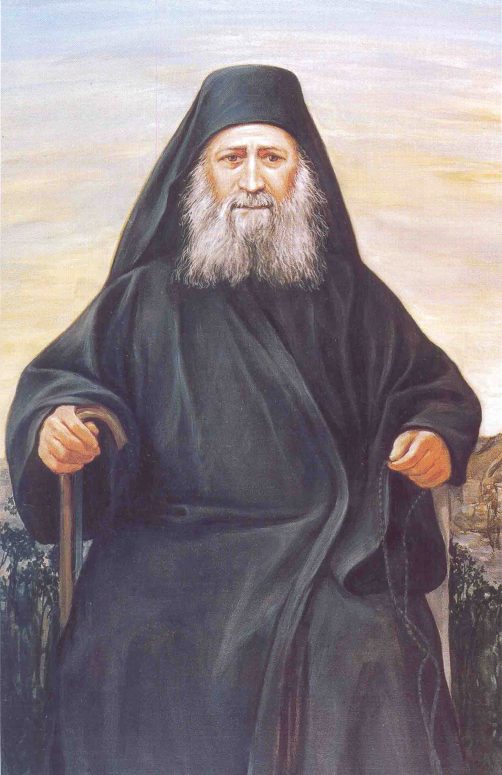Venerable Eumenes, bishop of Gortyna (7th c.)
Commemorated on September 18/October 1
The Monk Eumenios from the time of his youth was noted for his virtuous life. He strove to serve the One God and therefore he shunned worldly temptations. Concerned about salvation of soul, he distributed all his substance to the poor.
By the blessing of God the Monk Eumenios was chosen and elevated to the dignity of bishop of the Gortineia Church on the Island of Crete. The saint like a compassionate father comforted his flock in their sorrows, and cared for the orphaned and indigent.
He prayers were so strong before God, that once during the time of drought he called forth abundant rain upon the earth. Saint Eumenios wisely and zealously defended the Orthodox faith against the then arising Monophysite heresy. For his opposition to the heresy the saint was banished to the Thebaid, where he died in the VII Century. His body was then transferred and buried in Gortineia.
Martyr Ariadne of Phrygia (2nd c.)
Commemorated on September 18/October 1
The Holy Martyress Ariadna was a servant of Tertillos, a city-father of Promyssia (Phrygia) during the reign of the emperor Adrian (117-161). One time, when on the occasion of the birth of a son the master made a sacrificial offering to the pagan gods, the Christian Ariadna refused to participate in the impious solemnity. For this they subjected her to beatings, and suspending her, they lacerated her body with sharp iron hooks. Then they threw the martyress into prison and for a long while they exhausted her with hunger, demanding worship to the gods. When they released the saint from prison, she left the city, but Tertillos sent pursuers after her. Seeing that they were chasing her, she ran, calling out to God that He defend her from her enemies. Suddenly through her prayers there opened in the mountain a fissure, and Saint Ariadna hid in it. This miracles brought the pursuers into confusion and fear, and they in their depravity of mind began to strike one another with spears.
Great-martyr Prince Bidzini and Martyrs Prince Elizbar and Prince Shalva of Ksani, Georgia (1661) (Georgia)
Commemorated on September 18/October 1
The Martyrs Bidjen (Cholokashvili), Shalva and Elizbar of Xana – were Gruzian princes who liberated Kakhetia (Eastern Gruzia/Georgia) from the Persians. At the demand of shah Abbas II all three were handed over to him, with the connivance of the Gruzian emperor Vakhtang V (1658-1675), who had accepted Islam and became known under the name Shah-Navaza.
When they brought the holy captives before the shah, then at the typical interrogation they answered, that they were Christians. No one was able to force the conviction of the martyrs to change, standing firm as they did in their confession of faith in Christ. Shah Abbas, trying every which way, including promises, threats and tortures, sent Bidjen, Elizbar and Shalva to the former ruler of Kakhetia, the sultan of Aldaran, who lived then at Ispagana. The sultan, seeing their steadfastness, gave orders that after fierce tortures the heads of Elizbar and Shalva be cut off, and that this be done before the eyes of Bidjen. Bidjen he ordered as a sign of shame to be dressed in prostitute's attire and led through the city on a donkey. When even after this Bidjen wavered not in the faith, they subjected him to new lacerations and torments: his body was broken at the joints, and finally, his venerable head was cut off.
This event happened on 18 September 1660 (by other accounts, the martyrs suffered under shah Sefi, son of Abbas II, in the year 1664). The bodies of the holy martyrs were thrown out in burial pits outside the city. By night a light shone over them, streaming down from the heavens. Seeing this, local Armenians removed and secreted the holy relics in their church. After a certain while the relics were transferred to Kartalin and with reverence buried in the Ikhort monastery near the city of Hora.
Martyrs Trophimus, Sabbatius, and Dorymedon of Synnada (276)
Commemorated on September 19/October 2
The Holy Martyrs Trophymos, Sabbatios and Dorimedontos suffered for Christ during the reign of the Roman emperor Probus (276-282). One time in the city of Antioch a pagan feastday was being celebrate – the sacrificial offerings were brought, the wine was poured, and the vile acts were done. The Christians Trophymos and Sabbatios arrived in the city, and with grief looking upon this loud and indecent spectacle, they besought the Lord to guide the errant onto the way of salvation. They were arrested and taken to the governor. At the interrogation, the saints firmly confessed their faith, and to the demand that they renounce their faith, they answered with a resolute refusal. During the time of fierce tortures Saint Sabbatios died, and Saint Trophymos was sent off, for even more terrible tortures, to the city of Synnada to the governor Frigius Dionysius, infamous as a torturer and executioner. Shod in iron sandals with sharp nails, Saint Trophymos for three days went on foot, driven on by a cavalry guard. The skilled torturer used all manners of torture to break the will of the brave Christian – but Saint Trophymos merely repeated the words of Scripture: "many an affliction hath the righteous one, but from them all wilt the Lord deliver him" (Ps. 33 [34]: 20). They threw the sufferer into prison, where he was visited by a secret Christian – the senator Dorimedontos. He attended to Saint Trophymos, washing and binding his wounds. When this came to the attention of the torturers, they began to demand Saint Dorimedontos renounce Christianity, and then they threw him together with Saint Trophymos for devouring by wild beasts. But the martyrs remained untouched. Then they beheaded them with the sword.
Martyr Zosimas, hermit of Cilicia (4th c.)
Commemorated on September 19/October 2
The Martyr Zosima the Wilderness-Dweller lived during the IV Century. One time while hunting, the governor of Cilicia named Dometian caught sight of the elder, who calmly and amiably conversed with the beasts around him. Seeing the hunters, the beasts fled. They then interrogated the elder, – who was he and why did he live in the wilderness. The elder answered, that he was called Zosima, that he was a Christian, and that he was not able to live in the city with the enemies of the Lord Jesus Christ, and therefore he lived alone amongst the wild animals. Then Dometian said threateningly: "If thou dost worship the Nazarene, at Nazareth I shalt hand thee over publicly to fierce tortures, and thou wilt renounce Christ". To the question of what kind of magic Zosima used to tame wild beasts, the elder answered only: "I – am a Christian". At Nazareth the tortures began. They tied the elder head downwards, and to his neck a large stone, and they began to lacerate at his body with iron hooks. The torturers taunted the sufferer: "If the beasts do hearken unto thee, direct one of them to come forth here, and we then will believe in thine God". The holy martyr turned with a prayer to God, and suddenly an huge lion sprang forth. Everyone fled in terror, and the lion went up to the elder, and with its paw began to lift the stone, tied to the neck of the martyr. The governor began to implore the martyr to keep the lion calm, and he gave orders to untie the saint, so as to convey him off to the emperor, but Saint Zosima was already dead, having given up his pure soul to God.
St. Theodore, prince of Smolensk and Yaroslav (1299), and his children Sts. David and Constantine
Commemorated on September 19/October 2
Holy Nobleborn Prince Theodore (Feodor) of Smolensk and Yaroslavl', nicknamed the "Black" (i.e. "dark" or "swarthy"), was born in years terrible for Rus'– those of the Mongol invasion, about 1237-1239, and at Baptism he was named after the holy GreatMartyr Theodore Stratilates (Comm. 8 February), who was particularly esteemed by the Russian warrior-princes. And holy Prince Theodore also was destined by God to be famed in the Russian Land by military exploits. In the year 1239, when through the prayers of the MostHoly Mother of God, the holy Warrior-Martyr Merkurii (Comm. 24 November) delivered Smolensk from being captured by Batu, the child Theodore was not in the city: they had taken him away and hidden him in a safe place during the warfare. In the following year of 1240 died his father, prince Rostislav, who was a great-grandson of holy Prince Rostislav of Smolensk and Kiev (+ 1168, Comm. 14 March).
His elder brothers as heirs divided among themselves the lands of their father, allotting to the infant child Theodore the small holding of Mozhaisk. Here passed his childhood, and here he studied Holy Scripture, the church-services and the military art.
In the year 1260 holy Prince Theodore was married to Maria Vasil'evna, daughter of holy Nobleborn Prince Vasilii of Yaroslavl' (+ 1249, Comm. 3 July), and Theodore became prince of Yaroslavl'. From their marriage was born a son Mikhail, but Saint Theodore was soon widowed. He spent much of his time at military efforts and campaigns, and his son was raised by his mother-in-law, princess Xenia.
In the year 1277 the allied forces of the Russian princes, in union with the Tatar forces, took part in a campaign in the Osetian land and in the taking of "its famed city Tetyakov". In this war the allied forces gained a total victory. From the times of Saint Alexander Nevsky (+ 1263, Comm. 23 November), the khans of the Golden Horde – seeing the uncrushable spiritual and the military strength of Orthodox Rus', were compelled to change their attitude towards it, and they began to draw the Russian princes into alliances, and the khans then turned to them for military assistance. The Russian Church providentially made use of this drawing closer, for the Christian enlightenment of the foreigners. Already in the year 1261, through the efforts of Saint Alexander Nevsky and Metropolitan Kirill III at Sarai, the capital of the Golden Horde, there was established a diocese of the Russian Orthodox Church. In the year 1276, a Constantinople Council presided over by the patriarch John Bekkos (1275-1282) gave reply to questions of the Sarai Russian bishop Theognost about the order for baptising Tatars, and also the receiving into Orthodoxy of the Monophysite and Nestorian Christians among them. During these years also, holy Prince Theodore was at the Horde. Having distinguished himself by military exploits on the Osetian campaign, he gained special favourable attention from khan Mengu-Temir, who regarded the Orthodox Church with respect, and who as khan issued the first "yarlyk" ("decree" or "grant") about church tax-exemption for Metropolitan Kirill. In the chronicles it said: "And prince Feodor Rostislavich the emperor Mengu-Temir and his empress did favour fondly and did not want to permit him return back to Rus' on account of his bravery and the handsomeness of his face". Saint Theodore spent three years at the Horde. Finally, "the emperor did send him off with great honour", and the prince arrived in Yaroslavl'. His wife Maria had already died, and in the city ruled princess Xenia with her grandson Mikhail. The Yaroslavians would not let in the prince returning from the Horde: "not accepting him onto the city but saying to him: "this be the city of princess Xenia and Mikhailo is our prince"".
Saint Theodore had to return to the Horde. The empress, wife of khan Mengu-Temir, "did have exceedingly great fondness for him and did wish for him to give the hand of her own daughter". Such a marriage had tremendous significance for Rus'. For a long time the khan would not consent to this, considering the Russian princes to be "ulusniki" (i.e. "vassals" or "subjects"). To give in marriage his daughter to a Russian prince meant to acknowledge him as an equal in worthiness. And even more important: this meant the khan would acknowledge the primacy of Orthodoxy, since before the wedding rite of crowning it required that the Tatar princess would accept holy Baptism. The khan went along with this, since union with Russia was very important for him: "and he ordered his daughter be given to prince Feodor, and ordered first to baptise her, and he ordered the Orthodox faith not be desecrated". Thus was Saint Theodore married to the daughter of the mighty khan, who was baptised with the name Anna. "The emperor didst esteem exceedingly and commanded him be seated opposite himself, he built him a palace, and gave princes and bolyarini-nobles in retinue".
There at the Horde also were born Saint Theodore's sons – holy Nobleborn Prince David (+ 1321) and holy Nobleborn Prince Konstantin. The tremendous influence, which Saint Theodore gained at the Horde, he used to the glory of the Russian Land and the Russian Church. Orthodoxy became all the more strengthened amongst the Tatars, and the Horde began to assimilate Russian customs, morals and piety. Russian merchants, architect-builders and skilled craftsmen carried Russian culture to the shores of the Don, the Volga, the Urals and farther even into Mongolia itself. From this period archeologists find Orthodox icons, and crosses and lampadas, throughout all the former territories of the Golden Horde, since included into the makeup of Russia. Thus began a great missionary movement of the Russian Church towards the East, and the enlightening with the light of the Gospel truth of all the tribes – all the way to the Great Ocean (i.e. the Pacific). Russian Orthodox princes and their retinues, participating as confederates in the Mongol campaigns, learned of and became familiar with the boundless expanses of Asia, Siberia and the Far East. In the year 1330, more than thirty years after the death of Saint Theodore, Chinese chronicles write about Russian retinues in Peking.
Saint Theodore lived in Sarai until 1290, when "news reached him from Rus', from the city of Yaroslavl', that his first son, prince Mikhail, had died". Having bestown the prince rich gifts and a large retinue, the khan sent him back to Rus'. Having become again the prince at Yaroslavl', Saint Theodore began zealously to concern himself over the strengthening and building up of his city and principality. He had an especial love for the monastery of the Transfiguration of the Lord. His fame resounded throughout all Rus', and all the princes sought friendship and alliance with him. But most of all, he was fond of the son of Saint Alexander Nevsky, – Andrei Aleksandrovich, supporting him in all undertakings, and when this prince Andrei became great-prince of Vladimir, he went with him on military campaigns; he was gladdened over the victories, and he grieved over his being cut down in defeat. In 1296 a bloody fratricidal war was just breaking out between two groups of princes: on the one side was Saint Theodore and Great-prince Andrei, and on the other side – Saint Michael of Tver (+ 1318, Comm. 22 November) and Saint Daniel of Moscow (+ 1303, Comm. 4 March). But with the help of God the bloodshed was successfully averted. At a Vladimir "sitting of princes" (year 1296) the Vladimir bishop Simeon and the Sarai bishop Izmail managed to bring peace to both sides. This fact, that holy Prince Theodore and the Sarai Vladyka Izmail participated in the sitting, points out that Saint Theodore employed all his diplomatic talents and influence at the Horde, to enable the establishing of peace in the Russian Land.
The connections of Saint Theodore the Black with his paternal origins – Smolensk, were not sundered, though for him to be prince there would have been complicated. Thus, in the year 1297, Saint Theodore went on a campaign to Smolensk to renew his lawful right to the Smolensk principality, which had been usurped by his nephews. But to take the city and become anew the Smolensk prince did not transpire.
Soon after this campaign the holy warrior-prince took sick. On 18 September 1299 the saint of God gave orders that he be carried to the Saviour-Transfiguration monastery, and there he took monastic tonsure. Towards the end of the ritual, Saint Theodore asked to interrupt the service. With the blessing of the hegumen, and to fulfill the will of the dying prince, they carried him into the monastery courtyard, whither had already come a throng of the Yaroslavl' people. "And the prince did confess before all the people, whether he had sinned against anyone or held ill-feelings against anyone. And whoever had sinned against him or borne him enmity – he blessed all and begged them pardon and in everything took upon himself the guilt before God and mankind". Only after this did the humble warrior complete his resolve to finish his unusual and much-troubled life's path with the acceptance of the angelic form.
All night the hegumen and the brethren prayed over the holy prince. At the second hour of the night they began to ring for matins. Administered the Holy Mysteries of Christ, Saint Theodore lay silently upon his monk's cot. When the monks began the third "Glory" of the Psalter, he made the sign of the Cross and gave up his soul to the Lord. His appearance at the grave was extraordinary: "Wondrous indeed was the look of the blessed one, upon the cot lay he not as one dead, but as one actually alive. His face did shine like as the rays of the sun, adorned by his venerable grey of hair, witnessing to his purity of soul and heart without malice".
After him at Yaroslavl' ruled his son – Saint David (+ 1321). The second of his two younger sons, Konstantin, had evidently died earlier. The Church veneration of holy Prince Theodore within the Yaroslavsk lands began soon after his death. During the years 1322-1327, with the blessing and commissioning of the Rostov bishop Prokhor, – in memory by the Vladyka of the venerable Saint Theodore, – there was written and adorned with miniatures the reknown Theodorov Gospel. Bishop Prokhor at first had been hegumen of the Saviour-Transfiguration monastery at Yaroslavl'. Actually, he knew the holy prince personally, and was able to be an eye-witness at his tonsure and public repentance before the people. Historians think, that the fine miniatures, sewn into this precious manuscript, had belonged to a rather earlier Gospel, the owner of which had been Saint Theodore the Black himself, and which he had brought with him to Yaroslavl' as a blessing from his native Smolensk.
On 5 March 1463, there were opened at Yaroslavl' the relics of holy Prince Theodore and his sons, David and Konstantin. The chronicler, an eye-witness to the event, recorded under the year: "At the city of Yaroslavl' in the monastery of the Holy Saviour they did bring up three great princes, prince Feodor Rostislavich and his sons David and Konstantin, and above the ground they did lay them. Great-prince Feodor was a man of great stature, and of his sons David and Konstantin they did lay them alongside, and their stature was less than his. They did lay within a single grave". This feature of the physical appearance of the holy prince so struck the senses of the eye-witnesses and those present at the time of the uncovering of the relics, that an account of this was entered into the Prologue's Saints-lives concerning Saint Theodore, and also into the text of the Iconographic Originals.
The Life of holy Prince Theodore the Black was written, shortly after the uncovering of the relics, by the priest-monk Antonii of the Yaroslavsk Saviour monastery, with the blessing of the Metropolitan of Moscow and All Rus', Philip I. Another redaction of the Life was written by Andrei Yur'ev at the Kirillo-Belozersk monastery. A third and most detailed Life of Saint Theodore was included in the "Book of Ranks of Imperial Geneology", compiled under tsar Ivan the Terrible and metropolitan Makarii. The Russian people put together spiritual songs about holy Prince Theodore, which over the span of centuries they sang in "the destitute wanderings". In them, the verses glorify the piety and the right-discernment, the beneficence and kind-heartedness of the saint, and his concern over the building and adorning of churches. The complexity of historical destinies, the roughness of the era, the numerous multitude of enemies – not personal, but enemies of Russia and the Church, – stress for us all the more clearly the great exploits of the saintly builders of the Russian Land.
Great-martyr Eustathius (Eustace) Placidas, his wife Martyr Theopistes, and their children Martyrs Agapius and Theopistus, of Rome (118)
Commemorated on September 20/October 3
The Holy GreatMartyr Eustathius before Baptism had the name "Placidus" [meaning "placid" or "calm" in Latin]. He was a military commander under the emperors Titus (79-81) and Trajan (98-117). Even before he came to know Christ, Placidus did acts of charity, helping the poor and destitute. And the Lord deigned not to leave the virtuous pagan remain within the darkness of idol-worship.
One time ahunting he chased upon his speedy mount after a stag, which halted its run atop an high hill, and Placidus suddenly saw amidst its antler-rack a radiant Cross, and upon it – the Crucified Son of God. In surprise Placidus heard a voice saying: "Why pursuest thou Me, Placidus?""Who art Thou, Master, Who dost speak with me?"– in fright asked Placidus. In reply he heard: "I – am Jesus Christ, God, Who wast incarnated for the salvation of mankind and didst endure voluntary suffering and death by the Cross. Thou honourest Me even without knowing Me, since thy good deeds and abundant alms art come to Me. I have appeared here, to convert and to conjoin thee unto Mine true servants. For I want, that the man working righteous deeds, shouldst not perish in the snares of enemies".
Placidus cried out: "Lord, I do believe that Thou – art the God of Heaven and earth, the Creator of all creatures. I beseech Thee, O Master, teach me what I should do". And again resounded the Divine voice: "Go thou unto the Christian priest, receive from him Baptism, and he wilt instruct thee unto salvation".
With joy Placidus returned home, and told everything to his wife. She in turn told him, how the evening before in a mysterious dream-vision she had been told: "Thou, thy husband and thy sons on the morrow shalt come unto Me and know Me – Christ Jesus, the True God, sent unto the salvation of those that do love Me". The spouses then proceeded to do as they had been bidden.
They hastened to the Christian presbyter, who baptised all their family, and communed all with the Holy Mysteries.
On the following day Saint Eustathius set out to the place of his miraculous conversion and in fervent prayer he offered up thanks to the Lord, for having called him onto the path of salvation.
And again Saint Eustathius was vouchsafed a miraculous revelation – the Lord Himself foretold him about impending tribulations: "Eustathius, thou mustneeds prove thine faith in deeds. Before thee, like unto Job, art many a sorrow, so that being put to the test like gold in the forge, thou be shewn worthy of Me and receive the crown from My hands". Saint Eustathius humbly answered: "Thy will be done, O Lord. I am prepared to accept all things at Thine hands with gratitude, but let Thine almighty help be with me".
Soon Saint Eustathius was plunged into misfortune: all his servants died and his cattle perished. Brought to ruin, but not despairing in spirit, Saint Eustathius with his family secretly abandoned their home, to live unknown, humble and in poverty. He set off on a ship to Egypt. During the time of sailing a new woe beset the saint. The ship owner, enchanted by the beauty of the wife of Eustathius, cruelly set him ashore with his children, keeping the wife for himself. In great grief the saint continued on his way, and new woe beset him. Crossing a tempestuous river ford, he went to carry in turn his two sons, but when he had carried across the one, the other on shore was seized by a lion and carried off into the wilderness, and while he returned towards the other, a wolf dragged that one off into the forest.
Having lost everything, Saint Eustathius wept bitterly. But he realised, that Divine Providence had sent him these misfortunes, to test his endurance and devotion to the will of God. In prayer lifting up to God his inconsolable grief, Saint Eustathius went on further, prepared for new tribulations. In the village of Badiss he found work and spent five years in unremitting toil. But Saint Eustathius did not then know, that through the mercy of God shepherds and farmers had saved his sons, and they lived right nearby him; he also did not know, that the impudent shipowner was soon struck down – he died from a terrible disease, and the wife of Saint Eustathius had been left untouched, and she lived at peaceful work.
During this time period it had become difficult for the emperor Trajan to levy an army for Rome. He then remembered the valiant regimental commander Placidus and dispatched Antiochus and Acacius, friends of Placidus, to find him.
Having gone round a multitude of places, finally they arrived in the village, where Saint Eustathius lived. The soldiers came upon Eustathius in a field, where he was guarding the bread-grain, but they did not recognise him and they began to tell him about the one whom they sought, asking his help and promising a large reward. But Saint Eustathius, immediately recognising his friends, did not reveal to them his identity. He brought them to the home of his master and fed them. Gazing at him, the travellers noted that he very much resembled their regimental commander, and when they saw on his knee a peculiar mark – the scar from a deep war wound, they realised that in front of them – was their friend. They hugged him with tears and said why they were seeking him. Saint Eustathius returned to Rome and again became an imperial commandant. Many a new recruit entered the army for him, and he did not know, that the two young soldier-friends, to whom he often gave orders and whom he loved for their skill and daring, were actually his own sons, and they did not know, that they were serving under the command of their own father, nor that they each the other – were brothers by birth.
One time while on campaign the army, led by Eustathius, halted at a certain settlement. The soldier-brothers were talking in their tent. The elder one spoke about his lot: how he had lost his mother and hapless brother, and how in a terrifying way he had been parted from his father. And the younger brother with joy realised, that in front of him was his very own brother, and told him so and also about himself.
A woman overheard the soldiers' conversation – their tent was pitched right next to her house – and this woman was their mother! She realised that these were her sons. Still not yet identifying herself to them, and not wanting to be separated from them, she went to their commander – Saint Eustathius, to ask permission to follow along with his army. And this commander she recognised as her husband, and with tears she told him about herself and about the two soldiers, who were actually their sons. Thus, through the great mercy of the Lord, the whole family was happily reunited.
Soon thereafter the war ended in victory. Saint Eustathius returned to Rome with honours and glory. The emperor Trajan had since died, and his successor Adrian (117‑138) wanted to celebrate the event of victory with a solemn offering of sacrifice to the gods. To the astonishment of everyone Saint Eustathius did not show up at the pagan temple. By order of the emperor they searched frantically for him.
"Why wishest thou not to worship the gods? – enquired the emperor, – It becomest thee before all others to offer up thanks unto them. They not only preserved thee in war and granted thee victory, but also they did help thee find thy wife and children". Saint Eustathius replied: "I – am a Christian and I know as the One God Christ Jesus, I revere and give thanks to Him, and I worship Him. He hath given me everything: health, victory, He returned my family and hath sent down His help unto the overcoming of tribulations".
In a rage the emperor stripped him of his rank and summoned him with his family to trial. But there also they did not succeed in swaying the steadfast confessors of Christ into offering sacrifice to idols. The whole family of Saint Eustathius was sentenced to be torn apart by wild beasts. But the beasts would not touch the holy martyrs. Then the cruel emperor in his wrath gave orders to throw them all alive into a red-hot copper ox, and here Saint Eustathius, his wife Theopistia and their sons Agapius and Theopistus, accepted a martyr's end. Three days later they opened the fiery grave, and the bodies of the holy martyrs were found unscathed – not one hair on their heads was singed, and their faces shone with an unearthly beauty. Many seeing this miracle came to believe in Christ. Christians then gave burial to the bodies of the saints.
Holy Martyr and Confessor Michael and his councilor Theodore, wonderworkers of Chernigov (1245)
Commemorated on September 20/October 3
![]()
The Holy Nobleborn Prince of Chernigov Michael, son of Vsevolod Ol'govich the Dark-Red (+ 1212), was noted from childhood for his piety and mildness. He had very poor health, but hoping on the mercy of God, the young prince in 1186 besought the holy prayers of the Monk Nikita of Pereyaslavl' the Pillar-Dweller (Comm. 24 May), who during these years received reknown by his prayerful intercession before the Lord. Having received a wooden staff from the holy ascetic, the prince at once was healed. In 1223 noble prince Michael took part in a meeting of Russian princes at Kiev, deliberating the question of whether to aid the Polovetsians against the approaching Mongol-Tatar hordes. With the perishing in the Battle at the Kalka River in 1223 of his uncle, Mstislav of Chernigov, Saint Michael became prince of Chernigov. In 1225 he was invited to be prince for the Novgorod people. Through his sense of justice, compassion and firmness he gained the love and respect of Old Novgorod. This was particularly important for the Novgorodians, in that the ascent of Michael as prince signified a reconciliation of Novgorod with the city of Vladimir holy nobleborn GreatPrince Georgii Vsevolodovich (Comm. 4 March), the wife of whom was the holy princess Agathia, sister of prince Michael.
But Saint Michael did not long remain prince at Novgorod. He soon returned to his native Chernigov. To the stipulations and requests of the Novgorodians to remain prince he answered, that Chernigov and Novgorod ought to become kindred lands, and their inhabitants – like brothers, and he would forge the bonds of friendship of these cities.
The noble prince assiduously concerned himself with the building up of his appenage realm. But it was difficult for him in these troubled times. His activity provoked unease in the Kursk prince Oleg, and in 1227 internecine strife nearly erupted – save that the Kiev metropolitan Kirill (Cyril, 1224-1233) reconciled them. And in this same year prince Michael peacefully resolved a dispute between the Kiev GreatPrince Vladimir Rurikovich and the Galich prince.
In 1235 noble prince Michael occupied the Kiev great-princely throne.
Troublesome times ensued. In 1238 the Tatars (Mongols) laid waste to Ryazan, Suzdal', Vladimir. In 1239 they moved against South Russia, and ravaged the left-bank of the Dniepr River, the Chernigov and Pereyaslavl' lands. By autumn of 1240 the Mongols were coming nigh to Kiev. The khan's emissaries proposed that Kiev surrender voluntarily, but the noble prince would not negotiate with them. Prince Michael rode urgently to Hungary, to persuade the Hungarian king Bela to organise allied forces to resist the common enemy. Saint Michael tired to recruit into the struggle against the Mongols both Poland, and the German emperor. But the moment for a combined resistance was lost: Rus' was devastated, and later in turn Hungary and Poland. Having received no foreign support, noble prince Michael returned to the ruins of Kiev and for a certain while he lived not far from the city on an island, and then he resettled to Chernigov.
The prince did not abandon hope in the possibility of an united Christian Europe against the Asiatic nomads. In 1245 at a Lyons Council in France was present as emissary, sent by Saint Michael, his co-worker the metropolitan Peter (Akerovich), calling for a crusade to march against the pagan Horde. Catholic Europe in the persons of its chief spiritual leaders, the Roman pope and the German emperor, betrayed the interests of Christianity. The pope was involved in a war with the German emperor, and the Germans indeed took advantage of the Mongol invasion, to attack Rus' themselves.
In these circumstances affecting Christianity in general, there is an universal significance to the confessor's deed of the Orthodox prince-martyr Saint Michael of Chernigov amidst the pagan Horde. In Rus' soon appeared emissaries of the khan, in order to carry out a census of the Russian population and to impose tribute-taxes upon it. From the prince was demanded full submission to the Tatar khan, and for his princely realm – the khan's special permission of a charter ("yarlyk"). The emissaries informed prince Michael, that it was necessary for him to set off in journey to the Horse for an affirmation of rights to rule the princedom under the khan's yarlyk. Seeing the woeful plight of Rus', noble prince Michael recognised the need to obey the khan, but as a fervent Christian he knew, that he would not abjure his faith before the pagans. From his spiritual father, the bishop John, he received blessing to journey to the Horde and be there a true confessor of the Name of Christ.
Together with holy prince Michael on the journey to the Horde went his faithful friend and companion, the boyar-noble Theodore (Feodor). At the Horde they knew about the attempts of prince Michael to organise an uprising against the Tatars concurrently with Hungary and the other European powers. His enemies had long sought the opportunity to destroy him. In 1246 when noble prince Michael and the boyar Theodore arrived at the Horde, they were ordered on how to go to the khan, to proceed through a flaming bon-fire, to cleanse them of their evil intents, and to worship the primal-elements considered gods by the Mongols: the sun and fire. In answer to the pagan-priests commanding them to perform the pagan rituals, the holy prince replied: "A Christian doth worship only God, the Creator of the world, and not creatures". They reported to the khan about the unyielding of the Russian prince. Batu's attendant El'deg delivered the conditions: either fulfill the demands of the pagan priests, or die unyielding in torments. But this also was followed by the resolute answer of holy prince Michael: "I am prepared to submit to the emperor, since that God hath entrusted him with the destiny of the earthly kingdoms, but as a Christian, I cannot worship idols". The fate of the brave Christians was sealed. Taking courage in the words of the Lord: "Whoso wouldst to save their soul, shalt lose it, and whoso shalt lose their soul for My sake and the Gospel, that one wilt save it" (Mt. 8: 35‑38), the holy prince and his devoted boyar prepared for a martyr's end and communed the Holy Mysteries, which their spiritual father foreseeing this gave them. The Tatar executioners seized hold of the noble prince and for a long time they beat him fiercely, until the ground ran crimson with blood. Finally one of the apostates from the faith in Christ, by the name of Daman, cut off the head of the holy martyr.
To the boyar Saint Theodore, if he were to fulfill the pagan ritual, the Tatars deceitfully began to promise the princely honours of the martyred sufferer. But Saint Theodore was not swayed by this – he followed the example of his prince. After quite vicious torments they beheaded him. The bodies of the holy passion-bearers were thrown for devouring by dogs, but the Lord miraculously guarded them for several days, until faithful Christians could secretly bury them with reverence. Later on the relics of the holy martyrs were transferred to Chernigov.
The confessor's act of Saint Theodore amazed even his executioners. Persuaded of the steadfast keeping to the Orthodox faith by the Russian people, and their readiness to die with joy for Christ, the Tatar khans decided not to try the patience of God as before, and they ceased demanding of Russians at the Horde any outright fulfilling of pagan rituals. But the struggle of the Russian nation and the Russian Church against the Mongol Yoke continued for yet a long time. The Orthodox Church was embellished in this struggle by new martyrs and confessors. GreatPrince Theodore (Feodor, + 1246) was poisoned by the Mongols. Also martyred were Saint Roman of Ryazan (+ 1270), Saint Michael of Tver' (+ 1318), his sons Dimitrii (+ 1325) and Alexander (+ 1339). All of these took courage at the example and holy prayers of the Russian FirstMartyr at the Horde –Saint Michael of Chernigov.
On 14 February 1572, at the wish of tsar Ivan Vasil'evich the Terrible, and with the blessing of the metropolitan Antonii, the relics of the holy martyrs were transferred to Moscow, into the temple dedicated to their name. From there in 1770 they were transferred into the Visitation (Sretenie) cathedral, and on 21 November 1774 – into the Archangel cathedral of the Moscow Kremlin.
The Lives and service to Saints Michael and Theodore were compiled in the mid‑XVI Century by the reknown church writer, the monk Zinovii of Otonsk.
"The lineage of the righteous wilt be blest", – says the holy Psalmodist David. This occurred in full measure for Saint Michael. He is at the head of many a famous family-line in Russian history. His children and grandchildren continued with the holy Christian service of Saint Michael. The Church enumerated to the ranks of the saints his daughter – the Nun Evphrosynia of Suzdal' (Comm. 25 September), and his grandson – holy nobleborn Oleg of Bryansk (Comm. 20 September).
New Martyr Hilarion of Crete (Mt. Athos) (1804)
Commemorated on September 20/October 3
Born on the island of Crete, he, being light-headed, accepted Islam in Constantinople, but soon deeply repented and, prepared for torture, fearlessly confessed Christ before the Turkish judges. After severe torture for Christ he was beheaded in the year 1804.
Apostle Quadratus of the Seventy (130)
Commemorated on September 21/October 4
The Holy Disciple from the 70 – Codratus preached the Word of God at Athens and at Magnezia (eastern peninsula of Thessaly), and was bishop of Athens. He converted many pagans to the true faith in Christ the Saviour. His preaching aroused the hatred of unswayable pagans. One time an angry mob fell upon the disciple to pelt him with stones. Preserved by God, the Disciple Codratus remained alive, and they threw him into prison, where he died from starvation. His holy body was buried in Magnezia.
In the year 126 the Disciple Codratus wrote an Apologia in defence of Christianity. Presented by him to the emperor Adrian (117-138), the Apologia thus affected the persecution of Christians, since the emperor issued a decree, prescribing not to convict anyone without proof. This Apologia was known in the IV Century to the historian Eusebios. At the present time only part of this Apologia is known, quoted by Eusebios: "The deeds of our Saviour were always witnessed, because they were true. The healings by Him and the raisings-up from the dead were visible not only when they were healed and raised up, but always. They lived not only during the existence of the Saviour upon the earth, but they remained alive sufficiently long also after His departure; some indeed have survived to our present time".
Hieromartyr Hypatius, bishop of Ephesus, and his presbyter Andrew (730)
Commemorated on September 21/October 4
The Priestmartyr Ipatios, Bishop of Ephesus, and the Presbyter Andrew suffered in the VIII Century under the iconoclast emperor Leo the Isaurian (717-741). In youth they studied together in one of the monasteries. Saint Ipatios accepted monasticism, and Saint Andrew became a clergyman and zealously taught people the Christian faith. When the emperor Leo the Isaurian began to persecute those who venerated holy icons, and the holy icons were thrown out from the churches, to trample underfoot and burn, Saints Ipatios and Andrew rose up in defence of icon-veneration, urging their flock to maintain faithfulness to Orthodoxy. The emperor, wanting to persuade the saints, summoned them to him and arranged a disputation about icon-veneration, at which Saints Ipatios and Andrew were consistently able to defend the Orthodox veneration of icons. They threw the martyrs into prison and for a long time they held them there, hoping, that this would force the saints to renounce their convictions, but the saints remained steadfast. Then the emperor gave orders to torture the martyrs. They beat them, flayed the skin with hair from their heads, smeared their beards with tar and set it afire, and upon the heads of the martyrs they burned holy icons. The saints with endurance bore all the tortures and remained alive. The emperor gave orders to drag the saints through the city for mockery from the people and only after this to kill them. They threw the bodies of Saints Ipatios and Andrew for devouring by dogs, but believers reverently gave them burial.
Uncovering of the relics (1752) of St. Demetrius, metropolitan of Rostov (1709)
Commemorated on September 21/October 4
![]()
Sainted Dimitrii, Metropolitan of Rostov, arrived at the Rostov cathedral in 1702, and he first of all visited the monastery of Sainted Jakov, Bishop of Rostov (Comm. 27 November and 23 May). At the cathedral church in honour of the Conception of the MostHoly Mother of God he made liturgy, after which before all those present in the temple he pointed out on the right side the place of his future burial with the words: "Behold my repose, here settle I for eternity". Sainted Dimitrii reposed on 28 October 1709 (the account about his life is located under this day). Contrary to the wishes of the saint, expressed in his will, the clergy and people of Rostov requested the locum-tenens of the patriarchal throne, the Metropolitan of Ryazan Stefan Yavorsky, – who arrived for the funeral, to make the burial at the cathedral church of the city, alongside the predecessor of Saint Dimitrii, Sainted Joasaph. Metropolitan Stefan, keeping to the will of his deceased friend, insisted on burial of the body of Saint Dimitrii at the designated spot. However, until the arrival of Metropolitan Stefan the place of burial had not been prepared, although from the day of death about a month had elapsed. Owing to the urgent departure of Metropolitan Stefan from Rostov, into the dug-out grave was made an hastily constructed wooden frame, in which on 25 November the body of the saint was buried. This circumstance, foreseen by the Providence of God, led to a quick uncovering of the relics. In 1752 repairs were being done at the cathedral church of the monastery, and on 21 September during repair of the torn-up floor was discovered the undecayed body of Saint Dimitrii. The place of burial was affected by dampness, the oaken coffin and the writing on it were decayed, but the body of the saint, and even the omophor, sacchos, mitre and silken rosary were preserved uncorrupt. After the uncovering of the holy relics many healings were worked, about which report was made to the Synod, – by the order of which there arrived at Rostov the Suzdal' Metropolitan Sylvester and the Simonovsk archimandrite Gavriel for an examination of the relics of saint Dimitrii and the incidents of miraculous healings. There resulted an ukaz (decree) of the Synod of 29 April 1757 concerning the enumeration to the ranks of the saints of Sainted Dimitrii, Metropolitan of Rostov, and feastdays established for 28 October (the day of repose) and 21 September (the day of uncovering of the relics).
Hieromartyr Phocas, bishop of Sinope (117)
Commemorated on September 22/October 5
The Priestmartyr Phocas was born in the city of Sinope. From youth he led a virtuous Christian life, and in his adult years he was elevated to bishop of Sinope.
Sainted Phocas converted many pagans to faith in Christ. At the time of a persecution against Christians under the emperor Trajan (98-117), the governor demanded the saint to renounce Christ. After fierce torture they closed Saint Phocas into an hot bath, where he died a martyr's death in the year 117.
In the year 404 the relics of the saint were transferred to Constantinople (Commemoration of the Transfer of Relics is 22 July).
The Priestmartyr Phocas is especially venerated as a defender against fires, but also as giving aid to the drowning.
The Holy Prophet Jonah
Commemorated on September 22/October 5
The Holy Prophet Jonah lived in the VIII Century before the Birth of Christ and was a successor of the Prophet Elisha. The Book of the Prophet Jonah is included in the compilation of the Bible and has prophecies about the judgements on the Israelite nation, the sufferings of the Saviour, the downfall of Jerusalem, and the end of the world. Besides the prophecies, in the Book of Jonah is related, how he was sent to the Ninevites with a preaching of repentance (Jon. 3: 3-10).
Our Lord Jesus Christ, in conversation with the Scribes and the Pharisees demanding a sign from Him, said that no sign would be given, save for the sign of the Prophet Jonah: "As Jonah was in the belly of the whale three days and three nights, so also shalt the Son of Man be in the heart of the earth three days and three nights (Mt. 12: 40). From these words the Lord shows clearly the symbolic meaning of the Book of the Prophet Jonah in relation to the Death on the Cross, the Descent into Hell, and the Resurrection of the Lord Jesus Christ. Reproaching the lack of penitence and recalcitrance of the Jews, the Lord said: "The Ninevites shalt rise up to judgement with this generation and wilt condemn it – wherein that they had repented themselves from the preaching of Jonah; and here, is He greater than Jonah" (Mt. 12: 41).
Martyr Phocas the Gardener of Sinope (320)
Commemorated on September 22/October 5
The Holy Martyr Phocas the Gardener came from the city of Sinope, situated on the southern shore of the Black Sea. Having a small garden, he lived modestly: he sold what he grew and on the proceeds he maintained himself, he helped the needy and paid the housing of vagrants. The Christian piety of the saint had an influence on other people. Even pagans deferred to him with deep respect. Under his influence they often abandoned their error and accepted the Christian faith.
But the governor of the district, aware that Saint Phocas was spreading Christian teachings, gave orders to find and kill him. The saint himself accidentally came upon those sent after him, and not mentioning his name he courteously received them, dined them and prepared them a place for night-lodging. At night he went into the garden, he prepared a grave and the place for his burial; he even was able to make arrangements that all his possessions would be distributed after death to the poor. In the morning Saint Phocas declared to the strangers that it was he here for whom they were searching. And he asked that they fulfill the duty entrusted to them. The visitors were distressed, not wanting to kill the kindly saint, they felt honour bound to spare Saint Phocas. But he would not hear of their good intent and bent down humbly his head beneathe the sword.
They buried the holy Martyr Phocas in the grave that he himself had prepared in the garden. The place of his burial was glorified by miracles, and later a church was built there. An accurate account of the martyr's death was collected by Asterios of Amasia (+ c. 410), through the testimony of whom the memory of the holy Martyr Phocas is especially venerated by sea-farers.
Venerable Cosmas, desert-dweller of Zographou, Mt. Athos (1323)
Commemorated on September 22/October 5
The Monk Kozma, Hermit of Zographia, was a Bulgarian. In his youth he avoided entering into marriage, and left secretly from his parents for Holy Mount Athos. Then already on his way to the Holy Mountain, the devil tried to rattle the yearning of the youth, vexing him with an apparition of the infinite abyss of the sea, surrounding the Holy Mountain. The fervent prayer of the youth dispelled the demonic temptation. On Athos Saint Kozma was accepted in the Zographia monastery. There he was for a long time a novice, and then he took monastic vows and was appointed ecclesiarch [ie. kliuchar' or church-doorman]. Saint Kozma received a special mercy to be a secret-seer of the Heavenly Hegumeness Herself of Mount Athos, Who on the feast of the Annunciation at the Batopedeia monastery deigned to reveal to him a glimpse of Her care for Her earthly appanage: he saw a Woman of royal majesty and grandeur, Who attended to both in church for services, and in refectory, and all the monks were Her obedients and servers. Soon the saint was ordained to deacon, and then to presbyter, which moved him to new exploits. Zealous for salvation, the saint through fervent prayer to the MostHoly Mother of God was granted a particular sign of Her especial patronage: he heard the voice of the Mother of God, issuing from Her holy icon and asking Her Son: "How wilt Kozma be saved?" The answer of the Lord was suchlike: "Let him withdraw from the monastery into silence". Having besought the blessing of the monastic head, Saint Kozma withdrew into the wilderness, and there in a cave, cut into a cliff, he began his new deed of silent seclusion. God did not forsake the faithful man of prayer: the saint was granted the gift of perspicacity.
Just as at the start of his ascetic life, the enemy of the race of mankind again tried to dissuade the saint from his intended path, and so also the final days before the death of the righteous one were for him a grievous trial. Not long before the death of God's chosen one, he was granted a vision of Christ Himself, Who informed the saint that before his soul would expire to the heavenly Kingdom, satan himself with his hosts would beat and gnash at him. Prepared for the suffering by the Divine solace, the saint bravely underwent the permitted by God terrible demonic assault and on the third day after furious beatings, having communed the All-Pure Mysteries, and with words of praise on his lips, he peacefully expired to the Lord. God, "glorifying those that do glorify Him", miraculously at death also glorified the Monk Kozma: at the time of the burial of the saint there flocked to his cave a multitude of beasts and birds, as though sensing the common loss of the Holy Mountain, and when they put the body in the grave and began to cover it over with ground, each of the speechless creatures let out a mournful cry, bestowing final respect to the saint of God. When, by custom, 40 days afterwards after the all-night vigil the brethren opened the holy remains of the saint, so as to transfer them with honour to the monastery, in miraculous manner they were not to be found – the Lord hid them. This occurred in the year 1323.
The Conception of the Honorable, Glorious Prophet, Forerunner and Baptist John
Commemorated on September 23/October 6
![]()
The Conception of the Venerable Prophet, Forerunner and Baptist of the Lord, John: The holy Prophet Malachi prophesied that before the Messiah would appear His Forerunner, who would indicate His coming. The Jews therefore in awaiting the Messiah also awaited the appearance of His Forerunner. In a city of the hills of Judea in the land of Palestine lived the righteous priest Saint Zachariah and his wife Saint Elizabeth, assiduously observing the commandments of the Lord. The couple however had a misfortune: getting up in years they remained childless and they prayed unceasingly to God, that He should grant them a child. One time, when Saint Zachariah was in turn priest at the Temple of Jerusalem, he went during the time of Divine-services into the Sanctuary for making an incensing. Having gone in behind the Sanctuary veil, he beheld an Angel of God, standing at the right side of the incense altar. Saint Zachariah was astonished and halted in fear, but the Angel said to him: "Fear not, Zachariah, thine prayer is heard, and thy wife Elizabeth will bear thee a son, and thou shalt call his name John". But Righteous Zachariah did not believe the words of the heavenly messenger, and then the Angel said to him: "I – am Gabriel, that standeth before God and am sent to announce this unto thee. But now, thou shalt be mute until the day of birth, since that thou hast not believed my words". Meanwhile, the people were waiting for Zachariah and they were astonished, that he had not come out from the Sanctuary after so long a time. And when he did come out, he was supposed to pronounce a blessing upon the people, but could not pronounce it since he had been struck speechless. When Zachariah explained by gestures that he was unable to speak, the people then understood that he had experienced a vision. The prophecy of the Archangel was fulfilled, and Righteous Elizabeth was delivered from her barrenness, having given birth to the Forerunner and Baptist of the Lord, named John.
![]()
Virgin-martyr Irais (Rhais) of Alexandria (308)
Commemorated on September 23/Commemorated on September 23
The Holy Martyress Iraida lived at Alexandria. One time, having gone to a well to draw water, she saw a ship at the shore, upon which were situated a large number of men, women, clergy and monks, all fettered in chains for their confession of the Christian faith. Having cast aside her water pitcher, the saint voluntarily joined in with the prisoners for Christ, and fetters were placed on her too. When the ship arrived in the Egyptian city of Antipolis, Saint Iraida was the first to undergo fierce torments and was beheaded with the sword. After her, the other martyrs sealed their confession of faith in Christ with their blood.
New Martyr Nicholas Pantopolis at Constantinople (1672)
Commemorated on September 23/October 6
Born in the town of Karpenesi, Greece he was slandered by the Turks as accepting Islam when he was 15 years old, but he confessed being a Christian and for this he was tortured and beheaded in Constantinople in 1672. His relics are in the Zeropotamou Monastery on Mount Athos.
New Martyr John of Epirus (1814)
Commemorated on September 23/October 6
was born to Muslim parents in Konitsa of Albania — the ancient region of Epirus. His father was a prominent ruler among the Muslims and a member of the Sufi order, sometimes called dervishes, a mystical Islamic sect. John himself became a prominent Sufi and settled in Joannina. Though not a Christian, he attended to his conscience and lived a sober and prayerful life.
Over time, he became increasingly attracted to the Christian faith and, in time, asked for holy Baptism. No Christian in his region dared to baptize him, knowing the reprisals that would follow. So John migrated to Ithaka, was baptized, and settled there in a village called Xiromeron, where he married and lived as a simple countryman. In 1813, John's father somehow learned where he was, and that he had become a Christian. He sent two Sufis to bring him back and restore him to the Muslim faith. Because of this, the Ottoman authorities on Ithaka learned who he was and brought him before a judge. To each of the judge's questions John would only reply 'I am a Christian and I am called John.'
Realizing that no amount of persuasion or coercion would move him, the authorities determined to behead him. At his execution, since they would not loose his hands so that he could make the sign of the Cross, John cried out 'Lord, Remember me when Thou comest into Thy Kingdom!' With these words he submitted himself to a Martyr's end. The Turks intended to leave his body for the dogs, but pious Christians retrieved it and secretly gave it honorable burial.
Holy Protomartyr and Equal-to-the-Apostles Thecla of Iconium (1st c.)
Commemorated on September 24/October 7
![]()
The Holy First-Martyress and Equal-to-the-Apostles Thekla was born in the city of Iconium. She was the daughter of rich and illustrious parents, and moreover she was distinguished by extraordinary beauty. At 18 years of age they betrothed her to an eminent youth. But having heard the preaching of the holy Apostle Paul about the Saviour, Saint Thekla with all her heart came to love the Lord Jesus Christ, and she steadfastly resolved not to enter into marriage, but rather to devote all her life to preaching the Gospel. The mother of Saint Thekla was opposed to her daughter's plans and demanded that she enter into marriage with the bridegroom betrothed to her. Saint Thekla's fiancee likewise made a complaint to the governor of the city against the Apostle Paul, accusing him of turning his bride against him. The governor locked up Saint Paul in prison. During the night Saint Thekla secretly ran away from her house, and she bribed the prison guards, giving them all her gold ornaments, and so made her way into the prison to the prisoner. For three days she sat at the feet of the Apostle Paul, hearkening to his fatherly precepts. The disappearance of Thekla was discovered, and servants were sent out everywhere in search of her. Finally they found her in the prison and brought her home by force.
At his trial the Apostle Paul was sentenced to banishment from the city. And with Saint Thekla they again began urging her to consent to the marriage, but she would not change her mind. Neither the tears of her mother, nor her wrath, nor the threats of the governor were able to separate Saint Thekla from her love for the Heavenly Bridegroom, the Lord Jesus Christ. Her mother in a insane rage demanded from the judges a death sentence against her unyielding daughter, and Saint Thekla was sentenced to burning. Without flinching, the holy martyress went into the bon-fire and made the sign of the cross over herself. At this moment the Saviour appeared to her, blessing her present deed, and inexpressible joy filled her holy soul. The flames of the bon-fire shot up high, but the martyress was surrounded by an halo and the flames did not touch her. Thunder boomed, and a strong downpour of rain with hail extinguished the bon-fire. The torturers scattered in fear. Saint Thekla, kept safe by the Lord, quit the city and with the help of a certain Christian youth searched out the Apostle Paul. The holy apostle and his companions, among which was also the Disciple Barnabas, were hidden away in a cave not far from the city, praying fervently, that the Lord would give strength to Saint Thekla in her sufferings.
After this, Saint Thekla went together with them preaching the Gospel in Antioch. In this city she was pursued by a certain dignitary named Alexander, who was captivated by her beauty. Saint Thekla refused his offer to enter into marriage, and so for being a Christian she was condemned to death. Twice they set loose upon her hungry wild animals, but they would not touch the holy virgin, but instead lay down meekly and licking at her feet. The Providence of God preserved the holy martyress unharmed through all her torments. Finally, they tied her to two oxen and began to chase after her with red-hot rods, but the strong cords broke asunder like cob-webs, and the oxen ran off, leaving Saint Thekla unharmed. And the people began shouting: "Great is the God of the Christians!" The governor himself became terrified, reasoning it out finally, that the holy martyress was being kept safe by the Almighty God, Whom she served. He then gave orders to set free the servant of God Thekla.
With the blessing of the Apostle Paul, Saint Thekla then settled in the desolate surroundings of Isaurian Seleucia and dwelt there for many years, constantly preaching the Word of God and healing the sick through her prayer. Saint Thekla converted many pagans to Christ, and the Church names her worthily as "Equal-to-the-Apostles" ("Ravnoapostol'na"). Even a pagan priest, seeking to assault her purity and punished for his impudence, was brought by her to holy Baptism. More than once the enemy of the race of man tried to destroy Saint Thekla through people blinded by sin, but the power of God always preserved this faithful servant of Christ.
When Saint Thekla was already a 90 year old woman, pagan sorcerers became incensed at her for treating the sick for free. They were unable to comprehend that the saint was healing the sick by the power of the grace of Christ, and they presumed that the virgin-goddess Artemis (Diana) was her especial patroness. Out of envy against Saint Thekla, they sent their followers to defile her. When they had already approached quite close to her, Saint Thekla cried out for help to Christ the Savior, and the hill split open and hid the holy virgin, the bride of Christ. And thus did Saint Thekla offer up her holy soul to the Lord.
Holy Church glorifies the "First-Suffering" Thekla as "of women the glory and guide for suffering, opening up the way through every torment". From of old many a temple was dedicated to her, one of which was built at Tsargrad (Constantinople) by the holy Equal-to-the-Apostles Constantine (Comm. 21 May). And then too, the name of the First-Martyress Equal-to-the-Apostles Thekla, a prayer intercessor for the ascetic, is remembered during the tonsure of women into monasticism.
Venerables Stephen the First-Crowned (in monasticism Simon) (1224), David, and Vladislav (1239), of Serbia
Commemorated on September 24/October 7
Holy King Stefan of Serbia was the first ruler of Serbia crowned to reign with the king's crown. His father was Saint Stefan Nemanya (Comm. 13 February). In 1224 holy King Stefan died, having accepted before death monastic tonsure with the name Simon, and he was buried in the "Studenitsa" monastery.
Saint Vladislav of Serbia (1239)
Commemorated on September 24/October 7
Stefan Vladislav I (Serbian Cyrillic: Стефан Владислав I; died after 1264) was a Serbian king from 1233/4 to 1243, a son of Stefan Prvovenčani and a grandson of Grand Prince Stefan Nemanja and Anna, the daughter of Enrico Dandolo, Doge of Venice.
He overthrew his older half-brother, King Stefan Radoslav with help from his father-in-law Ivan Asen II of Bulgaria. He assumed the Serbian throne after being crowned by his uncle, Serbia's Archbishop Saint Sava. In 1237 he transferred the body of Saint Sava from Tărnovo, where he had died, to the monastery of Mileševa.
After the death of his father-in-law Ivan Asen II, during the invasion of Batu Khan in Central Europe Stefan Vladislav was overthrown by his younger brother Stefan Uroš I. The new king may have allowed Stefan Vladislav to rule Zeta as governor, and in any case did not completely remove him from an active role in government.
By his marriage with Beloslava, daughter of Ivan Asen II of Bulgaria, Stefan Vladislav had the following children:
Stefan
Desa, a župan
unnamed daughter, who married a Balkan nobleman.
Venerable Euphrosyne, nun, of Alexandria (445)
Commemorated on September 25/October 8
The Nun Euphrosynia was born at the beginning of the V Century in the city of Alexandria. She was the only child in her family of illustrious and rich parents. Her mother died early. She was raised by her father, Paphnutios, a deeply believing and pious Christian. He frequented a monastery, the hegumen of which was his spiritual guide. When Euphrosynia turned age 18, her father wanted her to marry. He set off to the monastery to his spiritual guide to receive blessing for the planned wedding of his daughter. The hegumen conversed with the daughter and gave her his blessing, but Saint Euphrosynia yearned for the monastic life. Secretly having accepted tonsure from a wandering monk, she left her father's house and decided to enter a monastery in order to lead her life in solitude and prayer. She feared, however, that in a women's monastery her father would find her. Calling herself the eunuch Izmaragdos, she went to that very selfsame men's monastery, which since childhood she had visited with her father. The monks did not recognise Euphrosynia dressed in men's garb, and so they accepted her into the monastery. Here in a solitary cell, in works, fasting and prayer, Saint Euphrosynia spent 38 years and attained to high spiritual accomplishment. Her father grieved over the loss of his beloved daughter and more than once, on the advice of the hegumen, he conversed with the monk Izmaragdos, revealing his grief and receiving spiritual comfort. Before her death, the Nun Euphrosynia revealed her secret to her grieving father and asked, that no one except him should prepare her body for burial. Having buried his daughter, Paphnutios distributed all his wealth to both the poor and to the monastery, and then he accepted monasticism. For ten years right up to his own death, he asceticised in the cell of his daughter.
Repose of Venerable Sergius, abbot, of Radonezh (1392)
Commemorated on September 25/October 8
![]()
The Monk Sergei of Radonezh was born in the village of Varnitsa, near Rostov, on 3 May 1314. His parents were the pious and illustrious boyar-nobles Kirill and Maria. The Lord forechose him while still in his mother's womb. In the Vita of the Monk Sergei it reports, that at Divine Liturgy even before the birth of her son, Righteous Maria and those praying heard the thrice-repeated cry of the infant: before the reading of the Holy Gospel, during the time of the Cherubim hymn, and when the priest pronounced: "Holy Things to the Holy". God gave Kirill and Maria a son, whom they named Bartholomew. From his very first days of life the infant amazed everyone by his fasting, on Wednesdays and Fridays he would not accept milk from his mother, and on other days, if Maria used oil in the food, the infant likewise refused the milk of his mother. Noticing this, Maria refrained altogether from food with oil. At seven years of age Bartholomew was sent to study together with his two brothers – his older brother Stefan and his younger brother Peter. His brothers learned successfully, but Bartholomew fell behind in his studies, even though the teacher gave him much special attention. The parents scolded the child, the teacher chastised him, and his fellow-classmates made fun of his lack of comprehension. Finally in tears Bartholomew besought of the Lord to grant him the bookish understanding. One time his father sent Bartholomew out after the horses in the field. Along the way he met an Angel sent by God under the guise of appearance of a monk: the starets-elder stood at prayer beneathe an oak amidst the field. Bartholomew approached him, and bowing, waited for the elder's finish of prayer. That one blessed him, gave him a kiss and asked, what he wanted. Bartholomew answered: "With all my soul I want to learn reading and writing, holy father, pray for me to God, that He help me to become literate". The monk fulfilled the request of Bartholomew, raising up his prayer to God, and in blessing the lad he said to him: "From henceforth God giveth thee, my child, to understand reading and writing, and in this wilt thou surpass thy brothers and peers". With this the elder took forth a vessel and gave Bartholomew a portion of prosphora-bread: "Take, child, and eat, – said he. – This is given thee as a sign of the grace of God and for the understanding of Holy Scripture". The elder wanted to depart, but Bartholomew asked him to visit at the home of his parents. His parents received their guest with joy and offered him their hospitality. The starets answered, that first it is proper to partake of spiritual nourishment, and he bade their son to read the Psalter. Bartholomew began harmoniously to read, and his parents were amazed at the change that had happened with their son. In parting, the elder prophetically predicted about the Monk Sergei: "Great shalt be your son before God and the people. He shalt become a chosen habitation of the Holy Spirit". After this the holy lad read without difficulty and understood the contents of books. And with an especial fervour he became immersed in prayer, not missing a single Divine-service. Already in childhood he imposed upon himself a strict fast, he ate nothing on Wednesdays and Fridays, and on the other days he sustained himself on bread and water.
In about the year 1328 the parents of the Monk Sergei resettled from Rostov to Radonezh. When their older sons married, Kirill and Maria shortly before their death accepted the monastic schema at the Khot'kov monastery of the Protection of the MostHoly Mother of God, not far from Radonezh. And later on, the older brother Stefan as a widower accepted monasticism at this monastery. Having buried his parents, Bartholomew together with his brother Stefan withdrew for wilderness-dwelling into the forest (12 versts from Radonezh). At first they made cells, and then a not-large church, and with the blessing of metropolitan Theognost, it was consecrated in the Name of the MostHoly Trinity. But soon, unable to bear the difficulties of life in the wilderness, Stefan left his brother and went on to the Moscow Theophany monastery (where he became close with the Monk Alexei, afterwards Metropolitan of Moscow – Comm. 12 February).
Bartholomew on 7 October 1337 accepted tonsure into monasticism from hegumen Mitrophan, taking the name of the holy Martyr Sergios (Comm. 7 October), and he set about the start of a new habitation to the glory of the Life-Originating Trinity. Suffering temptations and demonic apparitions, the Monk Sergei advanced from strength to strength. Gradually he became known to other monks, seeking his guidance. The Monk Sergei accepted all with love, and soon in the small monastery were gathered a brethren of twelve monks. Their experienced spiritual guide distinguished himself by an extraordinary love for work. With his own hands he built several cells, he carried water, he chopped wood, baked bread, sewed clothing, prepared food for the brethren and humbly took on other tasks. The Monk Sergei combined the heavy work with prayer, vigil and fasting. The brethren were amazed, that with such severe exertion the health of their guide did not deteriorate, but rather became all the more hearty. It was not without difficulty that they implored the Monk Sergei to accept being hegumen over the monastery. In 1354 the Volynsk bishop Athanasii consecrated the Monk a priest-monk and elevated him to the dignity of hegumen. Just as before at the monastery, monastic obediences were strictly fulfilled. With the expansion of the monastery grew also its needs. Often the monks had only scant food, but through the prayers of the Monk Sergei unknown people provided the necessities.
Reports about the exploits of the Monk Sergei became known even at Constantinople, and Patriarch Philotheos sent to the Monk a cross, a "paraman" [or "paramandia"– a monk's article of clothing, a four-cornered cloth tied with cords to the chest and worn beneathe other garb, and adorned with symbols of the Lord's Passion] and schema-robe in blessing for new deeds, and a grammota-document of blessing, in which the patriarch counselled the chosen of God to organise a coenobitic (life-in-common) monastery. The Monk set off with the Patriarchal missive to Saint Alexei, and received from him the counsel to introduce a strict manner of life-in-common. The monks began to grumble at the strictness of the monastic ustav-rule, and the Monk Sergei was compelled to forsake the monastery. At the River Kirzhach he founded a monastery in honour of the Annunciation of the MostHoly Mother of God. Matters at the former monastery went quickly into disarray, and the remaining monks recoursed to Saint Alexei, that he should get the saint to return.
The Monk Sergei unquestioningly obeyed the sainted-hierarch, and left in place of himself at the Kirzhachsk monastery his disciple, the Monk Roman.
Already during his lifetime the Monk Sergei had been vouchsafed a graced gift of wonderworking. He resuscitated a lad, at a point when the despairing father had given up on his only son as lost. Reports about the miracles worked by the Monk Sergei began quickly to spread about, and the sick began to come to him, both from the surrounding villages and also from remote places. And no one left from the Monk without receiving healing of infirmities and edifying counsel. Everyone gave glory for the Monk Sergei, and reverenced him on an equal with the ancient holy fathers. But human glory did not hold allure for the great ascetic, and as before he remained the example of monastic humility.
One time Sainted Stephen, Bishop of Perm (Comm. 27 April), – who deeply revered the Monk Sergei, was on journey from his diocese to Moscow. The road-way passed off eight versts distant from the Sergiev monastery. Intending to visit the monastery on his return trip, the saint stopped, and having recited a prayer, he bowed to the Monk Sergei with the words:"Peace be to thee, spiritual brother". At this instant the Monk Sergei was sitting at refectory-meal with the brethren. In reply to the blessing of the sainted-hierarch, the Monk Sergei rose up, recited a prayer, and made a return blessing to Saint Stephen. Certain of the disciples, astonished at the extraordinary action of the Monk Sergei, hastened off to the indicated place, and became convinced of the veracity of the vision.
Gradually the monks began to witness also other similar actions. One time during Liturgy an Angel of the Lord served together with the Monk, but the Monk Sergei in his humility forbade anyone to tell about this before the end of his life on earth.
The Monk Sergei was connected with Saint Alexei by close bonds of spiritual friendship and brotherly love. Sainted Alexei in his declining years summoned the Monk Sergei to him and besought him to accept to be Russian Metropolitan, but Blessed Sergei in humility declined to be primate.
The Russian Land at this time suffered under the Mongol-Tatar Yoke. Having gathered an army, Great-prince Dimitrii Ioannovich Donskoy went to monastery of the Monk Sergei to ask blessing in the pending struggle. The Monk Sergei gave blessing to two monks of his monastery to render help to the great-prince: the schema-monk Andrei (Oslyaba) and the schema-monk Aleksandr (Peresvet), and he predicted the victory for prince Dimitrii. The prophecy of the Monk Sergei was fulfilled: on 8 September 1380, on the feastday of the Nativity of the MostHoly Mother of God, Russian soldiers gained a total victory over the Tatar hordes at Kulikovo Pole (Kulikovo Field), and set in place the beginning of the liberation of the Russian Land from the Mongol Yoke. During the time of the fighting the Monk Sergei together with the brethren stood at prayer and besought God to grant victory to the Russian forces.
For his angelic manner of life the Monk Sergei was granted an heavenly vision by God. One time by night Abba Sergei was reading the rule of prayer beneathe an icon of the MostHoly Mother of God. Having completed the reading of the canon to the Mother of God, he sat down to rest, but suddenly he said to his disciple, the Monk Mikhei (Comm. 6 May), that there awaited them a wondrous visitation. After a moment the Mother of God appeared accompanied by the holy Apostles Peter and John the Theologian. Due to the extraordinary bright light the Monk Sergei fell down, but the MostHoly Mother of God touched Her hands to him, and in blessing him promised always to be Protectress of his holy monastery.
Having reached old age, and foreseeing his own end six months beforehand, the Monk summoned the brethren to him and blessed as hegumen his disciple the Monk Nikon (Comm. 17 November), who was experienced in the spiritual life and obedience. In tranquil solitude the Monk reposed to God on 25 September 1392. On the eve beforehand the great saint of God summoned the brethren a final time and turned to them with the words of last-instruction: "Brethren, be attentive to yourselves. Have first the fear of God, purity of soul and love unhypocritical...".
Venerable Euphrosyne, nun, of Suzdal (1250)
Commemorated on September 25/October 8
The Nun Evphrosynia, Princess of Suzdal', was born in the year 1212. In holy Baptism she was given the name Theodulia and she was the eldest daughter of the holy Martyr Michael, Great-prince of Chernigov (Comm. 20 September). Noble Prince Michael and his wife Theophania for a long time did not have children and they often visited the Kievo-Pechersk monastery, where they prayed the Lord for the granting of children. Noble Princess Evphrosynia was their first daughter, besought of the Lord in prayer. Three times the MostHoly Mother of God appeared to them and related, that their prayer was heard and that the Lord would grant them a daughter.
Theodulia was raised in deep faith and piety. The educated boyar-noble Theodore (Feodor, Comm. 20 September) had a large influence on her upbringing. The diverse education and uncommon beauty of the princess attracted many.
The princess was betrothed to holy Nobleborn Prince Theodore (Feodor, + 1233, Comm. 5 June), a brother of Saint Alexander Nevsky, but he died on the very day of his wedding. The princess withdrew to the Suzdal' women's monastery named in honour of the Placing of the Robe of the Mother of God, where she soon accepted tonsure with the name Evphrosynia, in honour of Saint Euphrosynia of Alexandria.
As altogether still a young nun she fulfilled the monastic rule of life with an amazing zeal, and she remarkably excelled over the other residents of the monastery in her firmness of reason, spiritual insight and extreme abstinence. The Lord Himself visited the ascetic, commanding her to be vigilant and positive in her efforts. The Nun Evphrosynia to the very end of her life kept to the directives of the Saviour, and overcoming an innumerable number of sly temptations. The extraordinary ascetic life of the Nun Evphrosynia was quickly learned of at Suzdal' and beyond its borders. A multitude of people made visit to the monastery, in order to hearken to the instructions of the Nun Evphrosynia concerning love, prayer, obedience and humility. Often after suchlike talks many accepted the monastic form and began a more zealous service to God. The monastery hegumeness herself had recourse to the counsels of the nun. At the request of the ascetic, the sisters of the monastery were divided into two halves: virgins and widows. This facilitated the spiritual growth and affirming in purity of the sisters of the monastery. After the death of the hegumeness, the Nun Evphrosynia became head of the monastery.
In an unique revelation the Lord foretold to the blessed hegumeness about the martyr's death of her natal father, and also about the Mongol-Tatar invasion of Rus'. In the year 1238 vast Tatar-Mongol hordes did actually descend upon the Russian realm. Destroying everything in their path, they came to Suzdal'. The city was completely devastated and burned by them, and only the monastery of the Nun Evphrosynia was spared through her prayers.
The Nun Evphrosynia reposed to God on 25 September 1250. At her grave believers continued to receive graced help in the healing of various infirmities. And on 18 September 1698, with the blessing of Patriarch Adrian, the Suzdal' metropolitan Ilarion made the glorification of the Nun Evphrosynia.
Repose of the Holy Apostle and Evangelist John the Theologian
Commemorated on September 26/October 9
The Holy Apostle and Evangelist John the Theologian was the son of Zebedee and Salomia – a daughter of Saint Joseph the Betrothed. Together at the same time with his elder brother James, he was called by our Lord Jesus Christ to be numbered amongst His Apostles, which took place at Lake Gennesareth (i.e. the Sea of Galilee). Leaving behind their father, both brothers followed the Lord.
The Apostle John was especially beloved by the Saviour for his sacrificial love and his virginal purity. After his calling, the Apostle John did not part from the Lord, and he was one of the three apostles, who were particularly close to Him. Saint John the Theologian was present when the Lord resuscitated to life the daughter of Jairus, and he was a witness to the Transfiguration of the Lord on Mount Tabor. During the time of the Last Supper, he reclined next to the Lord, and at a gesture from the Apostle Peter, he pressed nigh to the bosom of the Saviour and asked the name of the betrayer. The Apostle John followed after the Lord, when they led Him bound from the Garden of Gethsemane to the court of the iniquitous high-priests Annas and Caiphas. He was there in the courtyard of the high-priest during the interrogations of his Divine Teacher and he resolutely followed after him on the way of the Cross, grieving with all his heart. At the foot of the Cross he went together with the Mother of God and heard addressed to Her from atop the Cross the words of the Crucified Lord: "Woman, behold Thy son" and to him "Behold thy Mother" (Jn. 19: 26-27). And from that moment the Apostle John, like a loving son, concerned himself over the MostHoly Virgin Mary, and he served Her until Her Dormition ("Falling-Asleep" or "Uspenie"), never leaving Jerusalem. After the Dormition of the Mother of God the Apostle John, in accord with the lot that had befallen him, set off to Ephesus and other cities of Asia Minor to preach the Gospel, taking with him his own disciple Prokhoros. They set off upon their on a ship, which floundered during the time of a terrible tempest. All the travellers were cast up upon dry ground, and only the Apostle John remained in the depths of the sea. Prokhoros wept bitterly, bereft of his spiritual father and guide, and he went on towards Ephesus alone. On the fourteenth day of his journey he stood at the shore of the sea and beheld, that the waves had cast ashore a man. Going up to him, he recognised the Apostle John, whom the Lord had preserved alive for fourteen days in the deeps of the sea. Teacher and student set off to Ephesus, where the Apostle John preached incessantly to the pagans about Christ. His preaching was accompanied by numerous and great miracles, such that the number of believers increased with each day. During this time there had begun a persecution against Christians under the emperor Nero (56-68). They took away the Apostle John for trial at Rome. The Apostle John was sentenced to death for his confession of faith in the Lord Jesus Christ, but the Lord preserved His chosen one. The apostle drank out of a cup prepared for him with deadly poison but he remained alive, and later he emerged unharmed from a cauldron of boiling oil, into which he had been thrown on orders from the torturer. After this, they sent the Apostle John off to imprisonment to the island of Patmos, where he spent many years. Proceeding along on his way to the place of exile, the Apostle John worked many miracles. On the island of Patmos, his preaching accompanied by miracles attracted to him all the inhabitants of the island, and he enlightened them with the light of the Gospel. He cast out many a devil from the pagan-idol temples, and he healed a great multitude of the sick. Sorcerer-magicians with diverse demonic powers showed great hostility to the preaching of the holy apostle. He gave especial fright to the chief sorcerer of them all, named Kinops, who boasted that they would destroy the apostle. But the great John – the Son of Thunder, as the Lord Himself had named him, and by the grace of God acting through him – destroyed all the demonic artifices to which Kinops resorted, and the haughty sorcerer perished exhausted in the depths of the sea.
The Apostle John withdrew with his disciple Prokhoros to a desolate height, where he imposed upon himself a three-day fast. During the time of the Apostle John's prayer the earth quaked and thunder boomed. Prokhoros in fright fell to the ground. The Apostle John lifted him up and bid him to write down, that which he was to speak. "I am the Alpha and the Omega, the beginning and the end, saith the Lord, Which is and Which was and Which is to come, the Almighty" (Rev. 1: 8), – proclaimed the Spirit of God through the Apostle John. Thus in about the year 67 was written the Book of Revelation ("Otkrovenie", known also as the "Apocalypse") of the holy Apostle John the Theologian. In this Book was a revealing of the tribulations of the Church and of the end of the world.
After his prolonged exile, the Apostle John received his freedom and returned to Ephesus, where he continued with his activity, instructing Christians to guard against false-teachers and their false-teachings. In about the year 95, the Apostle John wrote his Gospel at Ephesus. He called for all Christians to love the Lord and one another, and by this to fulfill the commands of Christ. The Church entitles Saint John the "Apostle of Love", since he constantly taught, that without love man cannot come nigh to God. In his three Epistles, written by the Apostle John, he speaks about the significance of love for God and for neighbour. Already in his old age, and having learned of a youth who had strayed from the true path to begin following the leader of a band of robbers, the Apostle John went out into the wilderness to seek him. Catching sight of the holy elder, the culprit tried to hide himself, but the Apostle John ran after him and besought him to stop, and promising to take the sins of the youth upon himself, if only he should but repent and not bring ruination upon his soul. Shaken by the intense love of the holy elder, the youth actually did repent and turn his life around.
The holy Apostle John died at more than an hundred years old. he far out-lived the other remaining eye-witnesses of the Lord, and for a long time he remained the sole remaining eye-witness of the earthly paths of the Saviour.
When it became time for the departure of the Apostle John, he withdrew out beyond the city-limits of Ephesus, being together with the families of his disciples. He bid them prepare for him a cross-shaped grave, in which he lay, telling his disciples that they should cover him over with the soil. The students with tears kissed their beloved teacher, but not wanting to be disobedient, they fulfilled his bidding. They covered the face of the saint with a cloth and filled in the grave. Learning of this, other students of the Apostle John came to the place of his burial, but opening the grave they found it empty.
Each year from the grave of the holy Apostle John on 8 May there came forth a fine ash-dust, which believers gathered up and were healed of sicknesses by it. Therefore the Church celebrates the memory of the holy Apostle John the Theologian still even also on 8 May.
The Lord bestowed on His beloved disciple John and John's brother James the name "Sons of Thunder"– as an awesome messenger in its cleansing power of the heavenly fire. And precisely by this the Saviour pointed out the flaming, fiery, sacrificial character of Christian love, – the preacher of which was the Apostle John the Theologian. The eagle – symbol of the lofty soaring of his theological thought – is the iconographic symbol of the Evangelist John the Theologian. The appellation "Theologian" is bestown by Holy Church only to Saint John among the immediate Disciples and Apostles of Christ, as being the seer of the mysteried Judgements of God.
Martyr Callistratus and his company (49 Martyrs) of Carthage (304)
Commemorated on September 27/October 10
Saint Callistratus was a native of Carthage. An ancestor of Saint Callistratus, Neoscorus, has served under the emperor Tiberius in Palestine, under the command of the procurator of Judea Pontius Pilate, and was a witness to the suffering on the Cross of our Lord Jesus Christ, His martyr's death and glorious Resurrection. The father of the saint was a Christian, and he raised his son in faith and piety. Also like his father, Saint Callistratus became a soldier and excelled among his pagan military comrades by good conduct and gentle disposition. During the nights when everyone slept, he usually stayed up at prayer. One time a soldier sleeping nearby him heard Saint Callistratus invoking the Name of the Lord Jesus Christ, and he reported this to the military commander, who in turn summoned Callistratus, interrogated him and wanted to make him offer sacrifice to idols. To this the saint answered firmly with a resolute refusal. Then the military commander gave orders to beat the saint and then, covered with wounds, to drag him over sharp stones. The beating and the torments did not sway the firm will and brave endurance of the sufferer. The torturer gave orders to sew up the saint in a leather sack and drown him in the sea. By Divine Providence however the sack came upon a sharp rock tearing it, and Saint Callistratus, supported by dolphins, came to dry land unharmed. Viewing such a miracle, 49 soldiers came to believe in Christ. Then the military commander threw Saint Callistratus together with the believing soldiers into prison. Before this, all of them were subjected to innumerable floggings.
In confinement Saint Callistatus continued to preach the Word of God to the soldiers and he bolstered their spirits for the martyr's act. Summoned again to the military commander, the sufferers firmly confessed their faith in Christ, after which they bound them hand and foot and threw them into a water-dam. But there their bonds broke, and with bright faces the holy martyrs stood in the water, rejoicing in their Baptism, which coincided with the act of martyrdom. Over them were beautiful bright crowns, and all heard a voice: "Be brave, Callistratus, with thine company, and come rest in the eternal habitations". At the same time with this, the earth shuddered and an idol standing not far off fell down and smashed. Beholding this happening, another 135 soldiers also believed in the Lord Jesus Christ. The military commander, fearing a mutiny in the army, did not set about to judge them, but again imprisoned Saint Callistratus with the others, where they fervently prayed and gave thanks to the Creator, for having given them power to endure such sufferings. At night by order of the military commander they chopped the martyrs to pieces with swords. Their holy remains were buried by the remaining-alive 135 soldiers, and afterwards on the spot of their sufferings, as Saint Callistatus had foretold, a church was built.
Apostles Mark, Aristarchus, and Zenas of the Seventy
Commemorated on September 27/October 10
The Holy Disciple from the Seventy – Mark, also named John, is mentioned by the holy Disciple and Evangelist Luke in the Acts of the Apostles (Acts 12: 25, 15: 37-39) and also by the holy Apostle Paul in both the Epistle to the Colossians (Col. 4: 10) and the Epistle to Philemon (Phlm. 1: 23). The holy Disciple Mark preached the Word of God together with Paul and Barnabas and was made bishop by them of the Phoenician city of Biblos. The holy Disciple Mark attained great daring before God, such that his very shadow healed the sick (Comm. also 15 April).
The Holy Disciple from the Seventy – Aristarchus was mentioned by the holy Apostle Paul in the Epistle to the Colossians (Col. 4: 10) and in Philemon (Phlm. 1: 23). The holy Disciple Aristarchus accompanied the holy Apostle Paul, and afterwards was made bishop in the Syrian city of Apameia (Comm. also 15 April).
The Holy Disciple from the Seventy – Zenon, a disciple and co-worker with the first-ranked Apostle Paul, was called a "lawyer", – since he was a learned man and led juridical matters in church courts. There is mention about him in the Epistle of the holy Apostle Paul to Titus (Tit. 3: 13): "Take care to send off Zenon the lawyer and Apollos such that nothing be wanting for them". Afterwards the disciple Zenon became bishop of the city of Diospolis (or Lydda) in Palestine.
New Martyr Aquilina of Thessalonica (1764)
Commemorated on September 27/October 10
She lived in the village of Zangliverion near Thessalonika. When she was still an infant, her father killed a Turkish neighbor in an argument and, to save his life, denied his Christian faith. To compound his apostasy he promised that when his daughter came of age she too would convert. Aquilina's mother, however, held fast to her faith in Christ, and brought up her daughter to love her Savior fervently. When Aquilina reached the age of eighteen, her father told her that the time had come to formally embrace Islam; he was dismayed when she replied that she would rather suffer any torment than deny Christ. Fearing for his own life, her father handed her over to the Turkish authorities. When the usual threats and promises had no effect, she was viciously beaten three times. Some pious Christians returned her, dying, to her mother, to whom she said 'I have done as you told me, and kept the confession of our faith. Surely you didn't think I would do anything else?' With this, the holy Martyr died. The Synaxarion relates, 'As her body was taken to be buried, every place that it passed was filled with a delightful scent, and a brilliant light came forth from her grave during the night.'
Venerable Sabbatius, wonderworker of Solovki (1435)
Commemorated on September 27/October 10
![]()
The Monk Savvatii of Solovetsk came to the Kirillo-Beloezersk monastery in the year 1396, where he took monastic vows. He there pursued asceticism for a long time, unquestioningly fulfilling all obediences. His humility, gentle love towards the brethren and his strict life distinguished the monk Savvatii among his fellow ascetics. He soon became burdened by the attention and esteem of the brethren and laity coming to him, and having learned that on Lake Ladoga is the rocky island of Valaam, he decided to settle there. Quite sadly, the brethren of the Kirillo-Beloezersk monastery were parted from their starets (elder). At Valaam the worldly fame likewise began to disquiet the humble starets. Amidst this the monk learned, that in the North was the uninhabited island of Solovetsk, and he began to ask of the hegumen blessing to settle there in solitude. But the hegumen and the brethren did not want to be separated from their holy starets-elder. At the command of God the Monk Savvatii by night left the Valaam monastery and set off to the shores of the White Sea. When he learned from the local people that the island was situated at a two-day voyage, that on it were many lakes and that on the island no one lived, he all the more was embued with the desire to settle there. The astonished local people asked the ascetic, whitened with grey hair, how he would live there and what he would eat. "My Master is such, – answered the monk, – Who unto frailty giveth the fresh strength of youth, and nourisheth to fullness the hungry".
For a certain while the Monk Savvatii remained at the chapel, set nearby the mouth of the Vyg River, in the environs of Soroka. There he encountered the Monk German – pursuing asceticism as an hermit, and together they decided to settle upon the island. In a frail boat, praying to God, the elders set off upon the harsh sea and after three days they reached Solovetsk Island. The ascetics settled by the Sekirna hill, where they raised up a cross and made their cells. In the severe conditions of the North the startsi-elders over the course of several years by their exploits hallowed the unpopulated island. And here likewise the enemy of mankind – the devil, tempted the holy elders. A certain fisherman with his wife, moved with a sense of envy, came somehow to the island and settled not far from the ascetics. But the Lord did not permit the laypeople to maintain themselves alongside the elders. Two youths in bright garb appeared to the wife of the fisherman and struck at her with rods. The fisherman took fright, quickly gathered his things and hastened to return to his former place of residence.
Once, when the Monk German had gone for cell-necessities off along the Onega River, the Monk Savvatii – remaining alone and sensing his impending end, with prayer turned to God, that He would grant him to commune the Holy Mysteries. The monk sailed for two days to the mainland and at ten versts from the Vyg River encountered the hegumen Nathanael, who had come to the distant settlement to commune a sick Christian. Hegumen Nathanael rejoiced at meeting the monk, fulfilled his wish and heard the account about his exploits on the island. In parting, they agreed to meet at the church along the Vyg River.
Entering the temple, the holy elder prayerfully gave thanks to God for Communion. He then enclosed himself in a cell located nearby the church, and began to prepare himself for hermitage in the eternal habitation. During this time the Novgorod merchant John came to shore and, having venerated the holy icons in church, he went to the holy elder. Having received blessing and guidance, he offered the monk a portion of his wealth and was saddened, when he heard a refusal. To comfort the merchant, the Monk Savvatii offered him to stay over until morning and promised him prosperity on further journeying. But the merchant John hastened to disembark. Suddenly there began an earthquake and on the sea a storm picked up. Having taken fright, the merchant stayed, and in the morning when entering the cell for a blessing, he saw that the elder was already dead. Together with the just-arrived hegumen Nathanael, they buried the Monk Savvatii at the chapel and compiled a manuscript of his life. This occurred on 27 September 1435. After 30 years the relics of the Monk Savvatii were transferred by the Monk Zosima (+ 1478, Comm. 17 April) and the brethren of Solovetsk Island, placing them in the Transfiguration church. In 1566 the relics of the Monks Savvatii and Zosima were transferred into a church, named in their honour (combined Commemoration 8 August).
Venerable Chariton the Confessor, abbot of Palestine (350)
Commemorated on September 28/October 11
![]()
The Monk Chariton the Confessor suffered at Iconium during the time of one of the persecutions against Christians under either the emperor Galerius (305-311), Maximian (305-311) or Licinius (311-324). The grace-bearing example of the holy First‑Martyress Thekla (Comm. 24 September) encouraged him in his confessor's deed – she being a native of his city, whose memory he in particular deeply venerated. Saint Chariton bravely denounced the pagan gods and staunchly confessed faith in the One True God – Christ the Saviour. The holy Confessor underwent fierce tortures but, through the Providence of God, he remained alive. When the persecution abated, the saint was set free from imprisonment and he dedicated all his life to the service of the Lord. Journeying to Jerusalem on pilgrimage to the holy places, he fell into the hands of robbers. They tied him and threw him in a cave, intending later to kill him, and they themselves hastened off on business. In expectation of death the saint prayed heatedly, he gave thanks to God and entreated him to do with him according to His will. At this time a snake crawled into the cave and began to drink wine from a vessel setting there, poisoning it with its deadly venom. Having returned to the cave, the robbers drank the poisoned wine and they all perished. The Monk Chariton, giving thanks to God, began asceticising at the place of his miraculous rescue. The plundered gold of the robbers he distributed to the poor, and in the monastery – in the robbers cave he built a church, around which in time there formed a monastery – the reknown Tharan Laura in Palestine. The Monk Chariton compiled a strict ustav (rule) for his monastery. Yearning for solitude, the monk went farther into the wilderness, but there also he did not reject those who besought his spiritual guidance , and he founded yet two more monasteries – the Jerichon and the Tree-branched, named the "Palm Laura". At the end of his life the Monk Chariton asceticised in a cave on an hill, nearby the Tree-branched monastery, but he did not cease guidance with all three of the monasteries founded by him. By tradition, the Monk Chariton compiled the office of taking monastic vows. The Monk Chariton the Confessor died in extreme old age and was buried, in accord with his last-wishes, in the Tharan monastery in the church, built on the spot of the robbers cave.
Prophet Baruch (6th c. B.C.)
Commemorated on September 28/October 11
The Holy Prophet Baruch was an inseparable companion, disciple, friend and scribe of the great Prophet Jeremiah (Comm. 1 May). He wrote down an entire scroll of his prophetic sayings and read them to the people in the Jerusalem Temple. Together with his teacher, Saint Baruch grievously bewailed the destruction of Jerusalem by Nebuchadnessar, and he taught and censured the Jews, and he suffered from them spite and vexation. He was a witness of how they killed the holy Prophet Jeremiah with stones, and gave over his body to burial.
After the martyr's death of the Prophet Jeremiah, Saint Baruch lived a short while and died in Egypt, in the VI Century before the Birth of Christ. The holy Prophet Baruch prophesied about the return of the Jews from the Babylonian Captivity and about the desolation of Babylon. He clearly prophesied about the coming into the world of the Son of God, Who would "dwell with mankind". His prophecy begins with the words: "This is our God, and naught else doth compare with Him" (Bar. 3: 36-38, 4: 1-5).
The Book of the Prophet Baruch is regarded as uncanonical and is annexed to the Book of the Prophet Jeremiah. On the eve of the Nativity of Christ from it are read paroemi (Old Testament readings), expressed as prophecy from Jeremiah.
Martyrs Alexander, Alphius, Zosimas, Mark, Nicon, Neon, Heliodorus, and 24 others in Pisidia and Phrygia (4th c.)
Commemorated on September 28/October 11
The Holy Martyrs Alexander, Altheos, Zosima, Mark the Shepherd, Nikon, Neonos, Iliodoros and others suffered for the confession of the Christian faith in various places of Asia Minor during the reign of Diocletian (284-305). Saint Mark, a shepherd, was arrested for his open confession of the Christian faith in the surroundings of Pisidian Antioch. The 30 soldiers guarding him were converted by Saint Mark, and they were beheaded at Nicea, but Saint Mark was sentenced to tortures. For the preparation of the instruments of torture they summoned three brother blacksmiths from the settlement of Katalitea, or Kalitea – Alexander, Altheos and Zosima, but the iron did not melt down and fuse, and the hands of the blacksmiths grew numb. Hearing a voice, summoning them to suffer together with Saint Mark, the brothers believed in Christ. After fierce torture they poured in their throats molten tin (+ 28 September). After torture they beheaded Saint Mark at Claudiopolis. When they carried the head of the holy martyr into the pagan temple of Artemis, all the idols fell down and smashed. The witnesses of this miracle – Nikon, Neonos, Iliodoros, maidens and lads – believed in Christ, confessed their faith and died martyrs at Maromilium.
Martyrdom of St. Wenceslaus, prince of the Czechs (935)
Commemorated on September 28/October 11
![]()
The Holy Nobleborn Prince Vyacheslav of the Czechs was a grandson of the holy Martyress and Princess Liudmila (Comm. 16 September), and he was raised by her in deep piety. He began to rule at age 18 after the death of his father prince Bratislav (+ 920). In spite of his youthful age, he ruled wisely and justly and concerned himself much about the Christian enlightenment of the people. The holy prince was a widely educated man, and he studied in the Latin and Greek languages. Saint Vyacheslav was peace-loving. He built and embellished churches, and in the Czech capital Prague he raised up a magnificent church in the name of Saint Vitus, and he had respect for the clergy. Envious nobles decided to murder the saint and at first to incite his mother against him, and later to urge his younger brother, Boleslav, to occupy the princely throne. Boleslav invited his brother to the dedication of a church, and then asked him to tarry and stay for still another day. In spite of the warnings of his servants, the holy prince refused to believe in a conspiracy and exposed his life to the will of God. On the following day, 28 September 935, when the nobleborn Vyacheslav went to matins, he was wickedly murdered at the doors of the church by his own brother by birth and that one's servants. His body was stabbed and thrown down without burial. The mother, hearing about the murder of her son, found and placed him in a recently consecrated church at the princely court. They were not able to wash off the blood splashed on the church doors, but after 3 days it disappeared by itself. Repenting himself, the perpetrator of the fratricide transferred the relics of Saint Vyacheslav to Prague, where they were placed in the church of Saint Vitus, which the martyr himself had constructed (the transfer of the relics of Saint Vyacheslav is celebrated on 4 March). The memory of the Nobleborn Prince Vyacheslav is honoured from of old in the Russian Orthodox Church. (There exists conjecture, that the death of the saint occurred instead in the year 929).
Venerable Cyriacus the Hermit of Palestine (556)
Commemorated on September 29/October 12
![]()
The Monk Kyriakos was born at Corinth into the family of a presbyter of the cathedral church, John and his wife Eudoxia. The bishop of Corinth, Peter, being a kinsman and seeing that Kyriakos was growing up as a quiet and sensible lad, made him a reader in church. Constant reading of the Holy Scriptures awakened in him a spirit of love for the Lord and of a yearning for a pure and saintly life. Once, when the youth was not yet 18 years old, during a church service he was so deeply moved by the words of the Gospel: "Whosoever would to come after Me, let him deny himself and raise up his cross and follow Me" (Mt. 16: 24), that immediately – not returning home – he went to the harbour, got onto a ship and set off to Jerusalem. Having visited the holy places, Kyriakos dwelt for several months at a monastery not far from Sion in obedience to the hegumen Abba Eustorgios, by whose blessing he made his way to the wilderness Laura of the Monk Euthymios the Great (Comm. 20 January). The Monk Euthymios, discerning in the youth great Divine gifts, vowed him into the monastic form and set him under the guidance of the Monk Gerasimos (Comm. 4 March), pursuing asceticism at Jordan in the monastery of Saint Theoktistos. Saint Gerasimos, seeing the youthfulness of Kyriakos, ordered him to live in the regular community with the brethren. The young monk easily accomplished the monastic obediences, – he prayed fervently, he slept little, food he partook of only every other day, nourishing himself but with bread and water. During the period of great Lent Saint Gerasimos, having set out according to custom into the Ruv wilderness returning to the monastery only on Palm Sunday, – began also to take Kyriakos with him. In the complete solitude the ascetics redoubled their efforts. The Monk Gerasimos each Sunday communed his student with the Holy Mysteries. After the death of the Monk Gerasimos, the 27 year old Kyriakos returned to the Laura of the Monk Euthymios, but he too was no longer among the living. The Monk Kyriakos asked for himself a solitary cell and there he pursued asceticism in silence, communicating only with the monk Thomas. But soon Thomas was sent to Alexandria where he was ordained bishop, and Saint Kyriakos spent 10 years in total silence. At 37 years of age he was ordained to the dignity of deacon. When a split occurred between the monasteries of the Monk Euthymios and the Monk Theoktistos, Saint Kyriakos withdrew to the Sukea monastery of the Monk Chariton (Comm. 28 September). At this monastery they took in monks entering anew as new-beginners, and so also was Saint Kyriakos received, humbly toiling at the regular monastic obediences. After several years the Monk Kyriakos was ordained priest and chosen canonarch [service canon arranger] and did this obedience for 18 years. The Monk Kyriakos spent 30 years at the monastery of the Monk Chariton. Strict fasting and total lack of evil distinguished the Monk Kyriakos even among the ascetics of the Laura. In his cell each night he read the Psalter, interrupting the reading only so as to go to church at midnight. The ascetic slept very little. When the monk reached 70 years of age, he went to the Natupha wilderness – taking with him his disciple John. In the wilderness the hermits nourished themselves only with bitter grasses, which through the prayer of Saint Kyriakos was rendered edible. After a period of five years one of the inhabitants found out about the ascetics and brought to them his demon-possessed son, and Saint Kyriakos healed him. From that time many people began to approach the monk with their needs, but he sought complete solitude and fled to the Ruv wilderness, where he dwelt five years more. But the sick and demon-afflicted came to him in this wilderness, and the monk healed them with the sign of the Cross and prayer. At his 80th year of life the Monk Kyriakos fled to the hidden Susakim wilderness, where two parched streams passed by. According to tradition, the holy Prophet David brought Susakim to attention: "Thou driest up the river Itham" (Ps. 73 [74]: 15). After seven years brethren of the Sukea monastery came to him, beseeching his spiritual help during the time of onset, through the sufferance of God, of debilitating hunger and illness. They implored Saint Kyriakos to return to the monastery, and the monk settled into a cave, in which the Monk Chariton had earlier asceticised.
The Monk Kyriakos rendered great help to the Church in the struggle with the spreading heresy of the Origenists; by prayer and word he returned the misled to the true way, and strengthening the Orthodox in their faith. The author of the Vita (Life) of the Monk Kyriakos, a monk of the Laura of the Monk Euthymios named Cyril, was a witness, when the Monk Kyriakos predicted the pending death of the chief heretics Jonah and Leontios, and soon the heresy would cease to spread. The MostHoly Mother of God Herself commanded the Monk Kyriakos to keep to the Orthodox teaching in its purity: Having appeared to him in a dream together with the Saints John the Baptist and John the Theologian, She refused to enter into the cell of the monk because in it was a book with the words of the heretic Nestorius. "In your cell – is My enemy", She said (Comm. of appearance of the MostHoly Mother of God to the Monk Kyriakos is 8 June). At his 99th year of life the monk Kyriakos again went off to Susakim and lived there with his disciple John. In the wilderness an huge lion waited on the Monk Kyriakos, protecting him from robbers, but it did not bother wandering brethren and it ate from the monk's hand. Once in the heat of summer all the water in the pit dried up, where during winter the ascetics had stored up water, and there was no other source of water. The Monk Kyriakos prayed, and here amidst the desert there poured forth copious rain, filling the pit with water. For the two years before his death the Monk Kyriakos returned to the monastery and again settled into the cave of the Monk Chariton. Until the end of his life the righteous elder preserved his courage, and standing with fervour he sang. He was never without deeds, either he prayed, or he worked. Before death the Monk Kyriakos summoned the brethren, gave blessing to all and with a prayer he quietly expired to the Lord, having lived 109 years.
Martyrs Dada, Gabdelas, and Casdoe (Casdoa) of Persia (4th c.)
Commemorated on September 29/October 12
The Martyrs Dadas, Habeddai and Kazdoa accepted death for Christ under the Persian emperor Sapor. Dadas was chief court-steward under Sapor, and Saints Habeddai and Kazdoa were the cruel emperor's own children. Not knowing that Saint Dadas was a Christian, the emperor appointed him as governor of one of the Persian districts. When it was discovered, he was stripped of all honours, sent to the court of the cruel torturer Andromelik and was condemned to burning. Approaching the stake, Saint Dadas shielded himself with the sign of the Cross, and the fire went out. Seeing this miracle, the emperor's stunned son Habeddai believed in Christ and in the hearing of all confessed his faith. The judge reported this to the emperor, and he commanded Saint Habeddai to be fiercely tortured. But in all the sufferings Divine strength preserved the saint. An Angel of the Lord comforted him, and each time the Lord restored health and strength to him. Beholding the miraculous healing of the holy martyr, many prisoners situated in the prison with him, and even among them the sorcerer Gargal, became Christians and thus accepted martyrdom. The emperor's daughter Kazdoa, sister of the Martyr Habeddai, secretly visited him in prison and brought him water. Another time Kazdoa saw her brother when the torturers tortured him anew. The holy martyr was hung on a cross, and a flight of arrows shot at him, but the arrows bounced off and fell against the archers. Seeing his sister, he prevailed upon her to believe in Christ. Saint Kazdoa confessed herself a Christian, and by the command of her father the emperor Sapor, she was cruelly beaten and thrown into prison where her brother languished. Suffering from her wounds, Saint Kazdoa asked her brother to pray for her. Saint Habeddai, having said the prayer, assured his sister that she would suffer no more. On the following day during new tortures Saint Gabeddai, having seen in the crowd two presbyters – Dadias and Abdi, asked them to bring oil and water, since he deeply wanted to receive holy Baptism. At this moment a cloud overshadowed the martyr, from which poured out water and oil, and a voice was heard: "Servant of God, thou hast already received Baptism". The face of the martyr became radiant, and in the air was the smell of fragrance. The torturer commanded the saint to be pierced with spears, and after several hours he died with prayer on his lips. His body was divided into three parts, but the priests Dadias, Abdi and the deacon Armazates took the holy remains and buried them reverently. The body of the holy Martyr Dadas, whom they also tortured for a long time and cut in parts, was also secretly buried by Christians. At midnight the Martyr Habeddai appeared to the priest Dadias, gave him a vessel with oil and sent him to the Martyress Kazdoa to anoint her with oil and commune her the Holy Mysteries. The priest did this, at the very last having said to the holy martyress: "Sleep, sister, until the coming of the Lord", and Saint Kazdoa expired to the Lord. The mother of the holy martyress prepared her for burial and with joy buried her with the Martyr Habeddai.
Venerable Theophanes the Merciful of Gaza
Commemorated on September 29/October 12
The Monk Theophanes was an inhabitant of the Syrian city of Gaza. He was very kind and merciful. He took in vagrants, he helped the poor and the sick, and he spent all his substance on help for the needy, while he himself remained in want. Saint Theophanes grieved not at all over the loss of his property, but a still greater ordeal awaited him: he lost his health, and sickness caused him great suffering. His body began to swell up, to rot, and to give off a stench. But this ordeal also the monk endured in good spirit, in everything giving thanks to God. A fiercesome storm raged while he was dying, and his wife grieved that she would not be able to give him proper burial. The saint comforted her: "Weep not, woman, for up to now the trial has lasted, but here doth come help from the Merciful God, since in the hour of my death wilt cease the storm, by the will of God". Thus it occurred: just as he gave up his soul to god, calmness prevailed. After death the body of Saint Theophanes became completely cleansed of wounds and decay and became fragrant, giving forth abundant curative myrh.
Hieromartyr Gregory, bishop of Greater Armenia (335)
Commemorated on September 30/October 13
![]()
The PriestMartyr Gregory, Enlightener of Great Armenia, was born in the year 257. He was descended from the line of the Parthian Arsakid emperors. The father of Saint Gregory, Anak, in striving after the Armenian throne, had murdered his kinsman, the emperor Kursar, in consequence of which all the line of Anak was marked for destruction. A certain kinsman saved Gregory: he carried off the infant from Armenia to Caesarea Cappadocia and raised him in the Christian faith. At maturity, Gregory married, had two sons, but soon was left a widower. Gregory raised his sons in piety. One of them – Orthanes, afterwards became a priest, and the other – Arostanes, accepted monasticism and went off into the wilderness. In order to atone for the sin of his father, who had murdered the father of Tiridates, Gregory entered into the service of the latter and was for him a faithful servant. Tiridates loved Gregory like a friend, but he was intolerant of the Christian confession of faith. After ascending the Armenian throne, he began to demand that Saint Gregory renounce the Christian faith. The steadfastness of the saint embittered Tiridates, and he gave his faithful servant over to cruel tortures: they suspended the sufferer head downwards with a stone about his neck, for several days they choked him with a stinking smoke, they beat and ridiculed him, and forced him to walk in iron sandals inset with nails. During the time of these sufferings Saint Gregory sang psalms. In prison the Lord healed all his wounds. When Gregory again stood before the emperor cheerful and unharmed, that one was astonished and gave orders to repeat the torments. Saint Gregory endured them, not wavering, with all his former determination and bearing. They then poured hot tin over him and threw him into a pit, full of vipers. The Lord however saved His chosen one: the viperous creatures did him no harm. Some pious women fed him with bread, secretly lowering it into the pit. An holy Angel, appearing to the martyr, invigorated his powers and encouraged his spirit. Thus it went on for 14 years. During this time the emperor Tiridates wrought yet another evil deed: he martyred the holy virgin Saint Ripsimia, the aged hegumeness Gaiania and another 35 virgins from one of the Asia Minor monasteries.
Martyrs Rhipsima and Gaiana and companions, of Armenia (4th c.)
Commemorated on September 30/October 13
Saint Ripsimia had fled to Armenia, together with her hegumeness and fellow sisters, to avoid entering into marriage with the emperor Diocletian (284-305), who was charmed by her beauty. Concerning this, Diocletian sent a report to the Armenian emperor Tiridates suggesting that he either send Ripsimia back, or wed her himself. The servants of the emperor found the fugitives and they began to urge Ripsimia to submit to the will of the emperor. The saint answered, that she, just like all her monastic sisters, was betrothed to the Heavenly Bridegroom and so to enter into marriage was not possible. Then from the heavens resounded a Voice: "Be brave and fear not, for I am with thee". The messengers in fear withdrew. Tiridates gave the maiden over to cruelest torments: they plucked out her tongue, cut open her stomach, blinded and killed her, chopping her body into pieces. After this, inspired by Ripsimia to bravely endure torments for Christ, the hegumeness Saint Gaiania and two other monastic sisters were given over to similar tortures, after which they were beheaded. The remaining 33 sisters were run through with swords and their bodies thrown for devouring by wild beasts. The wrath of God befell emperor Tiridates, and likewise those of his associates and soldiers, who had participated in the tormenting of the saints. Beset by demons, they became like wild boars (as once with Nebuchadnessar, Dan. 4: 30), ranging through the forests, rending their clothes and gnawing at their own bodies. After the passage of a certain while, it was announced in a dream to Tiridates' sister Kusarodukhta: "If Gregory be not taken out of the pit, emperor Tiridates will not be healed". Then those close to the emperor approached the pit and asked: "Gregory, art thou alive?" Gregory answered: "By the grace of my God I am alive". Then they brought out the holy martyr – unshaven, darkened and very withered, but as before steadfast of spirit.
The saint ordered the remains of the martyred virgins to be gathered up, which they venerably buried, and on the place of burial they built a church. At this church Saint Gregory greeted the demon-possessed emperor and commanded him to pray to the holy martyrs. Tiridates was healed, repenting of his offenses against God, and with his whole household he accepted holy Baptism. Following the example of the emperor, all the whole Armenian people was baptised. Through the efforts of Saint Gregory in the year 301 there was erected the Echmiadzin cathedral in honour of the Descent of the Holy Spirit. In the year 305 Saint Gregory journeyed to Caesarea Cappadocia and there was installed by archbishop Leontios as bishop of Armenia. For his apostolic works he received the title of Enlightener of Armenia. Saint Gregory likewise converted to Christ many people from the surrounding lands of Persia and Assyria. In organising the Armenian Church Saint Gregory summoned to serve as bishop his own son, Arostanes the wilderness-dweller, and he himself retired into the wilderness. Saint Arostanes in the year 325 was a participant in the First OEcumenical Council, which condemned the heresy of Arius. Saint Gregory, having retired to the wilderness, died in the year 335. The right hand and part of his holy relics rest now in a reliquary Echmiadzin cathedral church in Armenia. In the tradition of the Armenian Apostolic Church, preserved up to the present, the Supreme Katholikos-Patriarch of all the Armenians blesses with this right hand the holy myrh at the time of the myrh-boiling.
St. Michael, first metropolitan of Kiev (992)
Commemorated on September 30/October 13
![]()
Sainted Michael, the first Metropolitan of Kiev, according to the Joakimov chronicle was a Syrian by birth, but according to the account of other chronicles – he was a Bulgarian or Serb. In the year 989 he arrived at Korsun together with other clergy for holy Equal-to-the-Apostles Prince Vladimir (Comm. 15 July), not long after Vladimir's acceptance of Baptism (988). To the lot of the first metropolitan of the Russian Church felt a difficult, but graced service. He zealously made the rounds of the newly-enlightened Russian Land, preaching the Holy Gospel, baptising and teaching the newly-illumined people, founding the first churches and religious schools. In Rostov he established the first wooden church in honour of the Uspenie-Dormition of the MostHoly Mother of God and installed there as bishop Theodore the Greek. Saint Michael was a wise and gentle, but also strict hierarch. The Russian Church has preserved the memory of the meritorious deeds of the saint: in the synodikon-lists of the Novgorod and Kiev Sophia cathedrals he is rightfully called the initiator.
Saint Michael died in the year 992 and was buried in the Desyatin-Tithe church of the MostHoly Mother of God in Kiev. In about the year 1103, under the hegumen Saint Theoktist (afterwards Bishop of Chernigov, Comm. 5 August), his relics were transferred to the Antoniev Cave, and on 1 October 1730 into the Pechersk Great Church (Uspenie temple). In connection with this his memory was established under 30 September, and also 15 July – the day of his repose. Earlier, his memory was noted also under 2 September, together with the Monks Antonii and Theodosii of Pechersk. Evidence for this is contained in the service to him: in the 2nd verse of the "Praises" about Saint Michael it speaks thus: "The first passages of the new year having begun, we do offer unto thee first songs, O blessed one, for having been the first beginning of the hierarchy in the Russian land".
The Protection of Our Most Holy Lady the Theotokos and Ever-Virgin Mary
Commemorated on October 1/October 14
![]()
The Protection (Pokrov) of the MostHoly Mother of God: "The Virgin today doth stand forth within the Church, and with the choirs of the Saints invisibly for us doth pray to God: angels with hierarchs make reverence, and apostles with prophets sing forth: for us the Birthgiver of God prayeth the Praeternal God"– this miraculous appearance of the Mother of God occurred in the mid-X Century at Constantinople, in the Blakhernae church where there was preserved the Robe of the Mother of God, Her Head-Veil (mathoria) and part of the Belt-Sash, transferred from Palestine in the V Century. On Sunday, 1 October, during the time of the all-night vigil, when the church was overflowing with those at prayer, the Fool-for-Christ Saint Andrew (Comm. 2 October) at the fourth hour of the night lifted up his eyes towards the heavens, and beheld coming through the air our MostHoly Lady Mother of God resplendent with an Heavenly light and surrounded by an assembly of the Saints. The holy Baptist of the Lord John and the holy Apostle John the Theologian accompanied the Queen of Heaven. On bended knee the MostHoly Virgin began with tears to pray for Christians and for a long time was at prayer. Then, coming nigh the Prestol'-Throne, She continued Her prayer, which having completed She then took from Her head the veil and spread it over the people praying in church, protecting them from enemies both visible and invisible. The MostHoly Lady Mother of God was resplendent with Heavenly glory, and the protecting veil in Her hands gleamed "more than the rays of the sun". Saint Andrew gazed atrembling at the miraculous vision and he asked of his disciple Blessed Epiphanios standing alongside him: "Dost thou see, brother, the Queen and Lady, praying for all the world?" Epiphanios answered: "I do see, holy father, and I be in awe". The Ever-Blessed Mother of God implored of the Lord Jesus Christ to accept the prayers of all the people, calling on His MostHoly Name and hastening in recourse to Her intercession. "O Heavenly King, – sayeth in prayer the Immaculate Queen standing aethereally amidst the Angels, – accept every person, that prayeth unto Thee and calleth on My Name for help, let them not go empty away unheard from before My Visage". Saints Andrew and Epiphanios, granted to behold the Mother of God at prayer, "for a long time did gaze at the protecting veil spread over the people and the lightning like flashes in glory to the Lord; as long as the MostHoly Mother of God was there, so likewise was the protecting veil visible; but with Her departure it likewise became invisible, and though having taken it with Her, She left behind the grace of having been there". At the Blakhernae church was preserved the memory of the miraculous appearance of the Mother of God. In the XIV Century, the Russian pilgrim and clerk Aleksandr saw within the church an icon of the MostHoly Mother of God praying for the world, and written such, as depicting Saint Andrew in contemplation of Her. But the Greek Church does not know this feast. [trans. note: i.e. does not historically celebrate this feast. Our Russian source is here reticent concerning the historical circumstances occasioning the necessary protective intercession of the Mother of God, and it reflects a great irony, that for the Russians rather than for the Greeks this should be an important feast, since it celebrates the Divine destruction by a storm of a large pagan-Russian fleet under Askold and Dir which threatened Constantinople itself, sometime in the years 864-867, or per the Russian historian Vasiliev on 18 June 860. The Russian Primary Chronicle of Saint Nestor notes this miraculous deliverance following the all-night vigil and the dipping of the garment of the Mother of God into the waters of the sea at the Blakhernae church, but without mention of Saints Andrew and Epiphanios and their vision of the Mother of God at prayer. These latter elements, and the beginnings of the celebrating of the feast of Pokrov, seem to postdate Saint Nestor and the Chronicle. A further historical complication might be noted under the 2 October entry for Saint Andrew – that of his demise in the year 936. Either this year of death might not be quite reliable, or that he survived into quite extreme old age after the vision of his youth, or that his vision involved some historically later pagan-Russian raid which met with the same fate. The below suggestion likewise that the Saint Andrew of the vision was a Slav (or a Skyth per other sources, such as S. V. Bulgakov) – is a nice touch, but not necessarily chauvinism: the extent of historical South Slavic penetration and re-population into Greece is the stuff of scholarly disputes].
In the Prologue, a Russian book of the XII Century, is contained a description about the establishing of the special feastday in honour of this event: "For lo, when we heard, – we realised, how wondorus and merciful was the vision and moreover an expectation and intercession on our behalf, without celebration... and it transpired, that Thy holy Pokrov-Protection should not remain without festal-celebration, O Ever-Blessed One!". Wherefore in the festal celebration of the Divine-services to the Pokrov-Protection of the Mother of God, the Russian Church intones: " With the choirs of the Angels, O Sovereign Lady, with the venerable and glorious prophets, with the First-Ranked Apostles and with the PriestMartyrs and Sainted-hierarchs pray Thou for us sinners, glorifying the feast of Thine Protection in the Russian Land". And moreover, it would seem that Saint Andrew, contemplating the miraculous vision, was a Slav, taken captive and at Constantinople given over into slavery to the local inhabitant named Theognost
Apostle Ananias of the Seventy (1st c.)
Commemorated on October 1/October 14
The Holy Disciple Ananias, bishop of the city of Damascus, was one of the Seventy Disciples. At the command of God, it was he that baptised the converted persecutor of Christians Saul, afterwards to become the great preacher and Apostle Paul (Acts 9: 10-19). Saint Ananias, despite the danger, boldly and openly confesses Christianity afront the Jews and the pagans. From Damascus he set off in evangelising to Eleutheropolis, where he healed many of their infirmities. The governor of the city, Lucian, tried to persuade the holy disciple to offer sacrifice to idols, but seeing his staunchness and solid confession of Christ, he gave orders to torture the saint. Harsh torments did not sway the witness of Truth. Then the torturers led him out beyond the city where they then stoned him. The saint expired to the Lord while at prayer for his murderers (+ I Century). His relics were afterwards transferred to Constantinople.
Venerable Romanus the Melodist of Constantinople (556)
Commemorated on October 1/October 14
The Monk Romanos the Melodist was born in the V Century in the Syrian city of Emessa. Having moved on to Constantinople, he became a church-attendant in the temple of Saint Sophia. The monk spent his nights alone at prayer in a field or in the Blakhernae church out beyond the city.
Saint Romanos did not initially have the talent for reading and song. One time, on the eve of the Nativity of Christ, he read the kathisma verses, but so poorly, that another reader had to take his place, and the clergy made fun of Romanos. The youth for a long while in grief prayed before an icon of the MostHoly Mother of God. The Mother of God appeared at night in a dream-vision to the saint, and haven given him a scroll (in Greek "kondakion" or "khontakhion"), commanded him to eat it. Thus did the Monk Romanos receive the gift of book understanding, compostion and the making of churchly song. This was on the day of the Nativity of Christ. For the all-night vigil Saint Romanos in a wondrous voice sang forth in church his first kondak: "Today the Virgin giveth birth to the Transcendent One...". From this scroll ("kondakion") all the songs of the monk became known as kondakions or kondaks. Saint Romanos was also the first to write in the form of the "ikos", – a song-form which he incorporated into the all-night vigil at his places of domicile (in Greek "oikos").
For his zealous service Saint Romanos was ordained to the dignity of deacon and became a teacher of song. Up until his death, which occurred in about the year 556, the Monk-deacon Romanos the Melodist composed nearly a thousand church-songs, many of which Christians still use to glorify the Lord.
Venerable John Kukuzelis the Singer of Mt. Athos (ca. 1341)
Commemorated on October 1/October 14
The Monk John Kukuzel, a native of Dirrachia (Bulgaria), in childhood was left orphaned ["kukuzel'" per another source indicates "raised on beans", reflecting his great poverty as an orphan]. Endowed with a very fine voice, he entered the Constantinople court school, where for his talent he found favour with the emperor John Comnenos (1118-1143) and became a chief court singer. But the enticements of the imperial court bothered the pious youth. Not wanting to remain amidst the sumptuousness and luxury, and to evade a marriage prepared for him by the emperor, young John began to seek out ways to quit the capital and hide away in an outlying wilderness. By the will of God he met up with an Athonite elder – an hegumen, who had come to Constantinople on monastic business. John revealed to him his intent, and with his blessing, he went off with him to the Holy Mountain. There he was accepted, tonsured into monasticism and entrusted to tend a monastic flock. Walking away with the flock to far-off wilderness places of the Holy Mountain, the youth without hindrance could give himself over in solitude to prayer, contemplation of God and the singing of Divine hymns. The angelic beauty of his voice charmed even the animals, which gathered about the shepherd and listened as though entranced. Out of modesty and humility, the youthful singer did not reveal to the brethren about his gift. But one time the moving pastoral song touched a certain wilderness dweller, and he informed the hegumen about the wondrous singer. Young John revealed, that formerly he had been a singer at court, and he tearfully implored the hegumen to let him remain at his former pastoral obedience. Fearing that there might be the displeasure of the emperor, who eventually might find his favourite and make him return from the Holy Mountain, the hegumen himself journeyed off to Constantinople, where he told the emperor everything about what had become of his former subject, and he besought him not to hinder the youthful monk from the salvific path chosen by him.
John Kukuzel thereafter on Sundays and feastdays sang in the cathedral on the right kleros-choir. For his singing the monk was granted a great mercy by the Mother of God Herself. One time after an akathist, sung before an icon of the Mother of God, She Herself appeared in a subtle dream and said to him: "Sing, and do not cease to sing. I for this shalt not forsake thee". With these words She placed into John's hand a golden coin and became invisible. This coin was hung beneathe the icon, and from that time from the coin and icon there began to occur miracles. This icon, named the "Kukuzelisa", is located even now in the Lavra monastery of Saint Athanasias. Its remembrance is made twice, on 1 October and on the 10th Friday after Pascha.
The Mother of God afterwards another time appeared to Saint John and healed him from a grievous problem with his legs, caused by the long standing in church. The remaining days of Saint John were spent in intense ascetic efforts. Foreseeing the hour of his death, he took his leave of the brethren, and in his last wishes bidding them to bury him in the Archangel church built by him. Church singers reverence Saint John Kukuzel as their own especial patron-saint.
An experienced singer, the Monk John Kukuzel also toiled much in the discipline of church singing, and he rightfully gained for himself the title of both "magister" ["master-teacher"] and "regent" ["overseer"]: he himself improved on and compiled melody for church stikhera-verses, tropars and kondaks and for every church service; he reworked texts of song, and wrote his own tropars. In manuscripts are known also his compostions: "A Book, by the Will of God Encompassing All the Order of Progression of Church Services, Compiled by Magister Master John Kukuzel". – "Progression of Services, Compiled by Magister John Kukuzel, From the Beginning of Great Vespers through to the Finish of Divine Liturgy". – "Science of Song and Singing Signs with all the Legitimate Hand-Placement and with all the Arrangements of Song", – and also more otherwise.
Venerable Gregory the Singer of Mt. Athos (1355)
Commemorated on October 1/October 14
He was a cantor at the Great Lavra on Mt Athos. Once, on the eve of Theophany, he was inspired to sing the hymn O full of grace, thou who art the joy of all creation instead of the usual It is truly meet to bless thee during the Divine Liturgy. When he did this, the most holy Theotokos appeared to him, thanked him and gave him a gold coin as a sign of her favor. The coin is still kept at the Lavra. He reposed in peace. St Gregory's hymn has been sung since that time as part of the Divine Liturgy of St Basil.
Blessed Andrew, fool-for-Christ at Constantinople (911)
Commemorated on October 2/October 15
![]()
Blessed Andrew, Fool-for-Christ, was a Slav and he lived in the X Century at Constantinople. From his early years he loved God's Church and the Holy Scriptures. One time during a dream-vision the saint beheld two armies. In the one were men in radiant garb, in the other – black and fiercesome devils. An Angel of God, which held in hand wondrous crowns, said to Andrew, that these crowns – were not adornments from the earthly world, but rather a celestial treasure, with which the Lord rewards His warriors, victorious over the dark hordes. "Proceed with this good deed, – said the Angel to Andrew, – be a fool for My sake and much wilt thou receive in the day of My Kingdom". The saint perceived, that it was the Lord Himself summoning him to this deed. And from that time Andrew began to go about the streets in rags, as though his mind had become muddled. For many years the saint endured mockery and insults. With indifference he underwent beatings, hunger and thirst, cold and heat, begging alms and giving them away to others of the poor. For his great forebearance and humility the saint received from the Lord the gift of prophecy and perspicacity, saving many from perils of soul, and he unmasked many an impiety.
During a time of prayer at the Blakhernae church, Saint Andrew was vouchsafed to behold the MostHoly Mother of God, veiling those praying with Her omophor (the account of this is under 1 October). Blessed Andrew died in the year 936.
Hieromartyr Cyprian, Virgin-martyr Justina and Martyr Theoctist of Nicomedia (304)
Commemorated on October 2/October 15
The PriestMartyr Cyprian, the Holy Martyress Justina and the Martyr Theoktist perished at Nicomedia in the year 304.
Saint Cyprian was a pagan, a native of Antioch. While still in early childhood he was given over by his misguided parents for service to the pagan gods. From seven years of age until thirty, Cyprian studied at the most outstanding centres of paganism – on Mount Olympus, in the cities of Argos and Tauropolis, in the Egyptian city of Memphis and at Babylon. Having attained to eminent wisdom in pagan philosophy and the sorcerer's craft, on Olympus he was consecrated into the pagan priesthood. Having discovered great power by the summoning of unclean spirits, he beheld the very prince of darkness, and conversed with him and received from him an host of demons in attendance.
Having returned to Antioch, Cyprian became revered by the pagans as an eminent pagan priest, amazing people by his ability to conduct spells, to summon pestilence and plagues, and to seance the dead. The mighty pagan priest brought many an human soul to ruin, teaching them magic-spells and service to demons.
But in this city there lived a Christian – the Virgin Justina. Having turned her own father and mother away from pagan error and led them to the true faith in Christ, she dedicated herself to the Heavenly Bridegroom and spent her time in fasting and prayer, remaining a virgin. When the youth Aglaides proposed marriage to her, the saint responded with a refusal. Agalides turned to Cyprian and sought his help for a magic-spell to charm Justina into marriage. But no matter what Cyprian tried, he could accomplish but nothing, since the saint by her prayers and fasting wrecked all the wiles of the devil. By his conjured spells Cyrian set loose demons upon the holy virgin, trying to rouse in her the fleshly passions, but she dispelled them by the power of the Sign of the Cross and by fervent prayer to the Lord. Even one of the demonic princes and Cyprian himself, by the power of sorcery having assumed various guises, were not able to sway Saint Justina, guarded round about by her firm faith in Christ. All the spells dissipated, and the demons fled at the mere look or even name of the saint. Cyprian in a rage sent down pestilence and plague upon the family of Justina and upon all the city, but this was beaten back by her prayer. Cyprian's soul, corrupted by its domination over people and by its incantations, showed up in all the depth of its downfall, and the abyss of nothingness of that which he served. "If thou dost take fright at even the mere shadow of the Cross and the Name of Christ indeed maketh thee to tremble, – said Cyprian to Satan, – then what wilt thou do, when Christ Himself is come before thee?" The devil thereupon flung himself upon the pagan priest who was in the process of repudiating him, and began to beat and strangle him. Saint Cyrian then first tested for himself the power of the Sign of the Cross and the Name of Christ, in guarding himself from the fury of the enemy. Afterwards, with deep repentance he went to the local Bishop Anthymos and consigned all his books to the flames. And the very next day, having gone into the church, he did not want to emerge from it, though he did not yet accept Holy Baptism.
By his effort to follow a righteous manner of life, Saint Cyprian discerned the great power of fervent faith in Christ, and redeemed his more than thirty year service to Satan: seven days after Baptism he was ordained reader, on the twelfth day – sub-deacon, on the thirtieth – deacon, and after a year he was ordained priest. And in a short while Saint Cyprian was elevated to the dignity of bishop. The PriestMartyr Cyprian converted to Christ so many pagans, that in his diocese there was no one left to offer sacrifice to idols, and their pagan-temples fell into disuse. Saint Justina withdrew to a monastery and there was chosen hegumeness. During the time of the persecution against Christians under the emperor Diocletian, Bishop Cyprian and Hegumeness Justina were arrested and brought to Nicomedia, where after fierce tortures they were beheaded with the sword. The Soldier Theoktist, looking upon the guiltless sufferings of the saints, declared himself a Christian and was executed together with them. Knowing about the miraculous conversion to Christ of the holy PriestMartyr Cyprian, a former servant of the prince of darkness and by faith shattering his grip, Christians often resort to the prayerful intercession of the saint in their struggle with unclean spirits.
Martyrs David and Constantine, princes of Argveti, Georgia (740)
Commemorated on October 2/October 15
The Holy Martyrs David and Constantine, Princes of Aragvet, were from childhood raised in the Orthodox faith. They were not only worthy rulers and brave military leaders, but also pious Christians. The holy brothers defended Gruzia (Georgia) from Mohammedan invaders. But the sides were militarily unequal. The Arab military-commander Murvan-Abdula-Kasim, having taken the brothers captive, tried with crafty promises to persuade them into an acceptance of Musselmanism. But they firmly confessed Christ. Then Murvan-Kru ("kru"– "hard of hearing") with the help of sorcerers sought their renunciation from Christ. But the holy brothers David and Constantine overcame all the artifice of the pagan pseudo-wisdom by means of their prayer. Seeing the steadfastness of the holy confessors, the Mahometan gave orders to inflict fierce tortures upon them, and then to drown them in the River Rioni (in the year 740). The river carried of their bodies, illumined by three pillars of light. Christians took the bodies of the holy martyrs from out of the river and buried them in a cave on Mount Tskal–Tsiteli, at the city of Kutaisi.
In the XII Century, during the time of an hunt by the emperor Bagrat the Great (1072-1117), the undecayed relics of the holy brothers were uncovered in the cave, radiant with light. The emperor built in their honour a church of the Martyrs (Motsameti) and founded the Motsameti monastery. The relics of the holy brothers were glorified by numerous healings.
Hieromartyr Dionysius (Dennys) the Areopagite, and with him Martyrs Rusticus and Eleutherius (96)
Commemorated on October 3/October 16
![]()
The PriestMartyrs Dionysius (Denis), Bishop of Athens, Presbyter Rusticus and Deacon Eleutherius were killed at Lutetium (ancient name of Paris) in Gaul [modern-day France, where Saint Dionysius is honoured as the patron saint of France, under the French name-forms "Denis" or "Denys"]. This occurred in the year 96 (another source suggests the year 110, during the time of persecution under the Roman emperor Dometian (81-96). Saint Dionysius lived originally in the city of Athens. He was raised there and received a fine classical Greek education. He then set off to Egypt, where he studied astronomy at the city of Heliopolis. Together with his friend Apollophonos he witnessed the solar eclipse occurring at the moment of the death by Crucifixion on the Cross of the Lord Jesus Christ. "Either now the Creator of all the world doth suffer, or this visible world is coming to an end", – Dionysius said then. Upon his return to Athens from Egypt, he was chosen to be a member of the Areopagus Council (Athenian high court) ["Areo-pagus" means literally Mars(Ares)-hill, a location in Athens anciently].
When the holy Apostle Paul preached at the place of the Athenian Areopagus (Acts 17: 16-34), Dionysius accepted his salvific proclamation and became a Christian [trans. note: Dionysius was one of the few converts of Saint Paul at Athens. It is very significant and highly symbolic that the pagan Greeks had situated at the Areopagus the "altar to the Unknown God", Whom actually Saint Paul preached the knowledge of. The subsequent "via negativa" or "apophaticism" of Saint Dionysius is an especially important contribution to both theology and philosophy]. Over the course of three years Saint Dionysius remained a companion of the holy Apostle Paul in preaching the Word of God. Later on, the Apostle Paul established him as bishop of the city of Athens. And in the year 57 Saint Dionysius was present at the repose of the MostHoly Mother of God.
Already during the lifetime of the Mother of God, Saint Dionysius had journeyed especially from Athens to Jerusalem, so as to meet Her. He wrote to his teacher the Apostle Paul: "I witness by God, that besides the verymost God Himself, there be naught else in such measure filled with Divine power and grace. No one amongst mankind can fully grasp in mind, what I beheld. I confess before God: when I was with John, who did shine out amidst the Apostles, like the sun in the sky – when I was brought before the countenance of the MostHoly Virgin, I experienced an inexpressible sensation. Before me gleamed a sort of Divine radiance. It transfixed my spirit. I perceived the fragrance of indescribable aromatics and was filled with such delight, that my very body became faint, and my spirit fain but could bear these signs and marks of eternal beatitude and Heavenly power. The grace from Her overwhelmed my heart, and shook my very spirit. Had I not in mind thine instruction, I should have mistaken Her for the very God. It is impossible to stand before greater blessedness than this, which I then perceived".
After the death of the Apostle Paul, and wanting to continue on with his work, Saint Dionysius set off preaching into the Western lands, accompanied by the Presbyter Rusticus and Deacon Eleutherius. They converted many to Christ at Rome, and then in Germany, and then in Spain. In Gaul, during the time of a persecution against Christians by the pagan authorities, all three confessors were arrested and thrown into prison. By night Saint Dionysius made Divine Liturgy with co-serving Angels of God. In the morning the martyrs were beheaded. According to an old tradition, Saint Dionysius took up his head, proceeded with it to the church and only there fell down dead. A pious woman named Catulla buried the remains of the saint.
The writings of Saint Dionysius the Areopagite hold great significance for the Orthodox Church. Four books of his have survived into the present: "Concerning the Celestial Hierarchy", "Concerning the Ecclesiastical Hierarchy", "Concerning the Names of God", "Concerning Mystical Theology"; additionally, there are ten letters to various persons.
The book, "Concerning the Celestial Hierarchies", was written actually in one of the countries of Western Europe, where Saint Dionysius was preaching. In it is expounded the Christian teaching about the Angelic world. The Angelic (or Celestial-Heavenly) hierarchy comprises the nine Angelic Ranks: Seraphim ("Seraphimy"), Cherubim ("Cheruvimy"), Thrones ("Prestoly"). Dominions ("Gospodstva"), Powers ("Sily"), Authorities ("Vlasti"), Principalities ("Nachala"), Archangels ("Arkhangely"), and Angels ("Angely"). (The account about the Sobor-Assemblage of the Bodiless Powers of Heaven is located under 8 November).
The purpose of the Divinely-established Angelic Hierarchy – is the ascent towards God-likeness through purification, enlightenment and perfection. The highest ranks are bearers and mediatory-sources of Divine Light and Divine life for the lower ranks. And not only are the mind-endowed, bodiless Angelic hosts included in the spiritual light‑bearing hierarchy, but also the human race, created anew and sanctified in the Church of Christ.
The book of Saint Dionysius, "Concerning the Ecclesiastical Hierarchies", is a continuation of his book, "Concerning the Celestial Hierarchies". The Church of Christ in its universal service is set upon the foundation, just like the Angelic ranks, of sacerdotal principles established by God.
In the earthly world, for the children of the Church, Divine grace comes down imperceptibly – in the holy Sacraments of the Church, which are spiritual in nature, though sense-perceptible in form. Only but few even amongst the holy ascetics were able to behold with earthly eyes the fiery-visage in nature of the Holy Mysteries of God. But outside of the Church sacraments, outside of Baptism and the Eucharist, there is not the Light-bearing saving grace of God, – there is neither Divine-knowledge ("Bogopoznanie") nor Theosis ("Obozhenie" or Deification).
The book, "Concerning the Names of God", expounds upon the way of Divine-knowledge through a Saint John of the Ladder-like progression of the Divine Names.
The book of Saint Dionysius, "Concerning Mystical Theology", likewise sets forth the teaching about Divine-knowledge. The theology of the Orthodox Church is totally based upon what is experienced of Divine-knowledge. In order to know God – it is necessary to be in propinquity to Him, to have some measure to come close nigh unto Him, so as to attain to a condition of Communion-with-God ("Bogoobschenie") and Deification ("Theosis" or "Obozhenie"). This condition is most of all accomplished by prayer. This is not because prayer in itself brings us close to the Incomprehensible God, but rather that the purity of heart in true prayer brings us in appropinquity to God.
The written works of Saint Dionysius the Areopagite (they are entitled "Areopagitic") are of extraordinary significance in the Theology of the Orthodox Church [and also for late Medieval Western theology]. And over the expanse of almost four centuries – until the beginning of the VI Century, the works of this holy father of the Church were preserved in an obscure manuscript tradition, primarily by theologians of the Alexandrian Church. The concepts in these works were known and utilised by Clement of Alexandria, Origen, Dionysios the Great – pre-eminent figures of the catechetical school in Alexandria, and also by Sainted Gregory the Theologian. Saint Dionysios of Alexandria wrote to Saint Gregory the Theologian a Commentary on the "Areopagitum". The works of Saint Dionysius the Areopagite received general Church recognition during the VI-VII Centuries. Particularly relevant are the Commentaries written on them by the Monk Maximos the Confessor (+ 662, the account about him is under 21 January). [trans. note: although many scholars suggest that the "Areopagitum" was actually written by an anonymous VI Century figure who employed the in-antiquity common pious device of borrowing an illustrious name, this in no way diminishes the profound theological significance of the works, nor discredits the sainthood of the one, or possibly subsumed sainthood of the other; it is of no essential relevance here outside of historical speculations, the "ad authoritatem" methodology of which often are of questionable veracity].
Venerable John the Chozebite, bishop of Caesarea in Palestine (532)
Commemorated on October 3/October 16
The Monk John Khozebites, Bishop of Palestinian Caesarea, (587-596), was famed for his struggle against the Eutykhian heresy, but also for his graced gifts of perspicacity and wonderworking. He was born in the Egyptian city of Thebes and while still a youth he asceticised for a long time with his uncle in the Thebaid wilderness. Having learned of his holy life, by order of the emperor, they made him bishop of the city of Caesarea. But the saint, yearning solitude, withdrew into the Khuzebite wilderness (betwixt Jerusalem and Jericho) and pursued asceticism there until the end of his life (VI).
Venerable Dionysius, recluse of the Kiev Caves (15th c.)
Commemorated on October 3/October 16
The Monk Dionysii, Hermit of Pechersk, called Schepa, was a presbyter. In the year 1463 at the time of the Pachal Matins, Dionysii made the rounds of the relics of each of the God-pleasing ones buried in the Antoniev Caves. When the monk cried out: "Holy fathers and brethren! Christ is Risen!", – like thunder there resounded the reply: "In Truth He is Risen!" On this very day the Monk Dionysii went into seclusion as an hermit and after many labours he expired to the Lord. The miracle involving Saint Dionysii is spoken of in the 8th Ode of the Canon of the Kievo-Pechersk Saints. His memory is observed also on 28 August and on the 2nd Sunday of Great Lent.
Blessed Hesychius the Silent of Mt. Horeb (6thc.)
Commemorated on October 3/October 16
Blessed Hesykhios Khorebites the Hesychiast ("Bezmolvnik"), lived during the VI Century at one of the monasteries on Athos, and at first he was not very fervent a monk. After a serious illness Hesykhios died, but through a wondrous act of Divine Providence, after an hour he came back to life. After this the blessed saint secluded himself in his cell as an hermit, and for 12 years he dwelt in complete solitude. The brethren heard only the singing of Psalms and penitent weeping. Before his death, Blessed Hesykhios said to the gathered monks: "Forgive me, brethren. He that is mindful of death sinneth no more".
With the name Hesykhios is connected the Athonite skete-form of the Hesychiasts ("Bezmolvni" or "Silents"), striving after an unique experience by the mental Jesus Prayer.
Hieromartyr Hierotheus, bishop of Athens (1st c.)
Commemorated on October 4/October 17
The PriestMartyr Hierotheos, Bishop of Athens, was a member of the Athenian Areopagia and was converted to Christ by the Apostle Paul together with Saint Dionysios the Areopagite (Comm. 3 October). The saint was consecrated by the Apostle Paul to the dignity of bishop. By tradition, Bishop Hierotheos was present together with Bishop Dionysios at the funeral of the MostHoly Mother of God. Saint Hierotheos died a martyr's death in the Ist Century.
Martyr Stephen (Stiljanovich) of Serbia (1515) and his wife, St. Elena
Commemorated on October 4/October 17
![]()
Saint Stephen (Stefan) Schilyanovich was born into a pious Christian family in the Serbian city of Zhupa (south side of Zakholm'ya). During this time Serbia was often subjected to incursions by the Turks, who devastated the land. Saint Stephen defended his native-land, doing military service in the army of the Serbian ruler. When famine began in the country, the kindly Saint Stephen distributed his own bread to the hungry. The patriotic activity of the saintly soldier was indissolubly bound up with his truly Christian life. He "ever aceticised in virtues, to wit: charity, purity, prayer, the Orthodox faith and unhypocritical love towards neighbour". The saint expired to the Lord on 4 October 1515. After a certain while the Turks saw over his grave a light. Thinking, that here was hidden treasure, they broke open the grave and found the incorrupt body of Saint Stephen. Serbian monks ransomed the relics from the Turkish pasha and transferred them to the Shishatovets monastery on Mount Phrushtsk.
As a glorious righteous defender of his native-land, the Serbian Church prays thus to him: "Glory in the struggles, warrior Stefan Schilyanovich, great healer of those having recourse to thee in faith".
Venerable Paul the Simple (340) and Venerable Ammon (350), of Egypt, disciples of St. Anthony the Great
Commemorated on October 4/October 17
The Monk Paul the Simple lived in the IV Century. He was called Simple for his simplicity of heart and gentleness. The monk had been married, but having learned about the infidelity of his spouse, he left her and set off into the wilderness to the Monk Anthony the Great (Comm. 17 January). Paul was already 60 years old, and Saint Anthony at first did not accept Paul, since he was unfit for harshness of the hermit's life. Paul stood at the cell of the ascetic for three days, saying that he would sooner die than go from there. Then the Monk Anthony settled Paul in with him, and long tested his endurance and humility by hard work, severe fasting, with nightly vigils, constant singing of psalms and with poklon-bowings to the ground. Finally the Monk Anthony decided to settle Paul into a separate cell.
For many years of ascetic exploits the Lord granted the Monk Paul both perspicacity, and the power to cast out demons. When they brought a possessed youth to the Monk Anthony, he guided the sick one to the Monk Paul with the words: "Those great in faith can cast out only small demons, but the humble like Paul the Simple, have power over the princes among demons".
Martyr Charitina of Amisus (304)
Commemorated on October 5/October 18
The Holy Martyress Charitina was orphaned in childhood and raised like an actual daughter by the pious Christian Claudius. The young woman was very pretty, very sensible, kind and fervent in faith. She imparted to other people her love for Christ, and she converted many to the way of salvation.
During a time of persecution under the emperor Diocletian (284-305), Saint Charitina was subjected to horrible torments for her strong confession of the Lord Jesus Christ, and she died with prayer to the Lord (in the year 304).
Hieromartyr Dionysius, bishop of Alexandria (265)
Commemorated on October 5/October 18
The PriestMartyr Dionysios, Bishop of Alexandria, was at mature age converted to Christianity by the reknown teacher of the Church, Origen (III), and became his student. Afterwards, he was the head of the Alexandrian Catechetical School, and then in the year 247, he was elevated to bishop of Alexandria.
Saint Dionysios exerted much effort for the defence of Orthodoxy from heresy, and he encouraged his flock in the firm confession of the True Faith during times of persecution under the emperors Decius (249-251) and Valerian (253-259).
The holy bishop underwent much suffering. When a plague appeared in Alexandria, the saint called on his flock to tend sick christians and pagans alike, and to bury the dead. About the repose of his spiritual children he wrote: "By such manner the best of our brethren have departed life. This generation of the dead – a deed of great piety and firm faith, no wise less a martyrdom". Saint Dionysios none the less illumined his flock with deeds of love and charity. He died in the year 264 or 265.
Venerable Damian the Healer (1071), and Venerables Jeremiah (1070) and Matthew (1085), clairvoyants of the Kiev Caves
Commemorated on October 5/October 18
The Lives of the Monks Damian the Presbyter and Healer, Jeremii (Jeremia) and Matfei (Matthew) the Perspicacious, Wonderworkers of Pechersk, were described by the Monk Nestor the Chronicler (Comm. 27 October).
The Monk Damian (+ 1071) still remembered the Baptism of Rus (in year 988). The zealous imitator of the Monk Feodosii (Theodosii, Comm. 3 May) was gentle, industrious and obedient, to the joy of all the brethren. He spent the entire night at prayer and reading the Divine Scriptures. Saint Damian was strict at fasting and, except for bread and water, he ate nothing. The Lord rewarded him with the gift of treating maladies.
The Monk Jeremii had of the Lord the gift to see into the future, and to see into the moral condition of a person. The monk died in old age (+ c. 1070).
The Monk Matfei (+ c. 1088) was also endowed with the gift of seeing into the spiritual world. By his insight the elder would tell brethren, things to avoid doing of danger for the soul.
In the Iconographic Original it says: "Matfei with the image of a perspicacious elder, from black greyed of beard like Vlas, in black klobuk, a monastic robe, hands pressed to the heart".
The general tropar to these saints is: "By the light of Christ's commandments your hearts were enlightened, and ye did dispel the dread darkness: like an abode of the Trinity ye three art fathers, Damian, Jeremii with Matfei, from whom grace we do receive, ye heal the infirm, and the future ye do announce with the Angel in co-communion of essence, pray ye to Christ God to grant unto us the communion of the saints". Their memory is also on 28 September and the 2nd Sunday of Great Lent.
Holy and Glorious Apostle Thomas (1st c.)
Commemorated on October 6/October 19
The Holy Apostle Thomas was born in the Galileian city of Pansada and plied the trade of fisherman. Hearing the good tidings of Jesus Christ, he left all and followed after Him. The Apostle Thomas is included in the number of the holy Twelve Apostles, the 12 closest disciples of the Saviour.
By the account of Holy Scripture, the holy Apostle Thomas did not believe the reports of the other disciples about the Resurrection of Jesus Christ: "Unless I see in His hand the wound of the nail, and place my finger into the wound of the nail, and place my hand in His side, I shalt not believe" (Jn. 20: 25). On the eighth day after the Resurrection the Lord appeared to the Apostle Thomas and shew His wounds. "My Lord and my God"– cried out the holy apostle (Jn. 20: 28). "Thomas, being once weaker in faith than the other apostles, – says Saint John Chrysostom, – toiled through the grace of God more bravely, more zealously and tirelessly than them all, such that he went preaching almost over nearly all the earth, not fearing to announce the Word of God to savage nations". According to Church Tradition, the holy apostle Thomas founded Christian churches in Palestine, Mesopotamia, Parthia, Ethiopia and India. Preaching the Gospel earned the apostle a martyr's death. For having converted the wife and son of the governor of the Indian city of Meliapur (Melipur), the holy apostle was locked up in prison, suffered torture, and finally, having been pierced with five spears, he expired to the Lord. Part of the relics of the holy Apostle Thomas are in India, in Hungary and on Athos. With the name of the Apostle Thomas is connected the Arabian (or Arapet) Icon of the Mother of God (Comm. 6 September).
New Martyr Macarius at Kion in Bithynia (Mt. Athos) (1590)
Commemorated on October 6/October 19
He was born in the village of Chios, in the province of Bithynia in Asia Minor. He suffered for Christ in the city of Prousa in 1590. After they tortured him the Turks beheaded him.
Martyrs Sergius and Bacchus in Syria (290-303)
Commemorated on October 7/October 20
The Holy Martyrs Sergios and Bakkhos were appointed to high positions in the army by the emperor Maximian (284-305), who did not know that they were Christians. Malevolent persons made a denunciation to Maximian, that his two military-commanders did not honour the pagan gods, and this was considered a crime against the state.
The emperor, wanting to convince himself of the veracity of the denunciation, ordered Sergios and Bakkhos to offer sacrifice to the idols, but they answered, that they honoured but the One God and Him only did they worship.
Maximian commanded that the martyrs be stripped of the insignia of military rank, and then having dressed them in feminine clothing to lead them through the city with an iron chain on the neck, for the mockery by the people. Then he again summoned Sergios and Bakkhos to him and in a friendly approach advised them not to be swayed by Christian fables and instead return to the Roman gods. But the saints remained steadfast. Then the emperor commanded that they be dispatched to the governor of the eastern part of Syria, Antiochus, a fierce hater of Christians. Antiochus had received his position with the help of Sergios and Bakkhos. "My fathers and benefactors! – he addressed the saints, – have pity not only upon yourself, but also on me: I want not to condemn ye to martyrdom". The holy martyrs replied, that for them life – is Christ, and death for Him – its acquisition. In a rage Antiochus ordered Bakkhos to be mercilessly beaten, and the holy martyr expired to the Lord. They shod Sergios with iron shoes inset with nails and sent him off to another city, where he as beheaded with the sword (c. year 300).
Martyr Polychronius of Gamphanitus (4th c.)
Commemorated on October 7/October 20
The Holy Martyr Polychronios the Presbyter – was the son of a landowner. He was raised with a love for work and in Christian piety. Reaching maturity, Polychronios left his parental home for Constantinople and began to work for one of the rich vineyard owners. The vineyard owner was amazed at the love for toil and the ascetic life of the youth. For his fine work the saint received much money, with which he built a church. Soon he was ordained to the dignity of presbyter. According to tradition, Saint Polychronios participated in the acts of the First OEcumenical Council. He was murdered by heretics (Arians) at the altar of the church (IV Century).
Venerable Pelagia the Penitent of the Mount of Olives (457)
Commemorated on October 8/October 21
The Nun Pelagia was converted to Christianity by Sainted Nonnos, Bishop of Edessa (Comm. on Saturday of Cheesefare Week). Before her acceptance of saving Baptism, Pelagia was head of a dance troupe in Palestinian Antioch, living life in frivolity and profligacy. But one time Pelagia, elegantly dressed, was making her way past a church, at the doors of which Saint Nonnos was preaching a sermon. Believers turned their faces away from the sinner, but the bishop long glanced after her. Struck by the outer beauty of Pelagia and having foreseen the spiritual greatness in her, the saint in his cell prayed long to the Lord for the sinner, grieving that the poverty attiring his soul could not compare with the splendid garb and beauty of the profligate.
On the following day, when Saint Nonnos was teaching in the church about the Dread Last Judgement and its consequences, Pelagia came. The teaching made such an impression upon her, that betaken with the fear of God and bursting out in tears of repentance, she besought the saint for Baptism. Seeing the sincere and full repentance of Pelagia, Bishop Nonnos baptised her.
By night the devil appeared to Pelagia, urging her to return to her former life. In answer to this the saint made prayer, signed herself with the Sign of the Cross, and the devil vanished. Having gathered up her valuables, Saint Pelagia took them to Bishop Nonnos. The bishop gave orders to distribute it amidst the poor with the words: "Let be wisely dispersed what is miraculously gathered". After this Saint Pelagia in hair-shirt journeyed to Jerusalem to the Mount of Olives. There, until her end (457), she asceticised in seclusion under the masculine-name Pelagios, and attained to great spiritual gifts.
Venerable Thais (Taisia) of Egypt (4th c.)
Commemorated on October 8/October 21
The Nun Taisia, raised by her mother in a spirit far removed from Christian piety, led a depraved and dissolute life. She was famed for her beauty, alluring many on the path to sin.
The account about the prodigal Taisia spread throughout all Egypt and reached even the elder, Paphnutios, a strict ascetic who had converted to salvation many of the lost. Dressing himself into worldly attire, Paphnutios went to Taisia and asked her to name for him a place, where not only people but even God Himself would not see them. Taisia answered that this was impossible, since God is omnipresent everywhere, and He sees and knows all. Having seen in her soul the spark of the fear of God, the elder went further. He pointed out all the grievousness and loathesomeness of her sins, and he told her about the answering she would have to give before God for the souls of people corrupted and destroyed by her.
The words of Saint Paphnutios so affected the sinner, that she, having gathered up all her riches acquired in shameful a manner, then set them afire in the city square and withdrew with the elder to a monastery, where for three years she dwelt in seclusion. Having turned herself towards the East, Taisia incessantly uttered the short prayer: "My Creator, have mercy on me!". "From that minute, when I entered into the cell, all my sins constantly were before my eyes, and I burst out in tears in remembering them", – said the Nun Taisia to the elder before her death. "It is for this, thine tears, and not for the austerity of thine seclusion that the Merciful Lord hath granted thee mercy", – said Saint Paphnutios in answer to her.
Holy Apostle James, son of Alphaeus (1st c.)
Commemorated on October 9/ October 22
Saint James Alphaeus – one of the Twelve Apostles, was brother of the holy Evangelist Matthew. After the Descent of the Holy Spirit, the Apostle James Alphaeus, together with the Apostle Andrew the First-Called (Comm. 30 November), made missionary journeys preaching in Judea, Edessa, Gaza, Eleutheropolis, and converting many on the path of salvation. In the Egyptian city of Ostrazin Saint James finished his apostolic work with a martyr's death on the cross.
Venerable Andronicus and his wife Venerable Athanasia of Egypt (500)
Commemorated on October 9/October 22
The Monastics Andronikos and his wife Athanasia lived in Antioch during the V Century. Saint Andronikos was a craftsman. His earnings he divided into three portions. One part he gave to the church, the second – for the poor, and the third he used for his family. When the Lord took the son and daughter of Andronikos and Athanasia, the pious spouses decided to fully devote themselves to the service of God, helping the poor and the sick. And soon the saintly spouses set out for Alexandria, where Andronikos entered a skete monastery, and Athanasia – the women's Tabennisiota monastery.
After 12 years of ascetic life the Monk Andronikos went to Jerusalem for prayer at the holy places. He met a co-pilgrim – the monk Athanasias. This was Athanasia who, foreseeing the difficulties of the journey, had donned men's attire. They did not recognise each other, since long ascetic effort had altered their appearance. Having returned from Jerusalem, both monks settled into a single cell and for many years asceticised in silence. After the death of the Monastic Athanasia there remained a note, revealing her secret. And soon the Monk Andronikos likewise died.
Righteous Forefather Abraham (2000 B.C.) and his nephew Righteous Lot
Commemorated on October 9/October 22
Concerning Righteous Abraham the ForeFather and his nephew Lot – vide the Book of Genesis, Chapters 12-25.
St. Stephen the New of Serbia (1427)
Commemorated on September 9/October 22
He was the son of the Holy Prince Lazarus (Lazar) of Serbia (see June 15). In the hard time of the Turkish yoke St. Stephen was truly a benefactor for the captive country: he rebuilt cities, built temples and spent from his treasury to help the needy. He died in peace on July 19, 1427. The God-fearing Militsa, who was glorified by a quick wit and pious life, after the death of her spouse, founded the monastery of Lubostinja near Krushevatsa, in which she was tonsured as Eugenia. She died on November 11, 1405 as a schema-nun.
Martyrs Eulampius and Eulampia at Nicomedia and 200 Martyrs with them (296)
Commemorated on October 10/October 23
The Holy Martyrs Eulampios and Eulampia, a brother and sister by birth, lived at the beginning of the IV Century in the city of Nikomedia. Having read the decree of the emperor Maximian (284-305) putting every Christian under a sentence of death by execution, Eulampios became upset that the emperor, rather than going off to fight the enemies of his fatherland, instead was taking up arms against his own subjects. They brought the youth to trial and demanded that he renounce the Christian faith. For his refusal they first tore at him with iron hooks, and then they placed him upon a red-hot bed. Of a sudden the sufferer expressed a wish to visit the pagan temple. The judges were delighted, supposing that they had swayed the youth from Christianity. In the pagan temple of Mars the saint cried out: "In the Name of the Lord Jesus Christ I command thee, idol dumb and without soul, fall down upon the ground and be turned to dust!". The idol with a crash smashed down upon the ground. People exclaimed: "The Supreme God is the Christian God, great and mighty!". The saint again was taken off for torture. And this time the sister of the sufferer, Eulampia, appeared before the judges and declared, that she also was a Christian. Eulampios encouraged his sister: "Sister, fear not those killing the body, but unable to kill the soul" (Mt. 10: 28). After tortures they threw the martyrs into a red-hot furnace, but the Lord protected them from the fire. Finally, they beheaded the brother, and the sister died from the tortures.
Martyrdom of the 26 Martyrs of Zographou Monastery on Mt. Athos by the Latins
Commemorated on October 10/October 23
The Suffering of the 26 Zografsk MonkMartyrs: In the year 1274 at the Council of Lyons (in France), the Byzantine emperor Michael VIII Paleologos decided to buttress against his own near downfall of power, by reckoning on an union with Catholic Rome – with an Unia. The step evoked universal discontent throughout the land, and the emperor in 1278 issued a decree to introduce the Unia at Byzantium, if necessary by forceful measures. Holy Mount Athos stood in firm opposition to the Unia. The Athonite monks dispatched a letter to Michael, in which they pointed out basically, that the Primacy of the Pope, his commemoration in the churches, the making of the Eucharist with unleavened bread-wafers, the inserted addition in the Creed-Symbol of Faith of the "filioque" ("and of the Son") – all this cannot be accepted by Orthodox, and they besought the emperor to change his mind. "We do clearly see, – it says in the letter, – that thou art become an heretic, but we implore thee: forsake all this and dwell in that teaching which was handed down to thee... Reject the unholy and novel teachings of a false knowledge, speculations added on to the faith". Crusaders, pushed out of Palestine and finding refuge in the Byzantine empire ("Romania"), declared to the emperor their readiness by fire and sword to affirm the power of the Pope. Michael moreover hired as mercenaries both Turks and Tatars. When the troops came nigh to the emperor's despised Athos, and so as not to provoke the Greeks, he decided to vent his spite upon the Athonite Slavs. By order of Michael the servants of the Pope descended upon the Bulgarian Zografsk monastery. When the demand to accept the Unia was presented before the Zografsk monks, none of them even wanted to hear about Catholicism. The majority of the Zografsk monks left the monastery, but the most steadfast, 26 in number, remained in the monastery wall-turret. These were: the hegumen Foma (Thomas), and Monks Varsonuphii, Kirill (Cyril), Mikhei, Simon, Ilarion, Iakov (James), Job, Kiprian, Savva, Iakov, Martinian, Kosma, Sergei, Mina, Joasaph, Ioannikii, Pavel (Paul), Antonii, Evphymii, Dometian, Parphenii and 4 Laymen. The holy martyrs for their Orthodox Faith were burned in the monastery turret on 10 October 1284.
Venerable Theophilus the Confessor of Bulgaria (716)
Commemorated on October 10/October 23
Saint Theophilos the Confessor came from the surroundings of Tiberiada. At thirteen years of age the saint secretly left his home to go off to the laura-monastery on Mount Selenteia, where he matured spiritually under the guidance of the elder, Saint Stephen. After three years Saint Theophilos accepted tonsure into the monastic ranks. When the parents of the saint learned where their son was, they went then to the monastery and besought the hegumen to send off both Theophilos and several of the brethren, to establish a new monastery closer to the parental home. The hegumen bid all the monks to fast and to pray, so that a sign might be received. On the third day in church was heard a voice, giving the blessing to send off Theophilos, since he would become reknown by his many spiritual exploits at the new monastery.
There eventually ensued the reign of the iniquitous iconoclast emperor, Leo the Isaurian (717-741). Saint Theophilos openly revolted against the iconoclast folly. In accord with the emperor's orders, they subjected the saint to beatings, and they led him through the city all tied up like a criminal. The emperor then gave Theophilos over into the charge of the official, Ipatios. Ipatios tried every which way to compel the confessor to renounce holy icons, but he could not budge him. On the contrary, Saint Theophilos succeeded in persuading over Ipatios instead. He cited in proof the brass serpent erected by Moses (Num. 21: 9), the corroboration of the Cherubim atop the Ark of the Covenant, and finally he reminded, how the Saviour Himself had given to Abgar the prince of Edessa His Image Not-Wrought-by-Hand (Comm. 16 August). Persuaded in mind by this conversation, Ipatios gained permission of the emperor to set free the saint. The confessor returned to the monastery founded by him. He lived there but a short while, and in the year 716 Saint Theophilos expired peacefully to the Lord.
Martyr Theotecnus of Antioch (4th c.)
Commemorated on October 10/October 23
The Holy Martyr Theotekhnos was a reknown military-commander at Antioch under the emperor Maximian (305-311). And one time the emperor arrived in Antioch, demanding that all the inhabitants offer sacrifice to the pagan gods. As a Christian, Theotekhnos refused to fulfill the order. Then the emperor, scoffing at the Christian faith, gave orders to dress Theotekhnos in women's clothing and put him up right alongside the slave-women. Three weeks later the emperor summoned Theotekhnos to him, thinking that the humiliation would break his spirit, but again he heard a confession of the Name of Christ. "Thou dost imperil thine life, if thou submittest not", – growled Maximian. Theotekhnos was silent. Then the emperor in a fury gave orders to burn the feet of the martyr and to cut the tendons, and then throw him in a kettle of boiling tar. But just as soon as Theotekhnos went into the kettle, the flames beneathe it went out, and the heat of the kettle went instantly cool. Terror seized the emperor. Not wanting to torture the martyr further, he dispatched him to prison and entrusted his own centurion to deal with the saint.
In prison together with Theotekhnos was a Christian confessor named Alexander. Theotekhnos helped him escape from the prison. Learning of this, the centurion subjected Theotekhnos to brutal torments, and finally, he gave orders to throw him into the sea with a stone about his neck. After a certain while near the city of Rusob on the Cilician seacoast the venerable relics of the martyr were found and given Christian burial.
The Monk Vassian was born in eastern Syria. He asceticised at Constantinople, where the pious emperor Marcian (450-457) then ruled. In the monastery, at which the Monk Vassian was hegumen, there were three hundred monks. Among them also was the Nun Matrona (Comm. 9 November), dressed in men's attire. The Monk Vassian lived in his monastery into old age, famed for his virtuous life and numerous miracles, and in peace he expired to the Lord.
Venerable Bassian of Constantinople (ca. 458)
Commemorated on October 10/October 23
Born in Syria, he built a monastery in Constantinople during the reign of Emperor Marcian in which were gathered up to 300 disciples. He died in his monastery between the years 453 and 458.
Holy Apostle Philip of the Seventy, one of the seven deacons (1st c.)
Commemorated on October 11/October 24
The Holy Disciple Philip from amongst the Seventy (not to be confused with Saint Philip the Apostle from amongst the Twelve, the Commemoration of whom is on 14 November), was born in Palestine. He was married and had children.
After the Descent of the Holy Spirit, the Twelve Apostles made him a deacon in the Jerusalem Church, and with the other six deacons they entrusted him to deal with the offerings of the faithful and attend to the concerns of the widowed, the orphaned and the needy. The eldest among the Seven First-Deacons was the holy Archdeacon Stephen. When a persecution began, and the Jews had stoned the First-Martyr Stephen, the Disciple Philip departed from Jerusalem. He settled in Samaria, and there he successfully preached Christianity. Among the converts of the disciple was the noted magician Simon who, "having been baptised, did not leave from Philip" (Acts 8: 9-13).
At the command of an Angel of the Lord the disciple set out upon the road connecting Jerusalem with Gaza, and there he met a dignitary of the empress of Ethiopia, whom also he converted to Christianity (Acts 8: 26-39). The holy disciple Philip tirelessly preached the Word of God in many of the lands of the Near East adjoining Palestine. At Jerusalem the Apostles ordained him to the dignity of bishop and sent him to Lydia, where he baptised many. Saint Philip died in old age.
Venerable Theophanes the Confessor and Hymnographer, bishop of Nicaea (850)
Commemorated on October 11/October 24
The Monk Theophanes the Confessor, Composer of Canons, Bishop of Nicea, was the younger brother of the Monk Theodore the Lettered-Upon (Comm. 27 December). The brothers received an excellent education, and were particularly involved in philosophy. Striving towards knowledge of God, they settled in the Laura monastery of Saint Sava. Here the Monk Theophanes was tonsured, and after a certain while became a presbyter.
The holy brothers were famed as advocates of icon-veneration. They boldly fulfilled the mission entrusted them by the Patriarch of Jerusalem and set off to Constantinople to denounce the iconoclast emperor Leo the Armenian (813-820). And afterwards they denounced also the iconoclast emperors Michael Balbos (820-829) and Theophilos (829-842).
The saints had to endure imprisonment, hunger, even tortures. The emperor Theophilos gave orders to inscribe upon their faces with red-hot needles a phrase insulting to the glorious confessors (wherefore they are called "Lettered-Upon"). "Write whatever thou dost wish, but at the Last Judgement thou shalt read thine writing", – said the agonised brothers to the emperor. They dispatched Theodore to prison, where also he died (+ 833), but Theophanes they sent into exile. With the restoration of Icon-veneration the Monk Theophanes was returned from exile and ordained bishop of Nicea. The saint wrote about 150 canons, among which is a beautiful canon in defense of holy icons. The monk died peacefully in about the year 850.
Sts. Nectarius (397), Arcadius (405), and Sinisius (427), patriarchs of Constantinople
Commemorated on October 11/October 24
St. Nectarius was patriarch from 381 to 397. St. Arsacius was patriarch after St. John Chrysostom from 404 to 405. St. Sisinius was patriarch from 426 to 427.
Martyrs Zenaida (Zenais) and Philonilla of Tarsus in Cilicia (1st c.)
Commemorated on October 11/October 24
The Martyresses Zinaida and Philonilla were kinswomen of the holy Apostle Paul, and were natives of Tarsus. The saints left their home and settled in a cave near the city of Demitriada and they lived in constant prayer and work. They mastered the art of healing and they gladly treated everyone who turned to them for help, healing their souls by conversion to the True God. For their holy zeal in preaching about the Lord they received crowns of martyrdom: idol-worshippers stoned them.
Commemoration of the Holy Fathers of the Seventh Ecumenical Council (787)
Commemorated after October 11/October 25
The Seventh Ecumenical Council, convoked by the Empress Irene and met at Nicaea from September 24 to October 13, 787. Patriarch Tarasios (commemorated February 25) presided. The council ended almost fifty years of iconoclast persecution and established the veneration of the holy icons as basic to the belief and spirituality of Christ's Church. As the Synaxarion says, "It was not simply the veneration of the holy images that the Fathers defended in these terms but, in fact, the very reality of the Incarnation of the Son of God."
"The second Council of Nicaea is the seventh and last Ecumenical Council recognized by the Orthodox Church. This does not mean that there may not be ecumenical Councils in the future although, in holding the seventh place, the Council of Nicaea has taken to itself the symbol of perfection and completion represented by this number in Holy Scripture (e.g. Gen. 2:1-3). It closes the era of the great dogmatic disputes which enabled the Church to describe, in definitions excluding all ambiguity, the bounds of the holy Orthodox Faith. From that time, every heresy that appears can be related to one or other of the errors that the Church, assembled in universal Councils, has anathematized from the first until the seventh Council of Nicaea." Synaxarion
In Greek practice, the holy God-bearing Fathers of the Seventh Ecumenical Council are commorated on October 11 (if it is a Sunday), or on the Sunday which follows October 11. According to the Slavic MENAION, however, if the eleventh falls on Monday, Tuesday, or Wednesday, the service is moved to the preceding Sunday.
Martyrs Probus, Tarachus, and Andronicus at Tarsus in Cilicia (304)
Commemorated on October 12/October 25
The Holy Martyrs Probos, Tarachos and Andronikes suffered for Christ in the year 304 in the city of Cilician Tarsus. To the proposal of the pagans to offer sacrifice to the idols, the old soldier Tarachos replied, that he offers sacrifice to the One, True God in a pure heart. Seeing the firmness of the saints in confessing the true faith, the proconsul gave them over to torture. "When my body doth suffer, – said Saint Probos to the idol-worshippers, – then my soul is healed and invigorated". The tormentors refined their tortures, such as their rage could invent, and then they tore the bodies of the saints apart. Christians secretly took up the remains of the saints and buried them.
St. Martin the Merciful, bishop of Tours (397)
Commemorated on October 12/October 25
![]()
Sainted Martin the Merciful, Bishop of Tours, lived in France. He is called the merciful for his generosity and care for the poor. Before accepting monasticism, Martin was a military commander under the emperor Julian the Apostate (361-363) and was distinguished for his bravery. When barbarians invaded the empire, by order of the emperor Saint Martin went out from the city with his troops to do battle with them. Having encountered a beggar by the wayside, he gave to him his own cloak. By night the Lord Jesus Christ appeared to the saint and promised victory over the enemy, which soon occurred. The emperor solemnly met the victor and suggested to him to offer sacrifice in thanksgiving for the gaining of victory. But Saint Martin said, that he wanted to offer sacrifice to Christ, with Whose help he vanquished the enemy, by the act of becoming a monk. The emperor banished the saint. After seven years of ascetic life, Saint Martin was elevated to be bishop of Tours. Saint Martin possessed gifts of perspicacity and wonderworking. He died at the end of the IV Century.
Venerable Cosmas the Hymnographer, bishop of Maiuma (787)
Commemorated on October 12/October 25
The Monk Kosma, Bishop of Maium, Author of Kanons, was a native of Jerusalem. He was raised by the parents of the Monk John of Damascus (Comm. 4 December) together with their son, and he received a fine education. When Saint Kosma came of age, he set out to one of the monasteries of Palestine, where he attained reknown for monastic exploits. During a time of persecution against holy icons the Monk Kosma, together with the Monk John, came forth for the defence of Orthodoxy. In the year 743 Kosma was made bishop of Maium. He died in old age (+ c. 787), leaving behind many canons for feastdays and a triode for four days of Holy Week.
Martyrs Carpus, bishop at Thyateira, Papylus the deacon, Agathadorus, and Agathonica at Pergamus (251)
Commemorated on October 13/October 26
![]()
![]()
The Holy Martyrs Karpos, Bishop of Phiatirea, Deacon Papila, Agathodoros and Agathonika the sister of Papila, suffered during a time of persecution against Christians under the emperor Decius in the III Century. The governor of the district where the saints lived became aware, that Karpos and Papila did not celebrate the pagan feasts. He gave orders to arrest the transgressors and first to try to persuade them in the veracity of the Roman pagan-religion. The saints answered, that it would be improper to worship false gods. The judge then ordered them to be bound and led through the city in iron chains, and then to be tied to horses and dragged to the nearby city of Sardis. Agathodoros and Agathonika voluntarily followed after Karpos and Papila. In Sardis they choked Agathonika to death with ox sinews, and beheaded Karpos, Papila and Agathodoros. Saint Papila during life was known for his gift of treating the sick; – after his martyr's death he invariably gives healing to all who have recourse to him with faith.
Martyr Benjamin, deacon, of Persia (ca. 424)
Commemorated on October 13/October 26
The Holy Martyr Benjamin the Deacon converted many pagan Persians to Christianity, and for his zeal and evangelic preaching he suffered in Persia during the V Century
Great Martyr Zlata (Chryse) of Meglin, Bulgaria and Serbia (1795)
Commemorated on October 13/October 26
The Holy GreatMartyress Zlata (Chrysa or Golda) of Moglensk was born and lived in the Bulgarian village of Slatino, Moglensk diocese (+ 1795). Bulgaria at this time was under the Turkish Yoke.
From her youth Zlata displayed an unusually strong character, a firm faith in Christ, and was both chaste and beautiful. The local Turks attempted repeatedly to seduce the maiden and force her to accept Islam. But neither by persuasion, nor by threats, nor by monstrous torturing continued in prison for many months, did they break the spirit of the glorious confessor of Christ.
Venerable Parasceva (Petka) of Epibatima, Thrace, whose relics are in Iasi, Romania (11th c.)
Commemorated on October 14/October 27
The Nun Paraskeva the Serbian was born into a pious Serbian family, living during the XI Century in the village of Epivato, betwixt Silistra and Constantinople. One day, while listening to Divine-services, the words of the Lord pierced her heart like an arrow: "Whoso doth wish to come follow Me, let him deny himself" (Mt. 16: 24). From that time she began to give away her clothing to the needy, for which reason she endured much grief from her family. Upon the death of her parents, the saint was tonsured into monasticism and withdrew to the Jordan valley, where she famously asceticised into old age.
But two years before her death an Angel appeared to the Nun Paraskeva and bid her return to her native-land, which she did. The saint died peacefully. Her relics, resting at the cathedral temple at Yassa, are marked by incorruptibility and many an healing.
Martyrs Nazarius, Gervase, Protase, and Celsus of Milan (1st c.)
Commemorated on October 14/October 27
The Holy Martyrs Nazarius, Gervasius, Protasius and Celsius suffered during the reign of the emperor Nero (54-68). Saint Nazarius (son of the Christian Perpetua and the Jew Africanus) was born at Rome and was baptised by Bishop Linus. From his youthful years Nazarius decided to devote his life to preaching the teachings of Christ and to aid wandering Christians. With this intent he left Rome and arrived in Mediolanum (Milan). While visiting Christians at the Mediolanum prison, Nazarius made the acquaintance of the twins Protasius and Gervasius. The twin brothers had been born in the city of Mediolanum into a family of rich Roman citizens – Vitalius and Valeria. But having been left orphans (their parents had been martyred for the Christian faith), the brothers distributed their substance to the poor, emancipated their slaves, and occupied themselves with fasting and prayer. The pagans locked them up in prison for their confession of faith in Christ. Saint Nazarius esteemed the twins, and as much as he was able he relieved their sufferings. But for this the pagans gave him a beating and banished him from Mediolanum. Saint Nazarius proceeded on to Gaul (modern France), and there he successfully preached Christianity and converted many pagans. In the city of Kimel he baptised the son of a certain Christian by name Celsius, and in teaching him, acquired a faithful student and co-worker in their missionary labours. For their confession of faith in Christ, the pagans gave them over for devouring by wild beasts, but the beasts would not touch the saints. Afterwards they tried to drown the martyrs in the sea, but they went through the water, as though on dry land. the soldiers, carrying out the orders, were so amazed, that they themselves accepted Christianity and released the holy martyrs.
Set free, Nazarius and Celsius went to Mediolanum and visited Gervasius and Protasius in prison. For this, they were delivered over to Nero, who ordered that Saints Nazarius and Celsius be beheaded. Soon after this they executed also the holy brothers Gervasius and Protasius.
Many years later, during the reign of the holy Emperor Theodosius (408-450), Saint Ambrose, Bishop of Milan, through a revelation from above discovered the relics of the holy martyrs. The holy relics, glorified by many an healing, were solemnly transferred to the Mediolanum cathedral.
Martyr Lucian, presbyter of Greater Antioch (312)
Commemorated on October 15/October 28
The MonkMartyr Lucian, Presbyter of Antioch, was born in the Syrian city of Samosata. At 12 years of age he was left orphaned. Lucian distributed his possessions to the poor, and went to the city of Edessa to the confessor Makarios, under the guidance of whom he diligently read Holy Scripture and learned the ascetic life. For his pious and zealous spreading of Christianity amongst the Jews and pagans, Lucian was made presbyter. At Antioch Saint Lucian opened a school, where there gathered many students whom he instructed in book wisdom. Saint Lucian occupied himself with teaching work, and he corrected the text of Holy Scripture, having been corrupted by copyists and heretics. (The entire Greek text of the Bible corrected by him was hidden away in a wall during the time of his confessor's deed, and it was found during the time of Saint Constantine the Great). During the persecution of Diocletian, Saint Lucian was arrested, having been informed on by heretics, and he was dispatched to prison in Nicomedia, where over the course of 9 years he encouraged Christians together with him in the confessor's deed, urging them not to fear tortures and death.
Saint Lucian died in prison from many terrible tortures and hunger. Before death, wanting to partake of the Holy Mysteries of Christ on the feast of Theophany, the priestmartyr – bound by chains to a box, was compelled to offer the Bloodless Sacrifice upon his chest, and all the Christians situated there in prisoned communed. The body of the holy martyr was thrown into the sea, but after 30 days dolphins brought it to shore. Believers with reverence buried the body of the much-suffering Saint Lucian.
Venerable Euthymius the New of Thessalonica, monk of Mt. Athos (889)
Commemorated on October 15/October 28
The Monk Euthymios the New, of Soluneia (Thessalonika), in the world was named Nikita, and he was a native of the city of Ancyra in Galatia. His parents, Epiphanios and Anna, led virtuous Christian lives, and their son was from childhood meek, pious and obedient. At age seven he was left fatherless and he soon became the sole support of his mother in all matters. Having entered military service, Nikita married, on the insistence of his mother. After the birth of a daughter he secretly left home, in order to enter a monastery. And for 15 years the Monk Euthymios asceticised on Mount Olympus, where he learned monastic deeds from the elders.
The monk then resettled to Holy Mount Athos. Along the way, having learned that his mother and wife were in good health, he informed them that he had become a monk, and he sent them a cross, calling on them to follow his example. On Athos the monk accepted the great schema and lived for three years in a cave, in total silence, struggling with temptations. And for a long time Saint Euthymios asceticised upon a pillar, not far from Soluneia, instructing those coming to him for advice and healing the sick. The monk so very much cleansed his mind and heart, that he was vouchsafed Divine visions and revelations. At the command of the Lord, Saint Euthymios founded two monasteries in 863 on Mount Peristeros, not far from Soluneia, which he guided for 14 years, with the dignity of deacon. In one of these his wife and mother accepted monastic tonsure. Before death the monk settled on an islet of Athos, where he reposed in 889. His remains were transferred to Soluneia. The Monk Euthymios is termed the "New" in distinction from the Monk
Venerable Longinus the Centurion, who stood at the Cross of the Lord (1st c.)
Commemorated on October 16/October 29
The Holy Martyr Longinus the Centurion, a Roman soldier, saw service in Judea under the command of the procurator, Pontius Pilate. During the time of the execution of the Saviour it was the detachment of soldiers under the command of Longinus, which stood watch around Golgotha, at the very foot of the holy Cross. Longinus and his soldiers were eye-witnesses of the final moments of the earthly life of the Lord, and of the great and awesome portents that appeared at His death. These events jolted the soul of the soldier. Longinus believed then in Christ and before everyone confessed that, "in truth – this was the Son of God" (Mt. 27: 54). (according to Church tradition, Longinus was that soldier, who with a spear pierced the side of the Crucified Saviour, and from the outflowing of blood and water received healing from an eye affliction).
After the Crucifixion and Burial of the Saviour, Longinus with his company stood watch at the Sepulchre of the Lord. Here the soldiers were given to behold the All-Radiant Resurrection of Christ. The Jews persuaded them with a bribe to bear false witness that His disciples had stolen away the Body of Christ, but Longinus and two of his comrades refused to be seduced by the Jewish gold. Having believed in the Saviour, the soldiers accepted Baptism from the apostles and decided to forsake military service. Longinus quit Judea and set out preaching about Christ Jesus the Son of God in his native land, in Cappadocia. His two comrades also followed after him. The fiery words of actual participants of the great occurrences in Judea swayed the hearts and minds of the Cappadocians; Christianity began quickly to spread about in the city and the surrounding villages. Having learned of this, the Jewish elders persuaded Pilate to dispatch a company of soldiers to Cappadocia, to kill Longinus and his comrades. The dispatched company of soldiers arrived in the native village of Longinus; the former centurion himself came out to meet the soldiers and took them to his home. After a meal, the soldiers told about the purpose of their arrival, not knowing – that the master of the house – was that very selfsame man, whom they were seeking. Then Longinus and his fellows identified themselves and asked the surprised soldiers, unperturbedly, to do their duty of military service. The soldiers wanted to set free the saints and advised them to flee, but the saints refused to do this, shewing firmness of will to accept suffering for Christ. The holy martyrs were beheaded, and their bodies were buried there where the saints made their final witness, and the cut-off heads were sent on to Pilate. Pilate gave orders to cast the martyrs on the trash-heap outside the city walls. After a certain while a certain blind woman arrived in Jerusalem to pray at the holy places. Saint Longinus appeared to her in a dream and said, that she should find his head and bury it. They led the blind woman to the rubbish heap. Having touched the head of the martyr, the woman was granted sight to her eyes. She reverently conveyed the venerable head to Cappadocia and there gave it burial.
Venerable Longinus the Gate-keeper of the Kiev Caves (13th c.)
Commemorated on October 16/October 29
The Monk Longin, Gate-Keeper of Pechersk, made his monastic obedience at the Kievo-Pechersk monastery. His prayerful fervour and humble love for work were rewarded by the Lord. The Pechersk gatesman was vouchsafed the gift of perspicacity. People that were come to the Lavra with good intent he gave encouragement, but the wickedly inclined he denounced and urged to repentance. He was buried in the Farther Caves. His memory is also on 28 August and on the 2nd Sunday of Great Lent.
Prophet Hosea (Osee) (820 B.C.)
Commemorated on October 17/October 30
The Holy Prophet Hosea was descended from the tribe of Issachar. He lived during the IX Century before the Birth of Christ, and he lived in the Israelite kingdom. He was a contemporary of the holy Prophets Isaiah, Micah (Mikhei) and Amos. During this time many of his fellow Israelites, having forgotten the True God, worshipped idols. The holy Prophet Hosea by his wise guidances attempted to turn them again to the ancient piety. Denouncing the iniquities of the people of Israel [i.e. the northern kingdom Israel], the prophet proclaimed to them great misfortunes from a foreign people and their removal into captivity by Assyria. Almost a thousand years before the coming of the Saviour, and through the inspiration of the Holy Spirit, the prophet foretold the cessation of the Old Testament sacrificial offering and of the priesthood of Aaron (Hos. 3: 4-5), and that through all the earth would spread knowledge of the True God (Hos. 2: 20-23). Hosea spoke also about Christ, that He would return from out of Egypt (Hos. 11: 1; compare Mt. 2: 15), that He would be resurrected on the third day (Hos. 6 and especially Hos. 6: 2; compare with 1 Cor. 15: 4), and that He would conquer death (Hos. 13-14, especially Hos. 13: 14; compare 1 Cor. 15: 54-55). The prophesies of Saint Hosea are included in the books of Holy Scripture, in the Book of Hosea. The prophetic service of Saint Hosea continued for more than 60 years. The God-inspired prophet died in extreme old age, having devoted all his life to fulfilling the Will of God.
Holy Martyrs and Unmercenaries Cosmas and Damian in Cilicia (4th c.), and their brothers Leontius, Anthimus, and Eutropius
Commemorated on October 17/October 30
The Holy Martyrs and UnMercenaries Cosmas and Damian of Arabia walked through the cities and the villages, preaching Christ and healing the sick by the power of Christ. The saints would not take any sort of payment for the help they rendered. In Cilicia pagans seized hold of the holy physicians and led them before the governor named Lysias. For their refusal to renounce the Christian faith, the governor gave orders for the saints to be brutally beaten, and then to drown them in the sea. But an Angel of God conveyed them from the deeps to shore. The pagans then beheaded the saints. Together with the holy physicians were martyred also their brothers Leontios, Anthymos and Eutropios. (The UnMercenary Saints Cosmas and Damian of Arabia ought not to be confused with UnMercenary Saints Cosmas and Damian of Asia Minor – Comm. 1 November, or the Unmercenary Saints Cosmas and Damian of Rome – Comm. 1 July).
Monk-martyr Andrew of Crete (767)
Commemorated on October 17
![]()
The MonkMartyr Andrew of Crete lived during the reign of the iconoclast emperor Constantine Kopronymos (741-775), who under penalty of death ordered Christians to throw out the holy icons from their churches and homes. Believers, who fearlessly resisted the impious iconoclast, and cleaving firmly to the tradition of the holy fathers, – were locked up into prison. When the Monk Andrew heard, that the emperor was throwing into prison not the thieves and robbers, but virtuous and pious Christians instead, he went to Constantinople and in front of everyone, in the church of the holy Martyr Mamant, he denounced the heretic for persecuting the true faith. In justifying himself the emperor said, that it is folly to bestow veneration on wood and paint. To this the monk answered, that whosoever suffers for holy icons suffers for Christ, but whosoever reviles the icon upon which Christ is imaged, offers insult to Christ Himself. The enraged iconoclast gave orders to torture Saint Andrew without mercy. Along the way to the place of execution the martyr expired to the Lord. An hundred years later a canon was written to the saint by the Monk Joseph the Melodist. Through the prayers to the saint are healed seizures.
Translation of the relics (898) of St. Lazarus "Of the Four Days" (in the tomb), bishop of Kition on Cyprus
Commemorated on October 17/October 30
The Transfer of the Relics of Righteous Lazarus of the Four-Days, Bishop of Kiteia, was made in the IX Century. Righteous Saint Lazarus, the brother of Martha and Mary (Magdalene), lived in the village of Bethany, not far from Jerusalem. During His earthly life the Lord Jesus Christ often visited the house of Lazarus, whom He much loved and called His friend (Jn. 11: 3, 11), and when Lazarus had died and lain four days already in the grave, the Lord resurrected ("voskresenie") him from the dead (Jn. 11: 1-44). (The Resuscitation ("voskreshenie") of Lazarus is remembered by the Church on Saturday of the Sixth Week of Great Lent – "Lazarus Saturday".) Many of the Jews in hearing about this themselves came to Bethany, and being persuaded in the reality of this most remarkable wonder, became followers of Christ. And because of this the high-priests wanted also to kill Lazarus. Righteous Lazarus is mentioned in the Holy Gospel yet one more time: when the Lord had come again to Bethany 6 days before the Passover, and the resuscitated Lazarus was again also there (Jn. 12: 1-2, 9-11). After his resuscitation Saint Lazarus lived yet another 30 years, as a bishop on the island of Cyprus, where he spread Christianity and peacefully reposed.
The holy relics of Saint Lazarus were discovered in Kiteia. They were within a marble coffin, upon which was inscribed: "Lazarus of the Four-Days, the friend of Christ". The Byzantine emperor Leo the Wise (886-911) gave orders in the year 898 to transfer the relics of Saint Lazarus to Constantinople and place them within the church of Righteous Lazarus.
Holy Apostle and Evangelist Luke (1st c.)
Commemorated on October 18/October 31
The Holy Disciple and Evangelist Luke, was a native of Syrian Antioch, a Disciple from amongst the Seventy, a companion of the holy Apostle Paul (Phil. 1: 24, 2 Tim. 4: 10-11), and a physician enlightened in the Greek medical arts. Hearing about Christ, Luke arrived in Palestine and here he fervently accepted the preaching of salvation from the Lord Himself. Included amidst the number of the Seventy Disciples, Saint Luke was sent by the Lord with the others for the first preaching about the Kingdom of Heaven while yet during the earthly life of the Saviour (Lk. 10: 1-3). After the Resurrection, the Lord Jesus Christ appeared to Saints Luke and Cleopas on the road to Emmaus.
The Disciple Luke took part in the second missionary journey of the Apostle Paul, and from that time they were inseparable. At a point when all his co-workers had left the Apostle Paul, the Disciple Luke stayed on with him to tackle all the toiling of pious deeds (2 Tim. 4: 10-11). After the martyr's death of the First-Ranked Apostles Peter and Paul, Saint Luke left Rome to preach in Achaeia, Libya, Egypt and the Thebaid. In the city of Thebes he finished his life in martyrdom.
Tradition ascribes to him the writing of the first icons of the Mother of God. "Let the grace of He born of Me and My mercy be with these icons", – said the All-Pure Virgin in beholding the icons. Saint Luke wrote likewise icons of the First-Ranked Apostles Peter and Paul. His Gospel was written by Saint Luke in the years 62-63 at Rome, under the guidance of the Apostle Paul. Saint Luke in the preliminary verses (1: 3) spells out exactly the aim of his work: he recorded in greater detail the chronological course of events in the framework of everything known by Christians about Jesus Christ and His teachings, and by doing so he provided a firmer historical basis of Christian hope (1: 4). He carefully investigated the facts, and made generous use of the oral tradition of the Church and of what the All-Pure Virgin Mary Herself had told him (2: 19, 51).
In the theological content of the Gospel of Luke there stands out first of all the teaching about the universal salvation effected by the Lord Jesus Christ, and about the universal significance of the preaching of the Gospel [Lat. "evangelum" with Grk. root "eu-angelos" both mean "good-news"].
The holy disciple likewise wrote in the years 62-63 at Rome, the Book of the Acts of the Holy Apostles. The Acts, which is a continuation of the Four Gospels, speaks about the works and effects of the holy Apostles after the Ascension of the Saviour. At the centre of the narrative – is the Council of the holy Apostles at Jerusalem (year 51 A.D.), a Church event of great critical significance, with a dogmatic basis for the distancing of Christianity from Judaism and its independent dispersion into the world (Acts 15: 6-29). The theological objective of the Book of Acts is that of the Dispensation-Economy of the Holy Spirit, actualised in the Church founded by the Lord Jesus Christ, from the time of the Ascension and Pentecost to the Second Coming of Christ.
Venerable Julian the Hermit of Mesopotamia (4th c.) and Venerable Didymus the Blind
Commemorated on October 18
The Monk Julian asceticised in fasting and prayer in Mesopotamia (near the River Euphrates).
Commemorated on October 18/October 31
Once during the time of prayer the monk heard a voice, announcing that the emperor Julian the Apostate would soon perish. Soon the prophesy was fulfilled. Through the efforts of the monk on Mount Sinai was erected a church in memory of the Obtaining by the holy Prophet Moses of the Tablets of the Law.
